University IT Project: Fear of Failure and Project Outcomes
VerifiedAdded on 2023/06/04
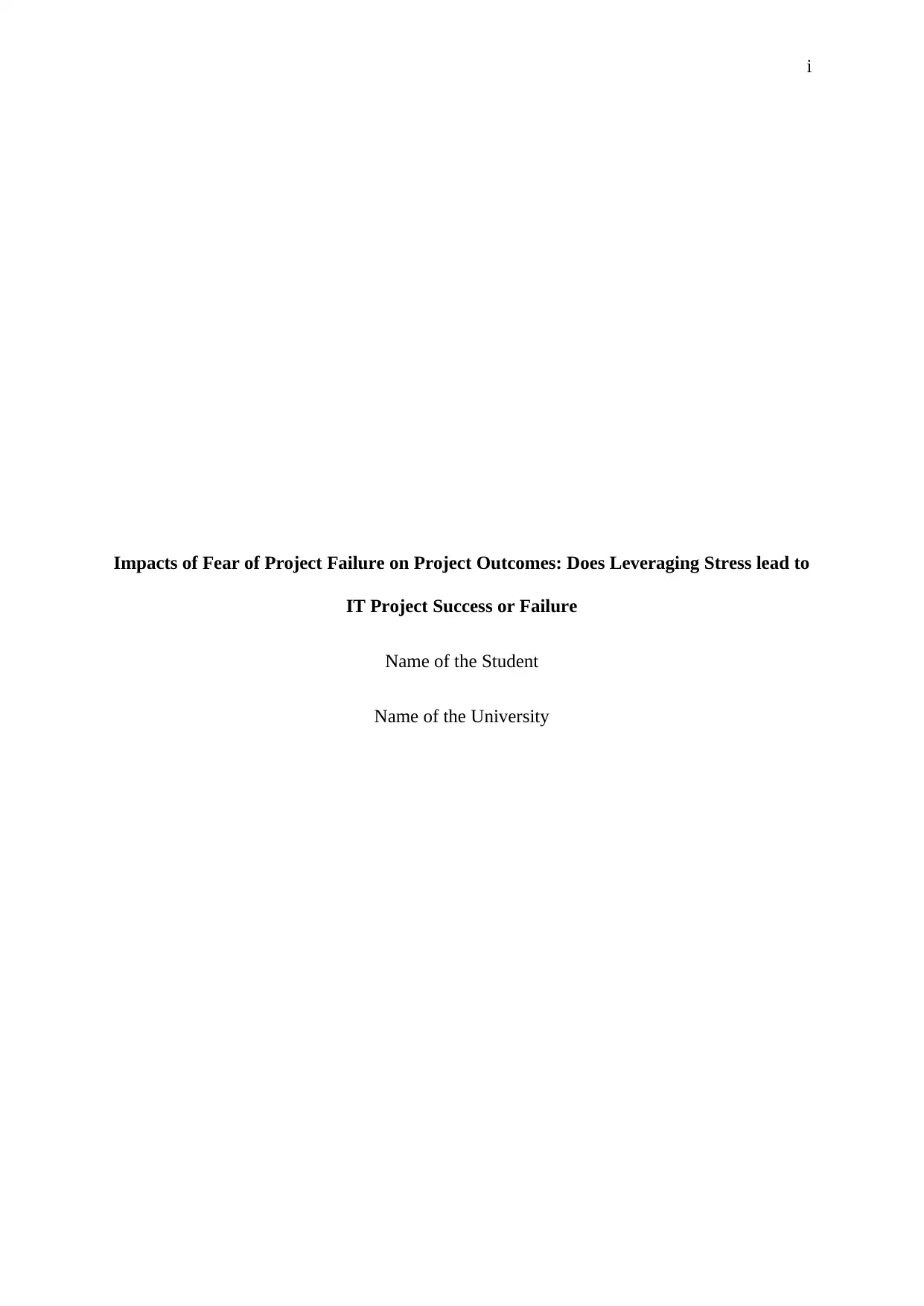
Impacts of Fear of Project Failure on Project Outcomes: Does Leveraging Stress lead to
IT Project Success or Failure
Name of the Student
Name of the University
Paraphrase This Document

Abstract
The global business and commercial scenario, over the years, have developed considerably
and have also undergone huge dynamics and in the recent period, international phenomena of
utmost importance, like that of Globalisation, trade liberalisation as well as technological and
infrastructural innovations have cumulatively led to the creation of a more integrated,
inclusive and interconnected global marketplace. The Information Technology have been
growing impressively and expansively, which in turn has led to increase complexities and
dynamics in the projects and activities in these industries. This in turn, has resulted in
workplace burdens, pressures and also considerable amount of stress among the employees,
especially the ones associated with the projects of the concerned industries.
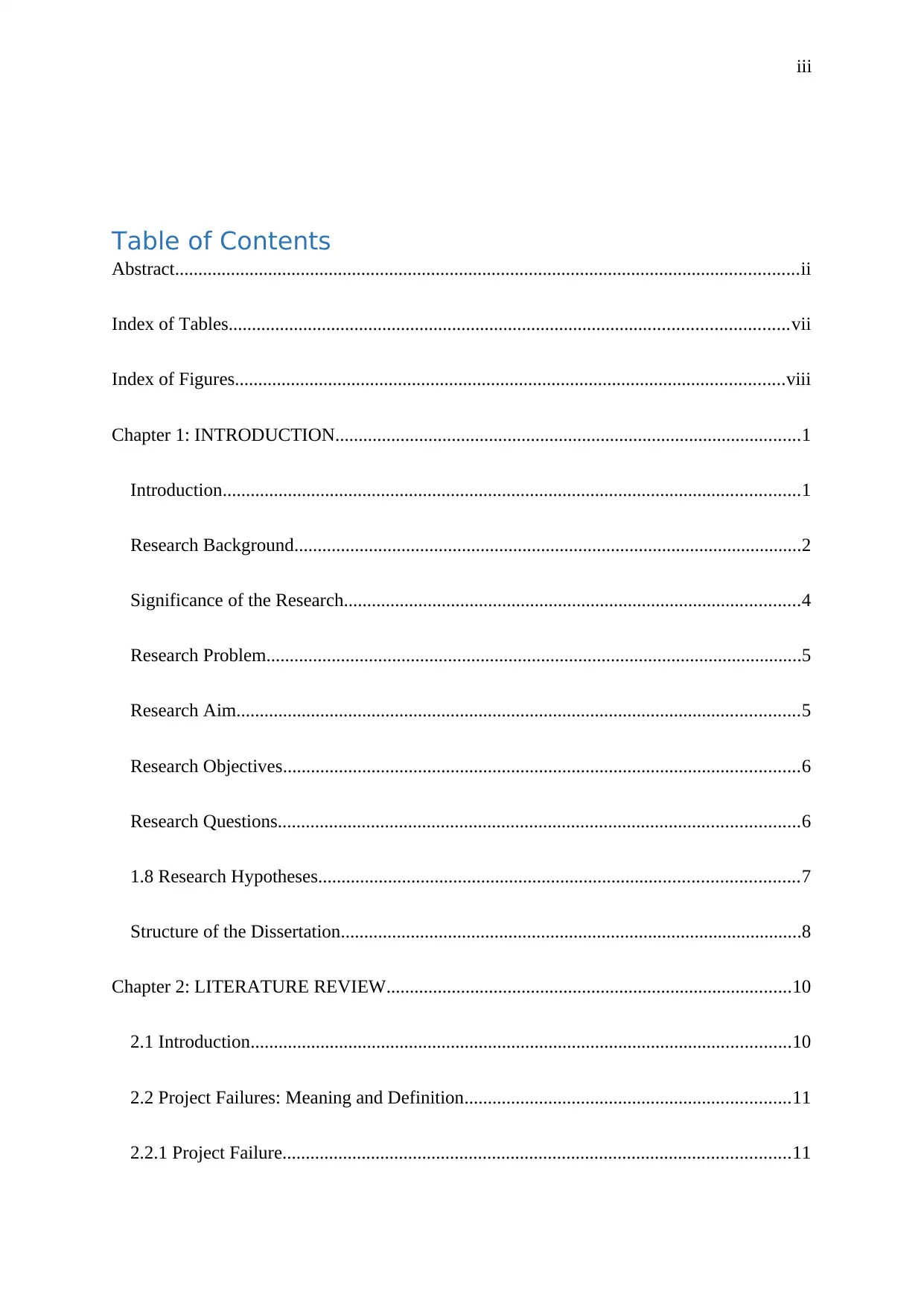
Table of Contents
Abstract......................................................................................................................................ii
Index of Tables........................................................................................................................vii
Index of Figures......................................................................................................................viii
Chapter 1: INTRODUCTION....................................................................................................1
Introduction............................................................................................................................1
Research Background.............................................................................................................2
Significance of the Research..................................................................................................4
Research Problem...................................................................................................................5
Research Aim.........................................................................................................................5
Research Objectives...............................................................................................................6
Research Questions................................................................................................................6
1.8 Research Hypotheses.......................................................................................................7
Structure of the Dissertation...................................................................................................8
Chapter 2: LITERATURE REVIEW.......................................................................................10
2.1 Introduction....................................................................................................................10
2.2 Project Failures: Meaning and Definition......................................................................11
2.2.1 Project Failure.............................................................................................................11
You're viewing a preview
Unlock full access by subscribing today!
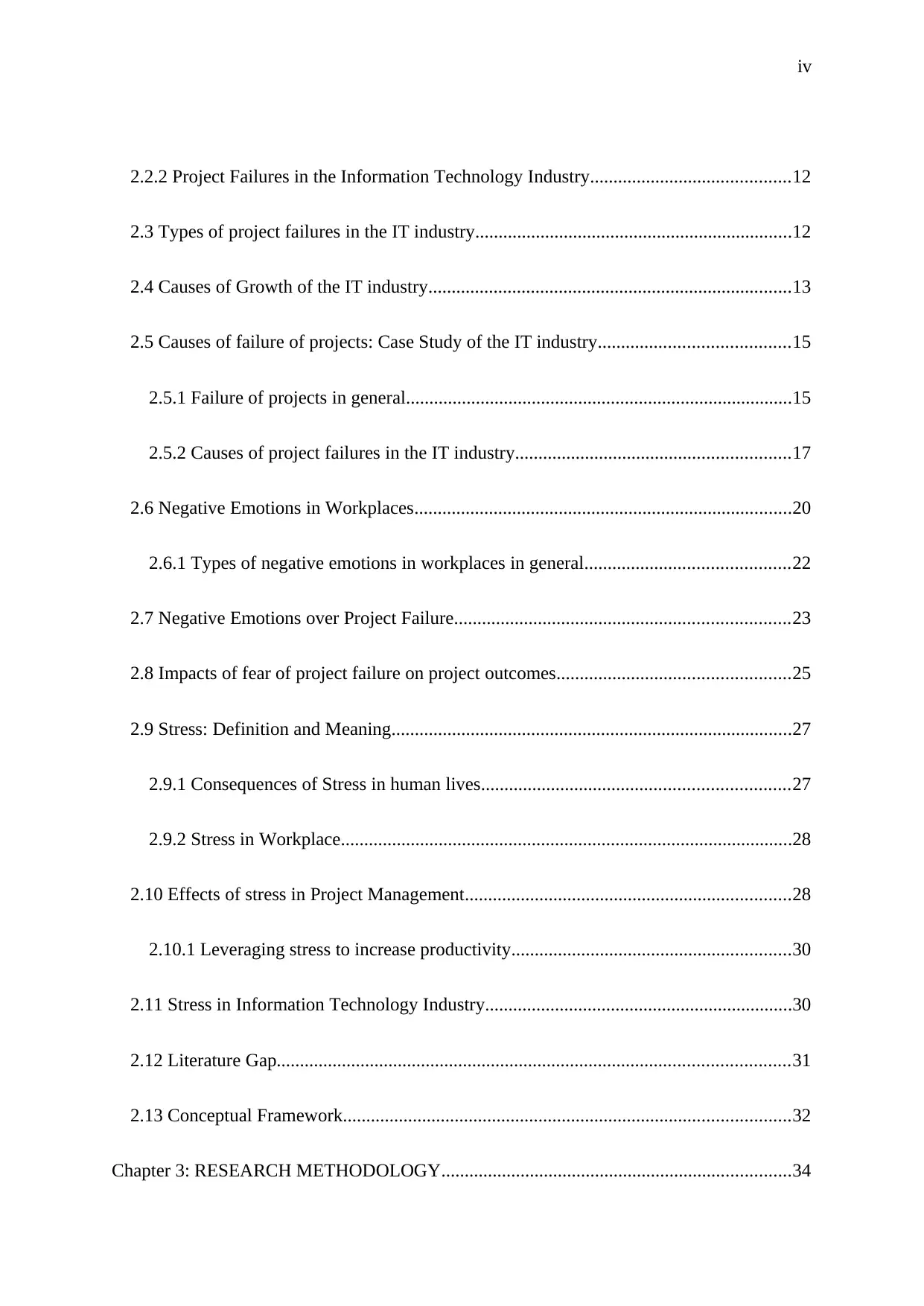
2.2.2 Project Failures in the Information Technology Industry...........................................12
2.3 Types of project failures in the IT industry....................................................................12
2.4 Causes of Growth of the IT industry..............................................................................13
2.5 Causes of failure of projects: Case Study of the IT industry.........................................15
2.5.1 Failure of projects in general...................................................................................15
2.5.2 Causes of project failures in the IT industry...........................................................17
2.6 Negative Emotions in Workplaces.................................................................................20
2.6.1 Types of negative emotions in workplaces in general............................................22
2.7 Negative Emotions over Project Failure........................................................................23
2.8 Impacts of fear of project failure on project outcomes..................................................25
2.9 Stress: Definition and Meaning......................................................................................27
2.9.1 Consequences of Stress in human lives..................................................................27
2.9.2 Stress in Workplace.................................................................................................28
2.10 Effects of stress in Project Management......................................................................28
2.10.1 Leveraging stress to increase productivity............................................................30
2.11 Stress in Information Technology Industry..................................................................30
2.12 Literature Gap..............................................................................................................31
2.13 Conceptual Framework................................................................................................32
Chapter 3: RESEARCH METHODOLOGY...........................................................................34
Paraphrase This Document

3.0 Introduction....................................................................................................................34
3.1 Research Proposition......................................................................................................34
3.2 Research Framework......................................................................................................34
3.3 Research Philosophy......................................................................................................35
3.4 Research Design.............................................................................................................36
3.5 Research Approach........................................................................................................37
3.6 Research Hypotheses.....................................................................................................39
3.7 Data Types, Collection and Analysis.............................................................................39
3.7.1 Data Type................................................................................................................39
3.7.2 Data Collection Methods.........................................................................................40
3.7.3 Sample Selection and Sample Size.........................................................................41
3.7.4 Data Analysis..........................................................................................................42
3.8 Ethical Consideration.....................................................................................................43
3.9 Research Limitations......................................................................................................44
Chapter 4: DATA ANALYSIS................................................................................................46
4.1 Introduction....................................................................................................................46
4.2 Quantitative Data Analysis............................................................................................46
4.2.1 Demographic Characteristics of the selected respondents......................................47
4.2.2 Work experience and project handling experience of the respondents...................49
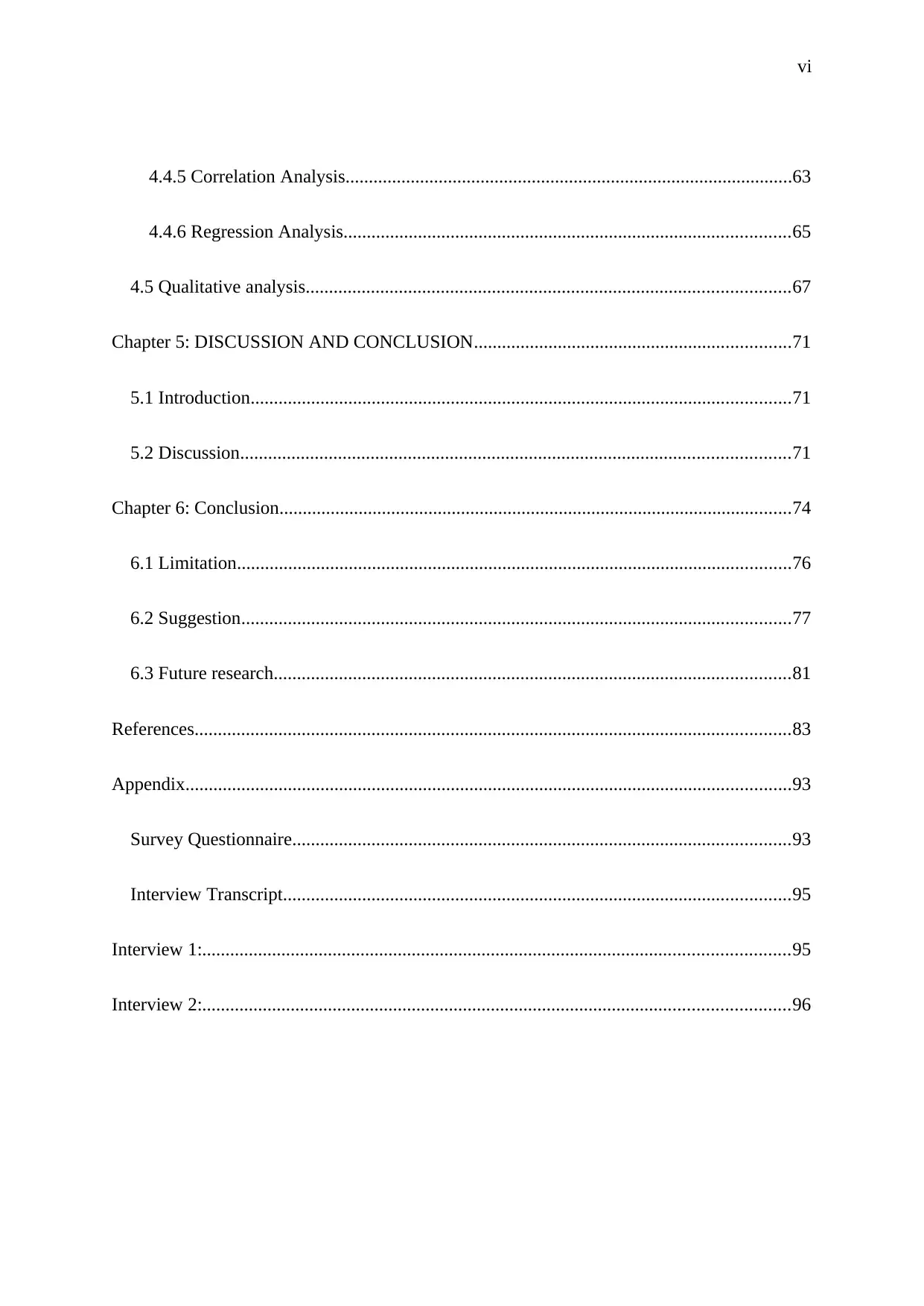
4.4.5 Correlation Analysis................................................................................................63
4.4.6 Regression Analysis................................................................................................65
4.5 Qualitative analysis........................................................................................................67
Chapter 5: DISCUSSION AND CONCLUSION....................................................................71
5.1 Introduction....................................................................................................................71
5.2 Discussion......................................................................................................................71
Chapter 6: Conclusion..............................................................................................................74
6.1 Limitation.......................................................................................................................76
6.2 Suggestion......................................................................................................................77
6.3 Future research...............................................................................................................81
References................................................................................................................................83
Appendix..................................................................................................................................93
Survey Questionnaire...........................................................................................................93
Interview Transcript.............................................................................................................95
Interview 1:..............................................................................................................................95
Interview 2:..............................................................................................................................96
You're viewing a preview
Unlock full access by subscribing today!

Index of Tables
Table 1: Types of project failures (Especially in the IT industries).........................................13
Table 2: You have succeeded in most of your projects.............................................52
Table 3: Negative emotions are common in managing projects..............................54
Table 4: You often experience the fear of failure of projects you handle..............55
Table 5: You feel high level of stress in handling the projects................................57
Table 6: Fear of failure motivates you to work harder......................................................58
Table 7: Fear of failure hampers the outcome of your projects.......................................59
Table 8: High level of stress leads to higher productivity.................................................61
Table 9: High stress hampers the outcome of the projects handled by you.................62
Table 10: Correlation Analysis of the different study variables..............................................64
Table 11: Regression Analysis.................................................................................................66
Table 12: ANOVA Table.........................................................................................................66
Table 13: Coefficients..............................................................................................................66
Paraphrase This Document
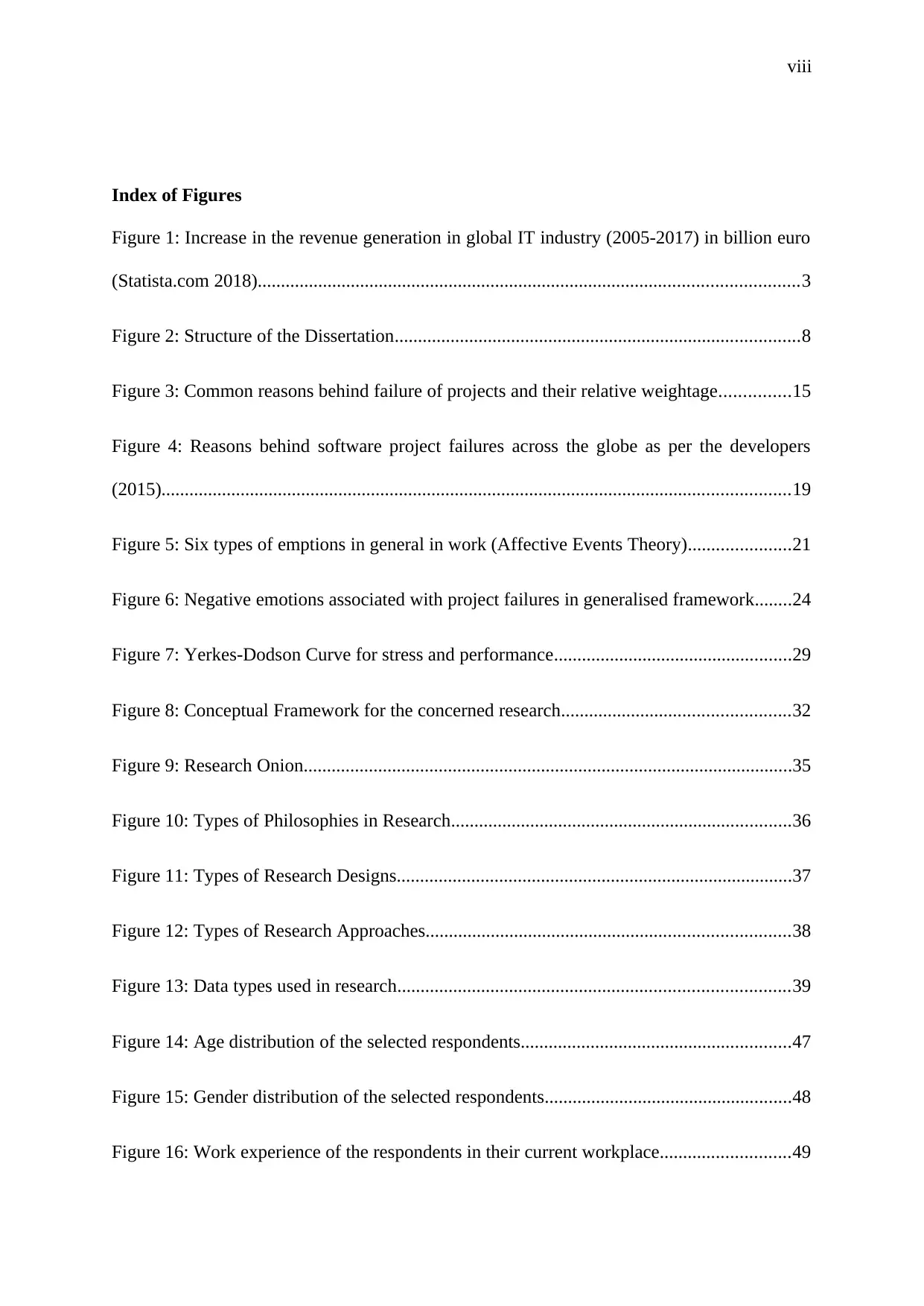
Index of Figures
Figure 1: Increase in the revenue generation in global IT industry (2005-2017) in billion euro
(Statista.com 2018)....................................................................................................................3
Figure 2: Structure of the Dissertation.......................................................................................8
Figure 3: Common reasons behind failure of projects and their relative weightage...............15
Figure 4: Reasons behind software project failures across the globe as per the developers
(2015).......................................................................................................................................19
Figure 5: Six types of emptions in general in work (Affective Events Theory)......................21
Figure 6: Negative emotions associated with project failures in generalised framework........24
Figure 7: Yerkes-Dodson Curve for stress and performance...................................................29
Figure 8: Conceptual Framework for the concerned research.................................................32
Figure 9: Research Onion.........................................................................................................35
Figure 10: Types of Philosophies in Research.........................................................................36
Figure 11: Types of Research Designs.....................................................................................37
Figure 12: Types of Research Approaches..............................................................................38
Figure 13: Data types used in research....................................................................................39
Figure 14: Age distribution of the selected respondents..........................................................47
Figure 15: Gender distribution of the selected respondents.....................................................48
Figure 16: Work experience of the respondents in their current workplace............................49
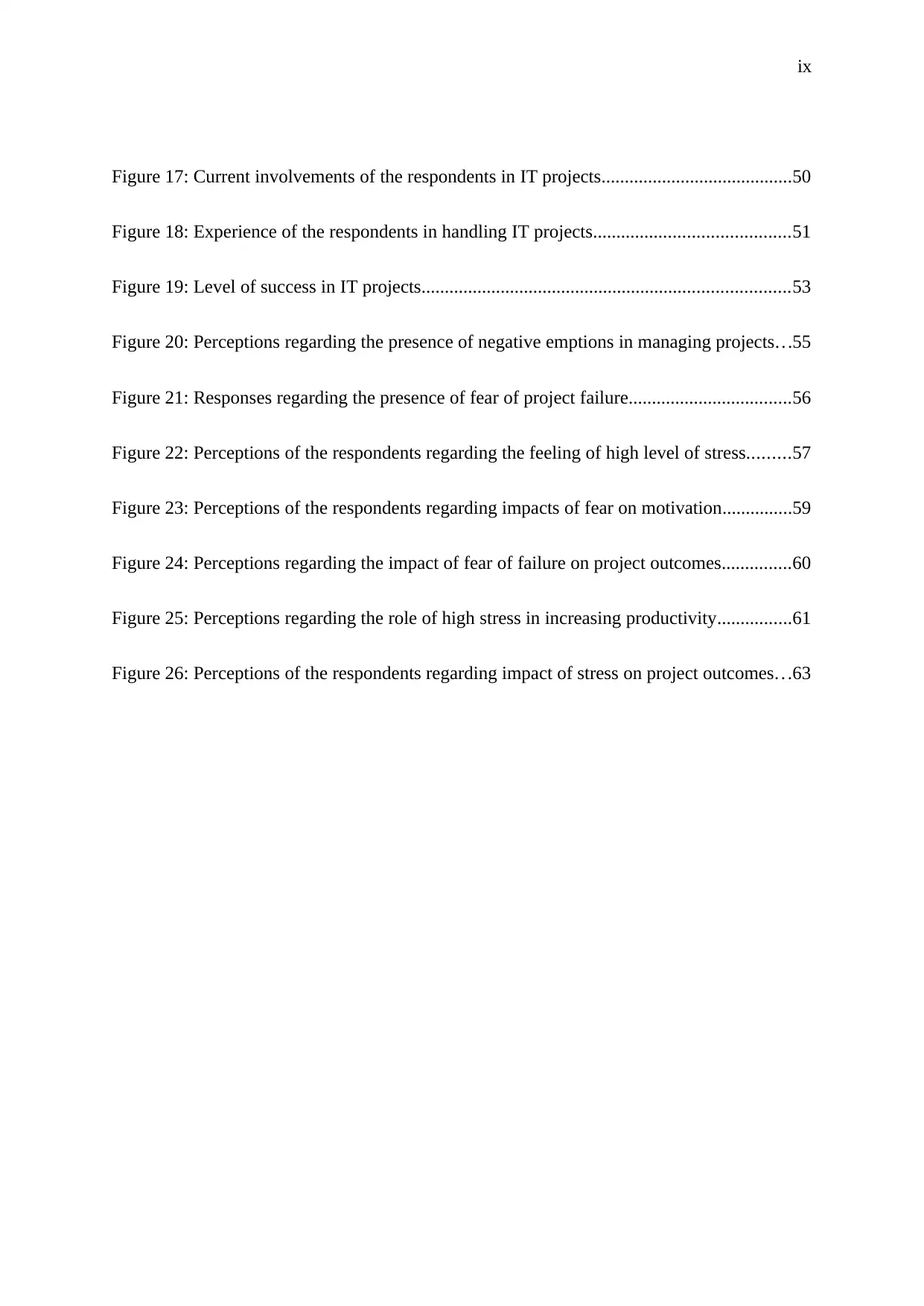
Figure 17: Current involvements of the respondents in IT projects.........................................50
Figure 18: Experience of the respondents in handling IT projects..........................................51
Figure 19: Level of success in IT projects...............................................................................53
Figure 20: Perceptions regarding the presence of negative emptions in managing projects...55
Figure 21: Responses regarding the presence of fear of project failure...................................56
Figure 22: Perceptions of the respondents regarding the feeling of high level of stress.........57
Figure 23: Perceptions of the respondents regarding impacts of fear on motivation...............59
Figure 24: Perceptions regarding the impact of fear of failure on project outcomes...............60
Figure 25: Perceptions regarding the role of high stress in increasing productivity................61
Figure 26: Perceptions of the respondents regarding impact of stress on project outcomes. . .63
You're viewing a preview
Unlock full access by subscribing today!

Paraphrase This Document
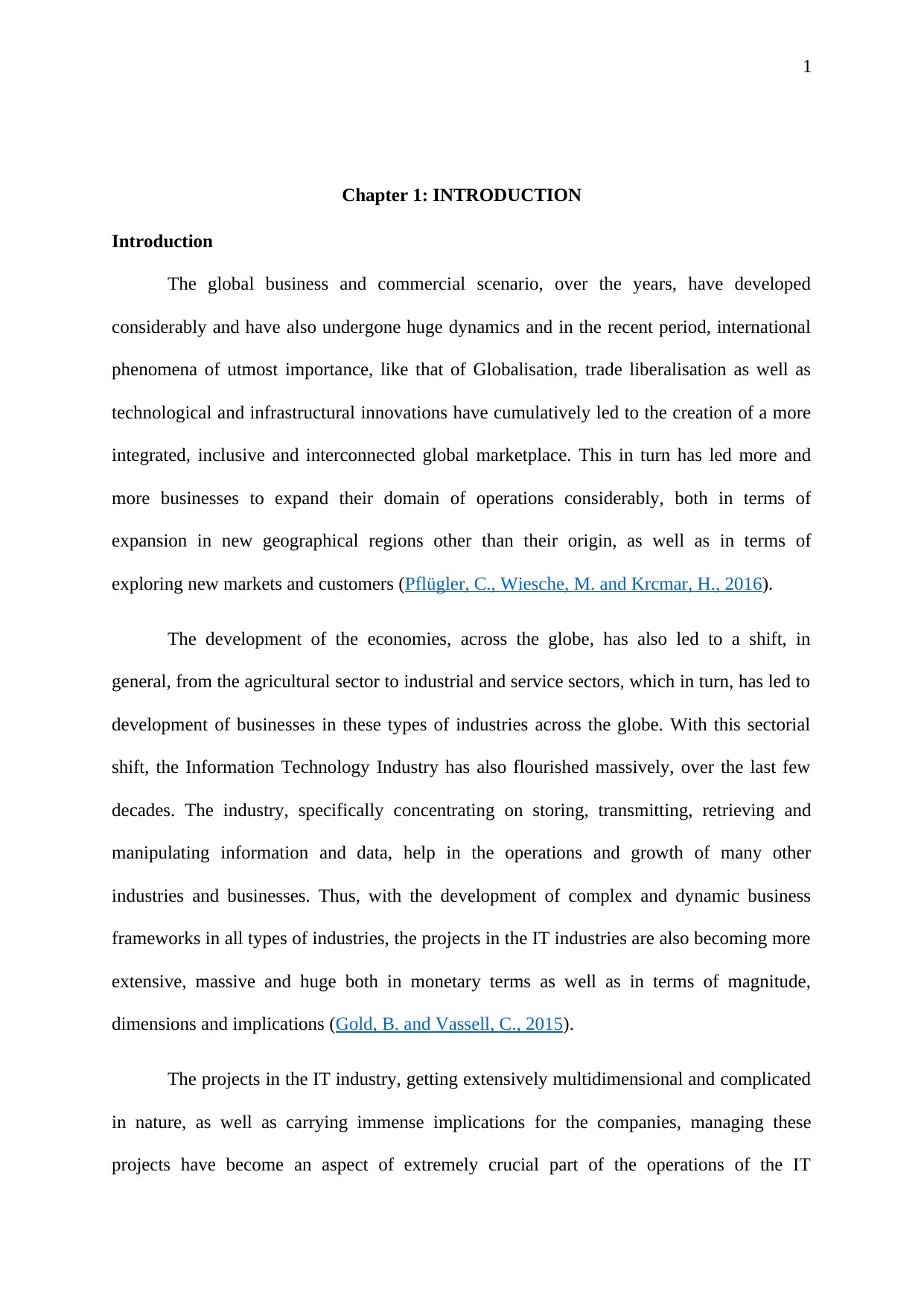
Chapter 1: INTRODUCTION
Introduction
The global business and commercial scenario, over the years, have developed
considerably and have also undergone huge dynamics and in the recent period, international
phenomena of utmost importance, like that of Globalisation, trade liberalisation as well as
technological and infrastructural innovations have cumulatively led to the creation of a more
integrated, inclusive and interconnected global marketplace. This in turn has led more and
more businesses to expand their domain of operations considerably, both in terms of
expansion in new geographical regions other than their origin, as well as in terms of
exploring new markets and customers (Pflügler, C., Wiesche, M. and Krcmar, H., 2016).
The development of the economies, across the globe, has also led to a shift, in
general, from the agricultural sector to industrial and service sectors, which in turn, has led to
development of businesses in these types of industries across the globe. With this sectorial
shift, the Information Technology Industry has also flourished massively, over the last few
decades. The industry, specifically concentrating on storing, transmitting, retrieving and
manipulating information and data, help in the operations and growth of many other
industries and businesses. Thus, with the development of complex and dynamic business
frameworks in all types of industries, the projects in the IT industries are also becoming more
extensive, massive and huge both in monetary terms as well as in terms of magnitude,
dimensions and implications (Gold, B. and Vassell, C., 2015).
The projects in the IT industry, getting extensively multidimensional and complicated
in nature, as well as carrying immense implications for the companies, managing these
projects have become an aspect of extremely crucial part of the operations of the IT

companies and the people bestowed with the responsibilities to manage these projects can be
seen to be experiencing stress and burden at an alarming rate (Taherdoost, H. and
Keshavarzsaleh, A., 2015). There also exist considerable tension and fear among the relevant
personnel, regarding the failure of the projects as the same have immense negative aftermath,
affecting the companies as well as the associated employees. Often the IT companies, use
stress as an option to increase the efforts and efficiencies of the employees, which in turn, can
also have considerable impacts on the employees themselves as well as on the projects which
they are associated with (Giardino, C., Wang, X. and Abrahamsson, P., 2014).
Keeping the above discussion into consideration, the concerned research tries to analyse
the different aspects which lead to project failure, specifically in the IT industries,
specifically emphasizing on the impacts which the fear of the officials, regarding the failure
of the projects, on the outcomes of the same. The research paper also tries to analyse whether
the common practice of leveraging stress as a tool to increase employee outputs, production
and efficiency leads to success or failure of the projects in the concerned industry, thereby
examining the relationship between emotions and stress on employee performance and
project outcomes in the IT industries (Dodson, L.L., Sterling, S. and Bennett, J.K., 2012).
Research Background
As discussed in the above section, the IT industry, across the globe, has been expanding
immensely, over the decades, both in terms of business revenue generation as well as in terms
of the areas where they venture and their domain of operations. The expansion of the industry
and the businesses in the same, can be seen from the following figure:
You're viewing a preview
Unlock full access by subscribing today!
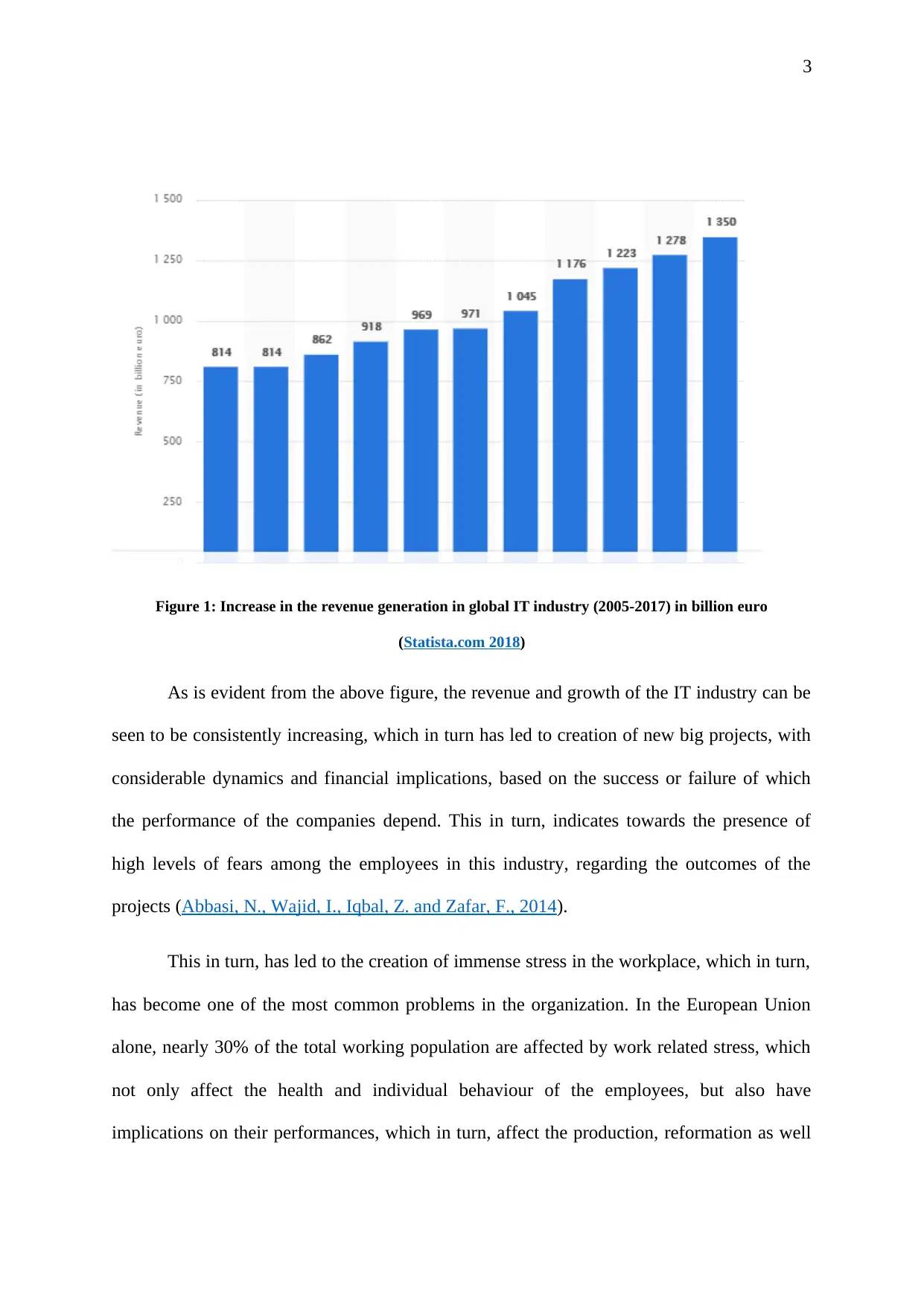
Figure 1: Increase in the revenue generation in global IT industry (2005-2017) in billion euro
(Statista.com 2018)
As is evident from the above figure, the revenue and growth of the IT industry can be
seen to be consistently increasing, which in turn has led to creation of new big projects, with
considerable dynamics and financial implications, based on the success or failure of which
the performance of the companies depend. This in turn, indicates towards the presence of
high levels of fears among the employees in this industry, regarding the outcomes of the
projects (Abbasi, N., Wajid, I., Iqbal, Z. and Zafar, F., 2014).
This in turn, has led to the creation of immense stress in the workplace, which in turn,
has become one of the most common problems in the organization. In the European Union
alone, nearly 30% of the total working population are affected by work related stress, which
not only affect the health and individual behaviour of the employees, but also have
implications on their performances, which in turn, affect the production, reformation as well
Paraphrase This Document
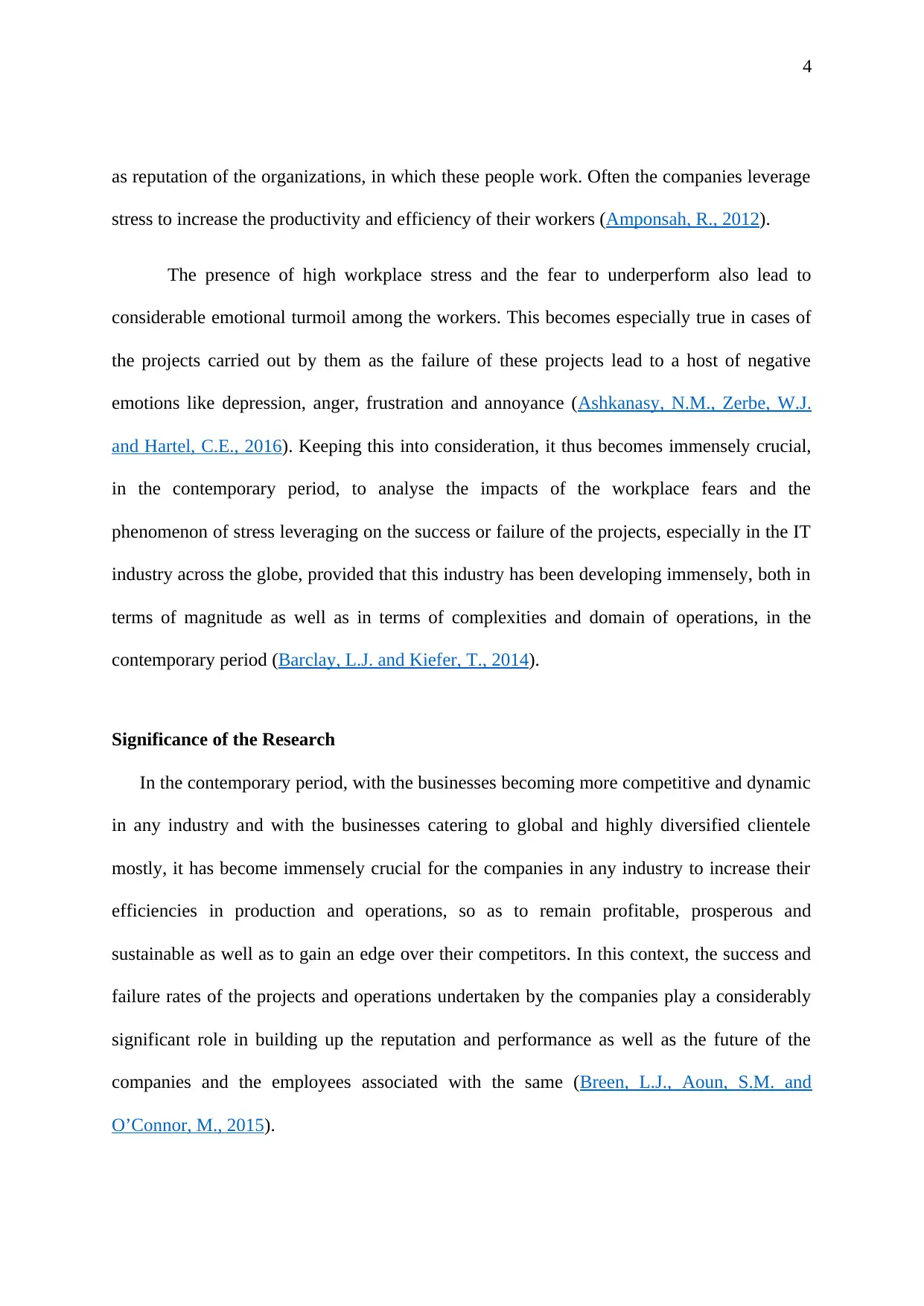
as reputation of the organizations, in which these people work. Often the companies leverage
stress to increase the productivity and efficiency of their workers (Amponsah, R., 2012).
The presence of high workplace stress and the fear to underperform also lead to
considerable emotional turmoil among the workers. This becomes especially true in cases of
the projects carried out by them as the failure of these projects lead to a host of negative
emotions like depression, anger, frustration and annoyance (Ashkanasy, N.M., Zerbe, W.J.
and Hartel, C.E., 2016). Keeping this into consideration, it thus becomes immensely crucial,
in the contemporary period, to analyse the impacts of the workplace fears and the
phenomenon of stress leveraging on the success or failure of the projects, especially in the IT
industry across the globe, provided that this industry has been developing immensely, both in
terms of magnitude as well as in terms of complexities and domain of operations, in the
contemporary period (Barclay, L.J. and Kiefer, T., 2014).
Significance of the Research
In the contemporary period, with the businesses becoming more competitive and dynamic
in any industry and with the businesses catering to global and highly diversified clientele
mostly, it has become immensely crucial for the companies in any industry to increase their
efficiencies in production and operations, so as to remain profitable, prosperous and
sustainable as well as to gain an edge over their competitors. In this context, the success and
failure rates of the projects and operations undertaken by the companies play a considerably
significant role in building up the reputation and performance as well as the future of the
companies and the employees associated with the same (Breen, L.J., Aoun, S.M. and
O’Connor, M., 2015).
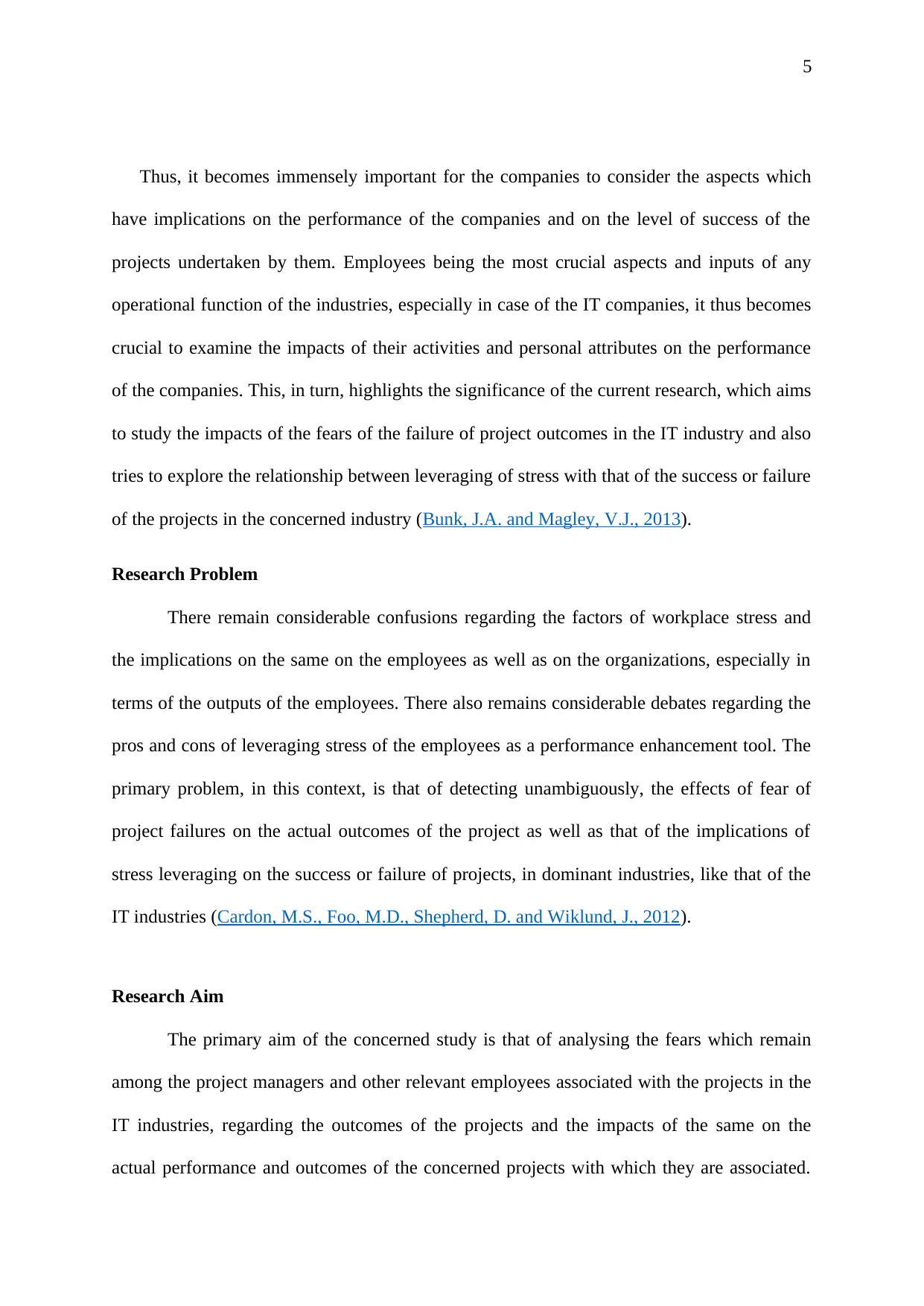
Thus, it becomes immensely important for the companies to consider the aspects which
have implications on the performance of the companies and on the level of success of the
projects undertaken by them. Employees being the most crucial aspects and inputs of any
operational function of the industries, especially in case of the IT companies, it thus becomes
crucial to examine the impacts of their activities and personal attributes on the performance
of the companies. This, in turn, highlights the significance of the current research, which aims
to study the impacts of the fears of the failure of project outcomes in the IT industry and also
tries to explore the relationship between leveraging of stress with that of the success or failure
of the projects in the concerned industry (Bunk, J.A. and Magley, V.J., 2013).
Research Problem
There remain considerable confusions regarding the factors of workplace stress and
the implications on the same on the employees as well as on the organizations, especially in
terms of the outputs of the employees. There also remains considerable debates regarding the
pros and cons of leveraging stress of the employees as a performance enhancement tool. The
primary problem, in this context, is that of detecting unambiguously, the effects of fear of
project failures on the actual outcomes of the project as well as that of the implications of
stress leveraging on the success or failure of projects, in dominant industries, like that of the
IT industries (Cardon, M.S., Foo, M.D., Shepherd, D. and Wiklund, J., 2012).
Research Aim
The primary aim of the concerned study is that of analysing the fears which remain
among the project managers and other relevant employees associated with the projects in the
IT industries, regarding the outcomes of the projects and the impacts of the same on the
actual performance and outcomes of the concerned projects with which they are associated.
You're viewing a preview
Unlock full access by subscribing today!
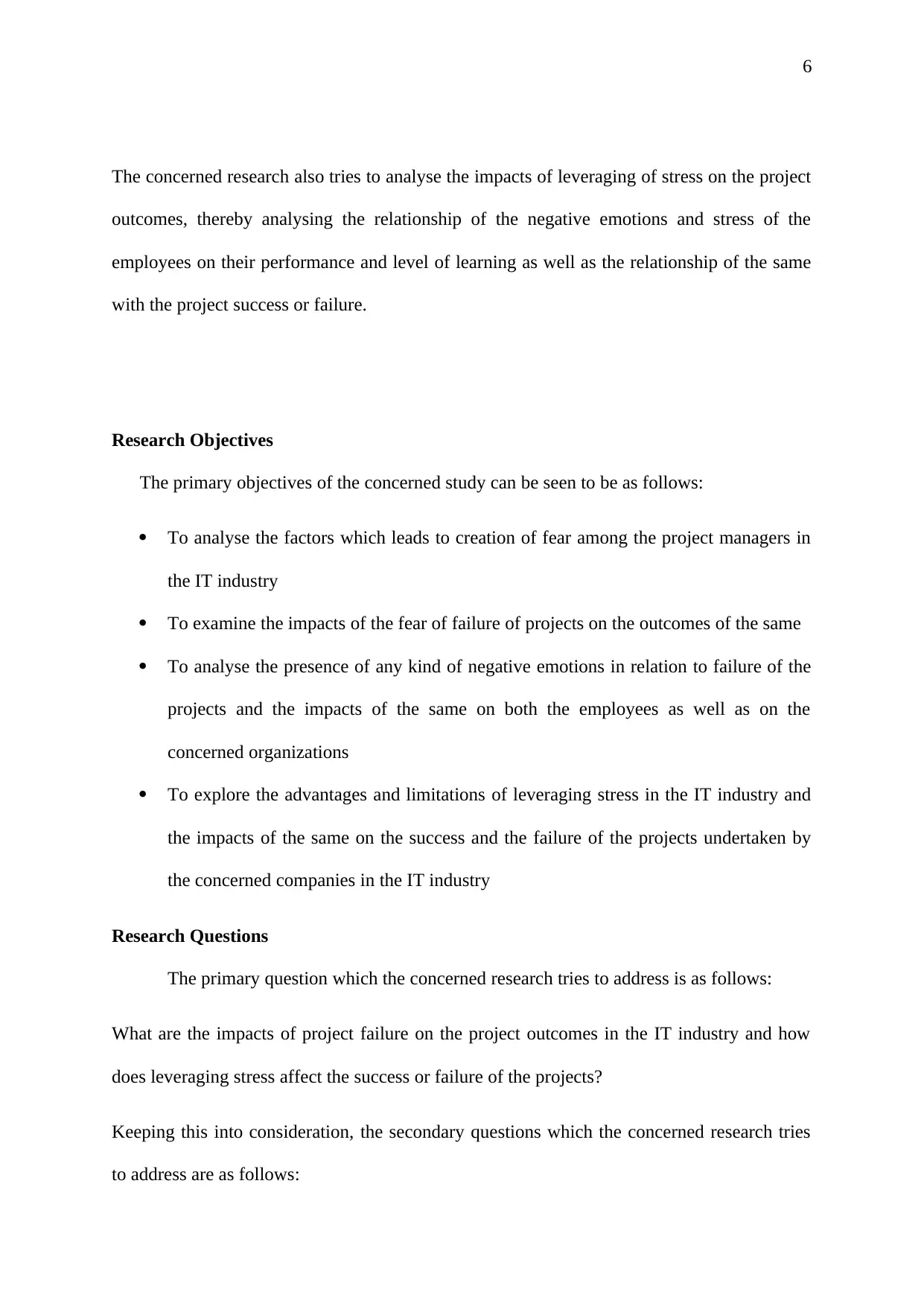
The concerned research also tries to analyse the impacts of leveraging of stress on the project
outcomes, thereby analysing the relationship of the negative emotions and stress of the
employees on their performance and level of learning as well as the relationship of the same
with the project success or failure.
Research Objectives
The primary objectives of the concerned study can be seen to be as follows:
To analyse the factors which leads to creation of fear among the project managers in
the IT industry
To examine the impacts of the fear of failure of projects on the outcomes of the same
To analyse the presence of any kind of negative emotions in relation to failure of the
projects and the impacts of the same on both the employees as well as on the
concerned organizations
To explore the advantages and limitations of leveraging stress in the IT industry and
the impacts of the same on the success and the failure of the projects undertaken by
the concerned companies in the IT industry
Research Questions
The primary question which the concerned research tries to address is as follows:
What are the impacts of project failure on the project outcomes in the IT industry and how
does leveraging stress affect the success or failure of the projects?
Keeping this into consideration, the secondary questions which the concerned research tries
to address are as follows:
Paraphrase This Document
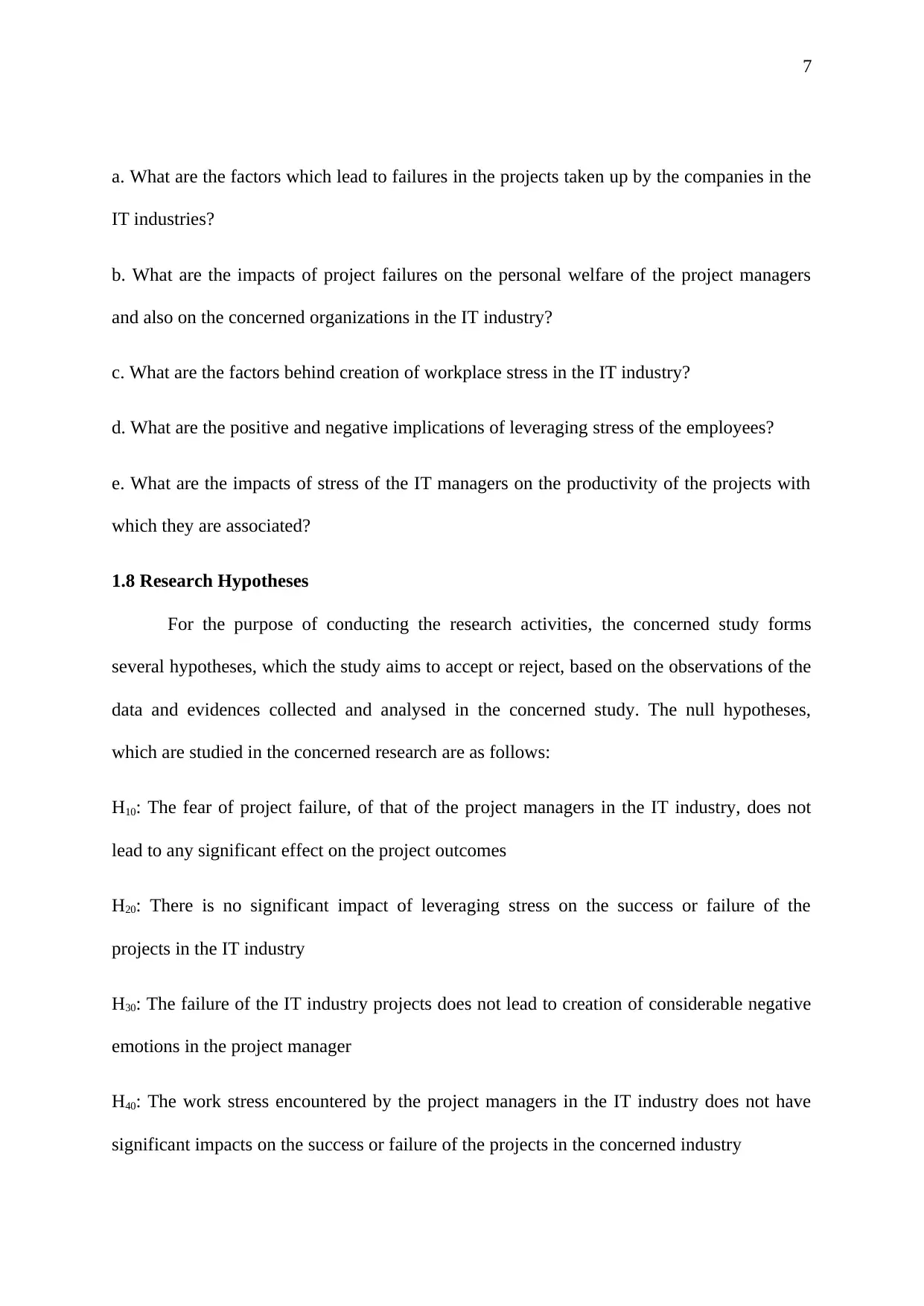
a. What are the factors which lead to failures in the projects taken up by the companies in the
IT industries?
b. What are the impacts of project failures on the personal welfare of the project managers
and also on the concerned organizations in the IT industry?
c. What are the factors behind creation of workplace stress in the IT industry?
d. What are the positive and negative implications of leveraging stress of the employees?
e. What are the impacts of stress of the IT managers on the productivity of the projects with
which they are associated?
1.8 Research Hypotheses
For the purpose of conducting the research activities, the concerned study forms
several hypotheses, which the study aims to accept or reject, based on the observations of the
data and evidences collected and analysed in the concerned study. The null hypotheses,
which are studied in the concerned research are as follows:
H10: The fear of project failure, of that of the project managers in the IT industry, does not
lead to any significant effect on the project outcomes
H20: There is no significant impact of leveraging stress on the success or failure of the
projects in the IT industry
H30: The failure of the IT industry projects does not lead to creation of considerable negative
emotions in the project manager
H40: The work stress encountered by the project managers in the IT industry does not have
significant impacts on the success or failure of the projects in the concerned industry

Structure of the Dissertation
The dissertation has been organized and constructed in a framework consisting of six
chapters, which are serially shown as follows:
Figure 2: Structure of the Dissertation
(As created by the author)
As is evident from the above figure, the first chapter of the dissertation gives a brief
introduction of the area of interest of the concerned research, thereby discussing the
significance of the research, the aims, objectives of the same and the questions which the
same intends to address. This is followed by an extensive review of the existing literary
works and empirically supported scholarly evidences, which exist in the domain of the area
of research, so as to capture the perceptions and opinions which exist in this domain
(Castells, M., 2014). The third chapter highlights and elaborately discusses the research
methodological framework, including the approaches and designs used for the research and
You're viewing a preview
Unlock full access by subscribing today!

the tools and techniques used by the concerned study for the purpose of data collection,
analysis and interpretation. The analysis of the data collected is shown in the fourth chapter
followed by the elaborate interpretation and discussion of the same in the fifth chapter. Based
on the same, the final chapter of the dissertation consists of a brief conclusion, the summary
of the findings, the limitations and problems encountered while carrying out the concerned
research as well as recommendations both for improvement of future research scopes as well
as in the aspects of efficient handling of projects in the IT industries in the generalised
framework (Chu, L.C., 2014).
Paraphrase This Document
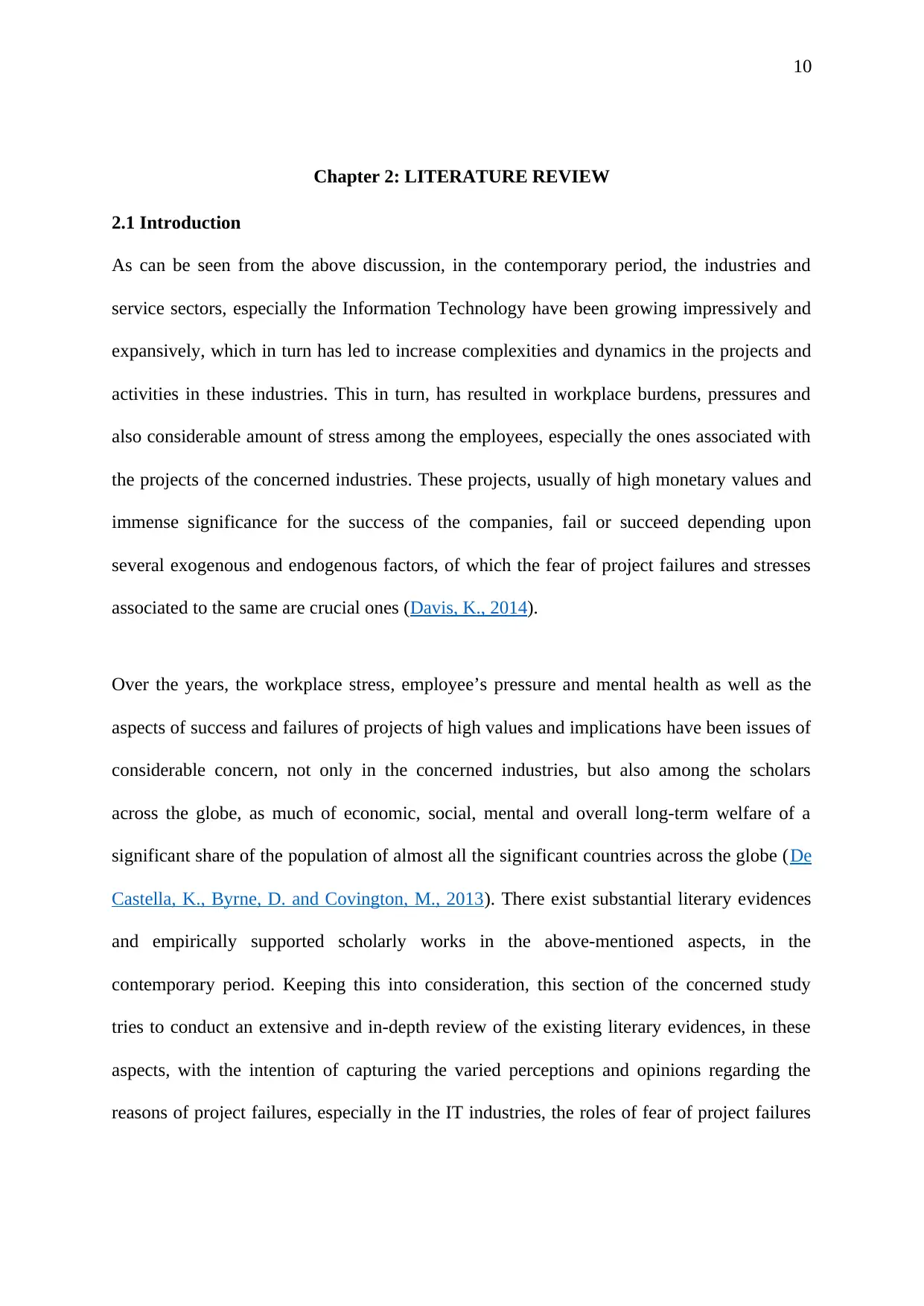
Chapter 2: LITERATURE REVIEW
2.1 Introduction
As can be seen from the above discussion, in the contemporary period, the industries and
service sectors, especially the Information Technology have been growing impressively and
expansively, which in turn has led to increase complexities and dynamics in the projects and
activities in these industries. This in turn, has resulted in workplace burdens, pressures and
also considerable amount of stress among the employees, especially the ones associated with
the projects of the concerned industries. These projects, usually of high monetary values and
immense significance for the success of the companies, fail or succeed depending upon
several exogenous and endogenous factors, of which the fear of project failures and stresses
associated to the same are crucial ones (Davis, K., 2014).
Over the years, the workplace stress, employee’s pressure and mental health as well as the
aspects of success and failures of projects of high values and implications have been issues of
considerable concern, not only in the concerned industries, but also among the scholars
across the globe, as much of economic, social, mental and overall long-term welfare of a
significant share of the population of almost all the significant countries across the globe (De
Castella, K., Byrne, D. and Covington, M., 2013). There exist substantial literary evidences
and empirically supported scholarly works in the above-mentioned aspects, in the
contemporary period. Keeping this into consideration, this section of the concerned study
tries to conduct an extensive and in-depth review of the existing literary evidences, in these
aspects, with the intention of capturing the varied perceptions and opinions regarding the
reasons of project failures, especially in the IT industries, the roles of fear of project failures

on the outcomes of the same, the impacts of stress leveraging on the outcome of the projects
and other aspects (Decker et al. 2012).
2.2 Project Failures: Meaning and Definition
The term “Failure”, is a multidimensional notion, which have been defined from various
perspectives by various scholars. In this context, The term “Failure”, to be a general lack of
success which an individual or a group of individuals or an organization experience in doing
something or in achieving some pre-formed goals, specifically in relation to any specific
activity. Failure as the phenomenon where an individual does not do something which he or
she is expected to do (Eden, R. and Sedera, D., 2014).
2.2.1 Project Failure
In the contemporary period, with the failure of projects in different industries, across the
globe, becoming an issue of severe concern, not only among the people associated in the
demand and supply side of the industries, but also the governments of different countries and
different scholars across the globe, various attempts have been taken to understand, explain
and define the concerned term. Any project (commercial, industrial, administrative or welfare
related), is, in a generalised framework, considered to be a failure when the same is not able
to deliver what is expected or required from the project (Fisher, C.D., Minbashian, A.,
Beckmann, N. and Wood, R.E., 2013).
In this context, while explaining the phenomenon of project failure in the business domains,
there are several aspects and components in any project, especially in the domains of
industries, business and commerce, as the same involves various stakeholders and associated
persons. According to the author, these components play crucial roles in determining the
You're viewing a preview
Unlock full access by subscribing today!
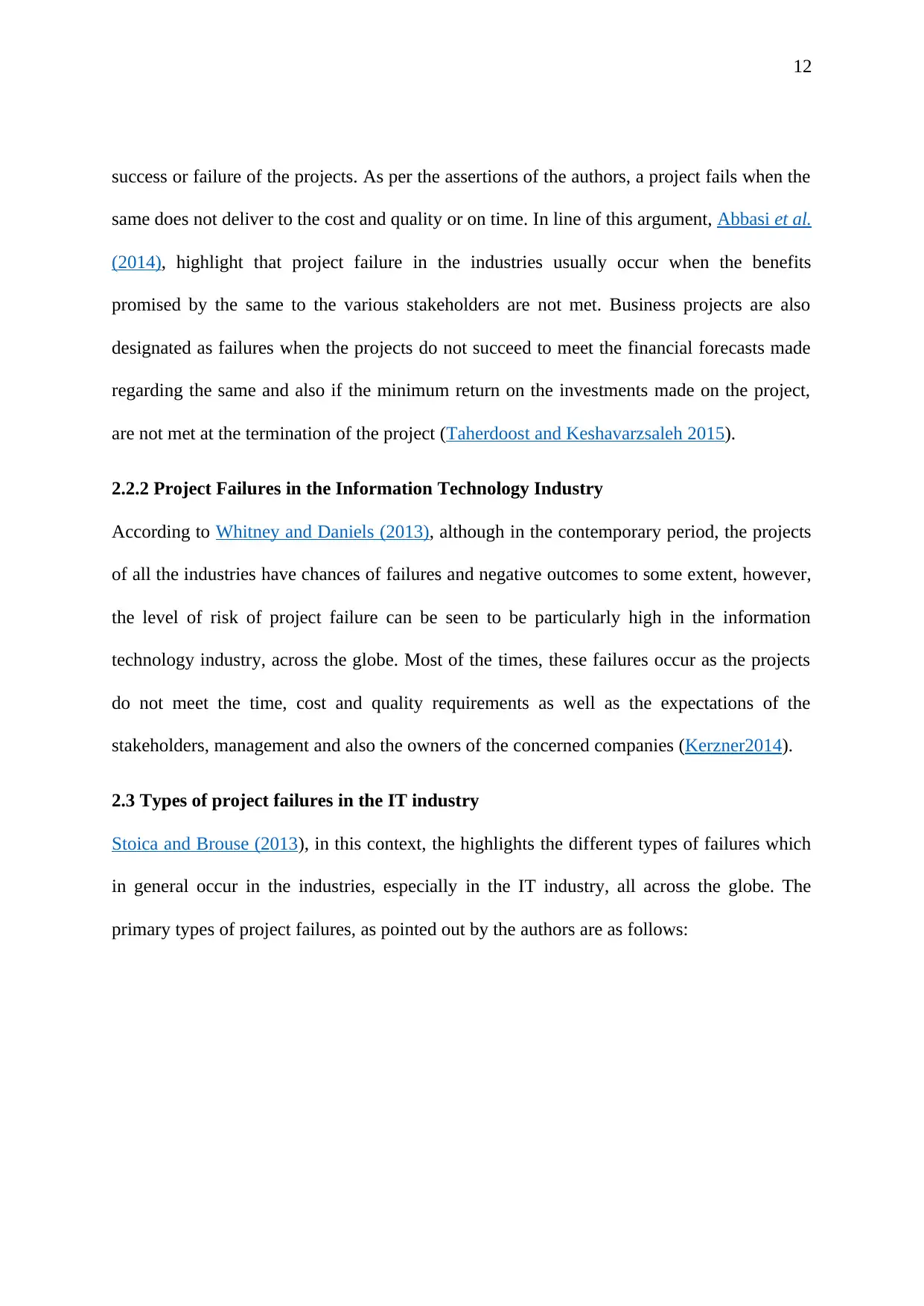
success or failure of the projects. As per the assertions of the authors, a project fails when the
same does not deliver to the cost and quality or on time. In line of this argument, Abbasi et al.
(2014), highlight that project failure in the industries usually occur when the benefits
promised by the same to the various stakeholders are not met. Business projects are also
designated as failures when the projects do not succeed to meet the financial forecasts made
regarding the same and also if the minimum return on the investments made on the project,
are not met at the termination of the project (Taherdoost and Keshavarzsaleh 2015).
2.2.2 Project Failures in the Information Technology Industry
According to Whitney and Daniels (2013), although in the contemporary period, the projects
of all the industries have chances of failures and negative outcomes to some extent, however,
the level of risk of project failure can be seen to be particularly high in the information
technology industry, across the globe. Most of the times, these failures occur as the projects
do not meet the time, cost and quality requirements as well as the expectations of the
stakeholders, management and also the owners of the concerned companies (Kerzner2014).
2.3 Types of project failures in the IT industry
Stoica and Brouse (2013), in this context, the highlights the different types of failures which
in general occur in the industries, especially in the IT industry, all across the globe. The
primary types of project failures, as pointed out by the authors are as follows:
Paraphrase This Document
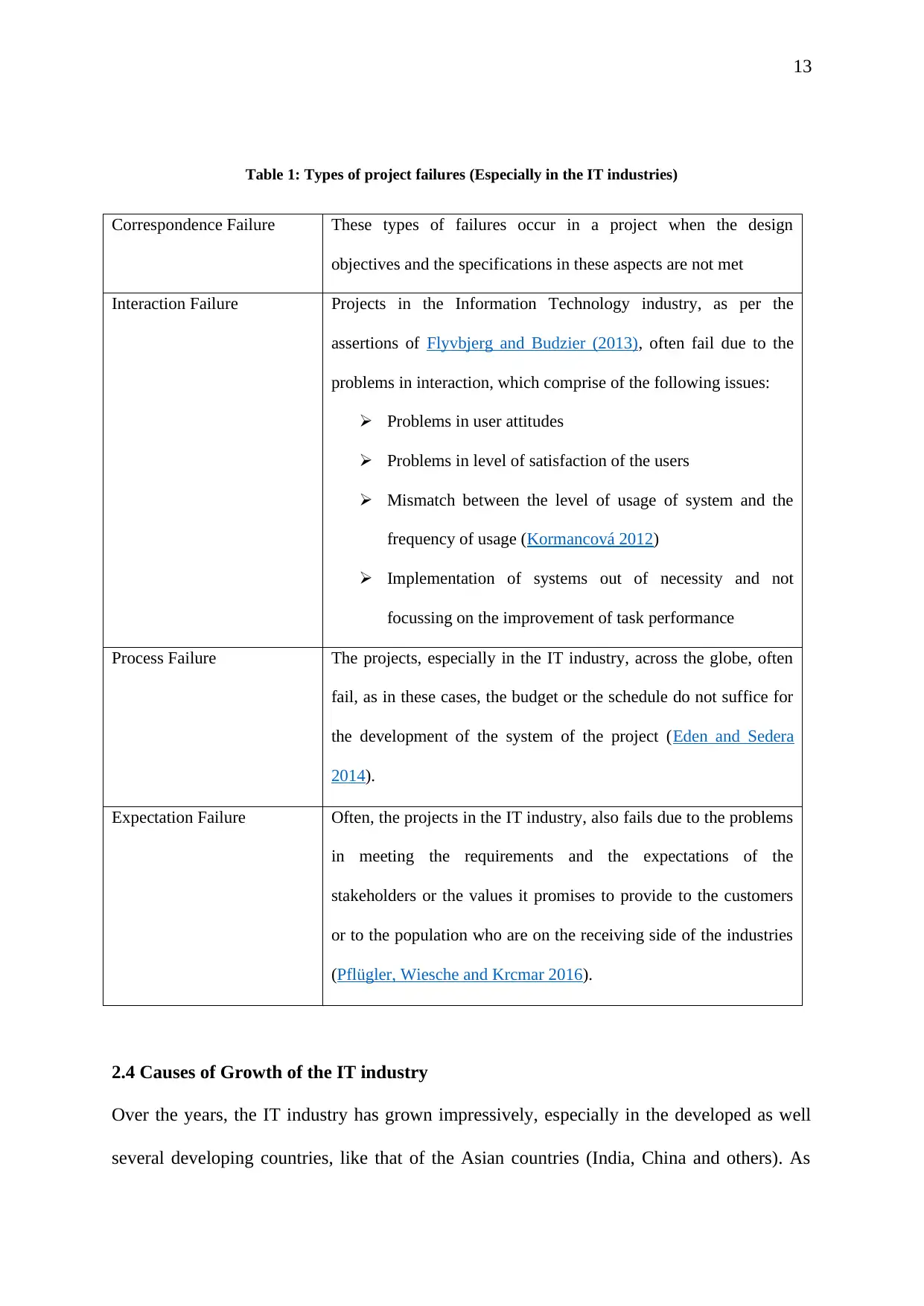
Table 1: Types of project failures (Especially in the IT industries)
Correspondence Failure These types of failures occur in a project when the design
objectives and the specifications in these aspects are not met
Interaction Failure Projects in the Information Technology industry, as per the
assertions of Flyvbjerg and Budzier (2013), often fail due to the
problems in interaction, which comprise of the following issues:
Problems in user attitudes
Problems in level of satisfaction of the users
Mismatch between the level of usage of system and the
frequency of usage (Kormancová 2012)
Implementation of systems out of necessity and not
focussing on the improvement of task performance
Process Failure The projects, especially in the IT industry, across the globe, often
fail, as in these cases, the budget or the schedule do not suffice for
the development of the system of the project (Eden and Sedera
2014).
Expectation Failure Often, the projects in the IT industry, also fails due to the problems
in meeting the requirements and the expectations of the
stakeholders or the values it promises to provide to the customers
or to the population who are on the receiving side of the industries
(Pflügler, Wiesche and Krcmar 2016).
2.4 Causes of Growth of the IT industry
Over the years, the IT industry has grown impressively, especially in the developed as well
several developing countries, like that of the Asian countries (India, China and others). As
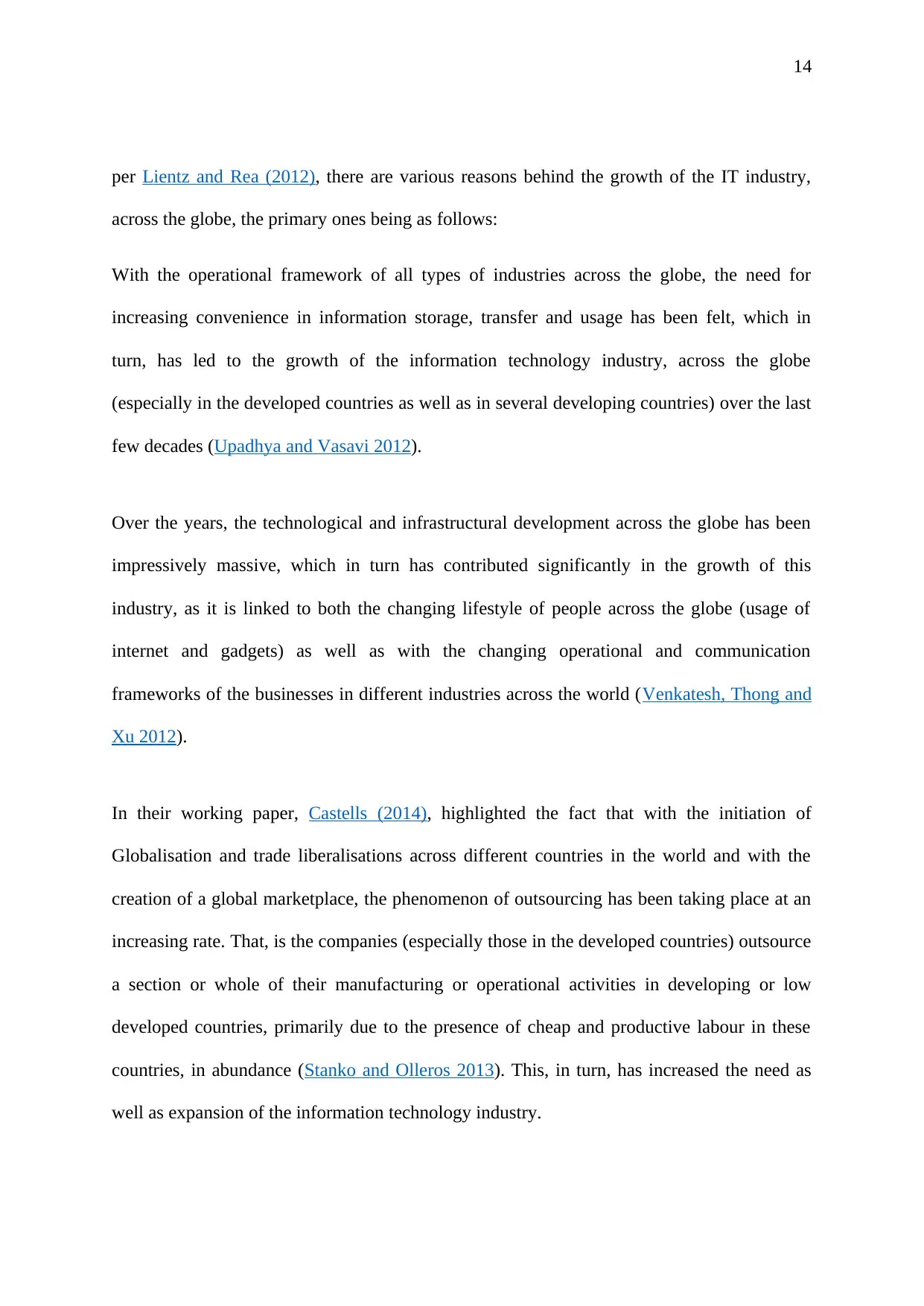
per Lientz and Rea (2012), there are various reasons behind the growth of the IT industry,
across the globe, the primary ones being as follows:
With the operational framework of all types of industries across the globe, the need for
increasing convenience in information storage, transfer and usage has been felt, which in
turn, has led to the growth of the information technology industry, across the globe
(especially in the developed countries as well as in several developing countries) over the last
few decades (Upadhya and Vasavi 2012).
Over the years, the technological and infrastructural development across the globe has been
impressively massive, which in turn has contributed significantly in the growth of this
industry, as it is linked to both the changing lifestyle of people across the globe (usage of
internet and gadgets) as well as with the changing operational and communication
frameworks of the businesses in different industries across the world (Venkatesh, Thong and
Xu 2012).
In their working paper, Castells (2014), highlighted the fact that with the initiation of
Globalisation and trade liberalisations across different countries in the world and with the
creation of a global marketplace, the phenomenon of outsourcing has been taking place at an
increasing rate. That, is the companies (especially those in the developed countries) outsource
a section or whole of their manufacturing or operational activities in developing or low
developed countries, primarily due to the presence of cheap and productive labour in these
countries, in abundance (Stanko and Olleros 2013). This, in turn, has increased the need as
well as expansion of the information technology industry.
You're viewing a preview
Unlock full access by subscribing today!
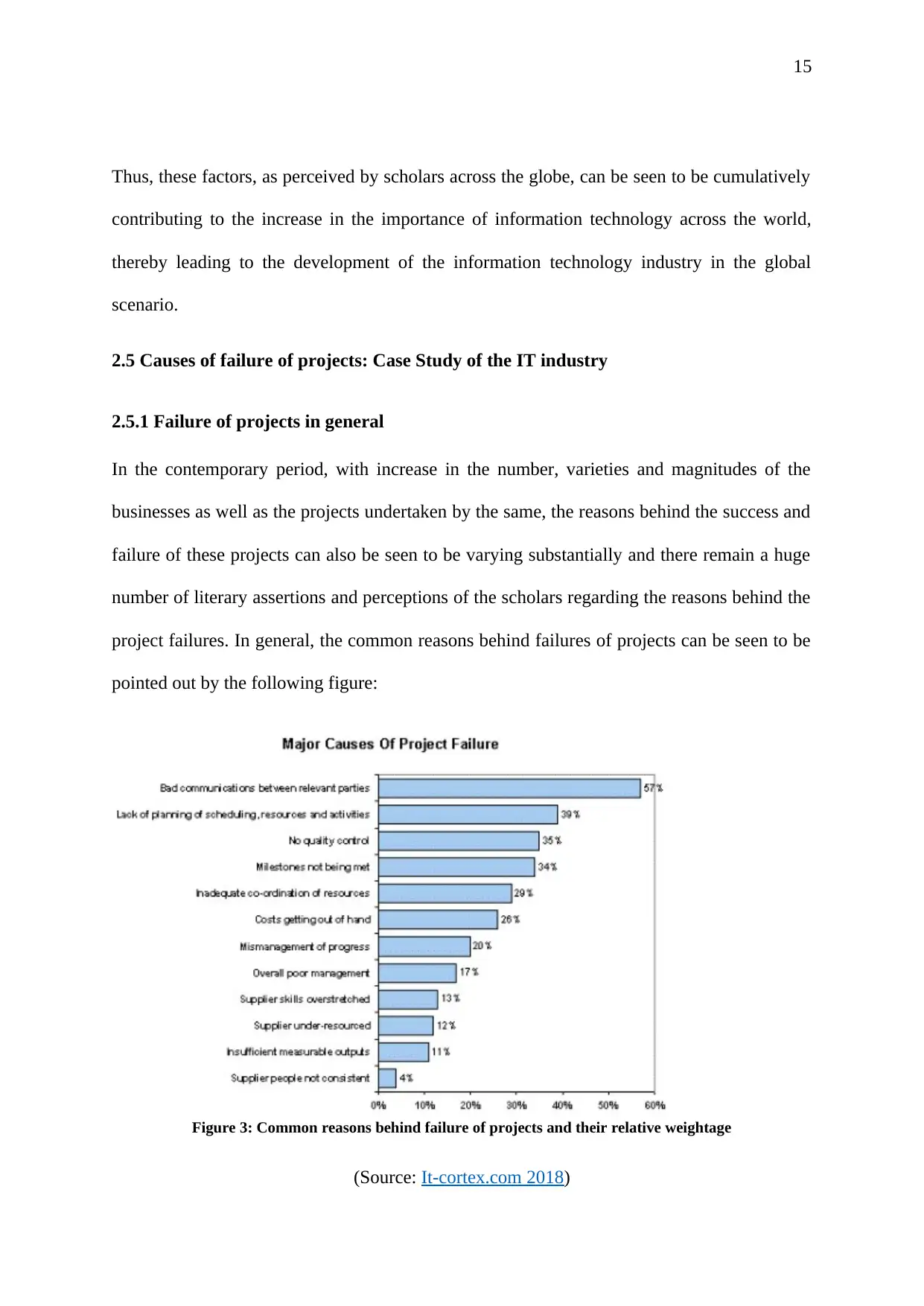
Thus, these factors, as perceived by scholars across the globe, can be seen to be cumulatively
contributing to the increase in the importance of information technology across the world,
thereby leading to the development of the information technology industry in the global
scenario.
2.5 Causes of failure of projects: Case Study of the IT industry
2.5.1 Failure of projects in general
In the contemporary period, with increase in the number, varieties and magnitudes of the
businesses as well as the projects undertaken by the same, the reasons behind the success and
failure of these projects can also be seen to be varying substantially and there remain a huge
number of literary assertions and perceptions of the scholars regarding the reasons behind the
project failures. In general, the common reasons behind failures of projects can be seen to be
pointed out by the following figure:
Figure 3: Common reasons behind failure of projects and their relative weightage
(Source: It-cortex.com 2018)
Paraphrase This Document
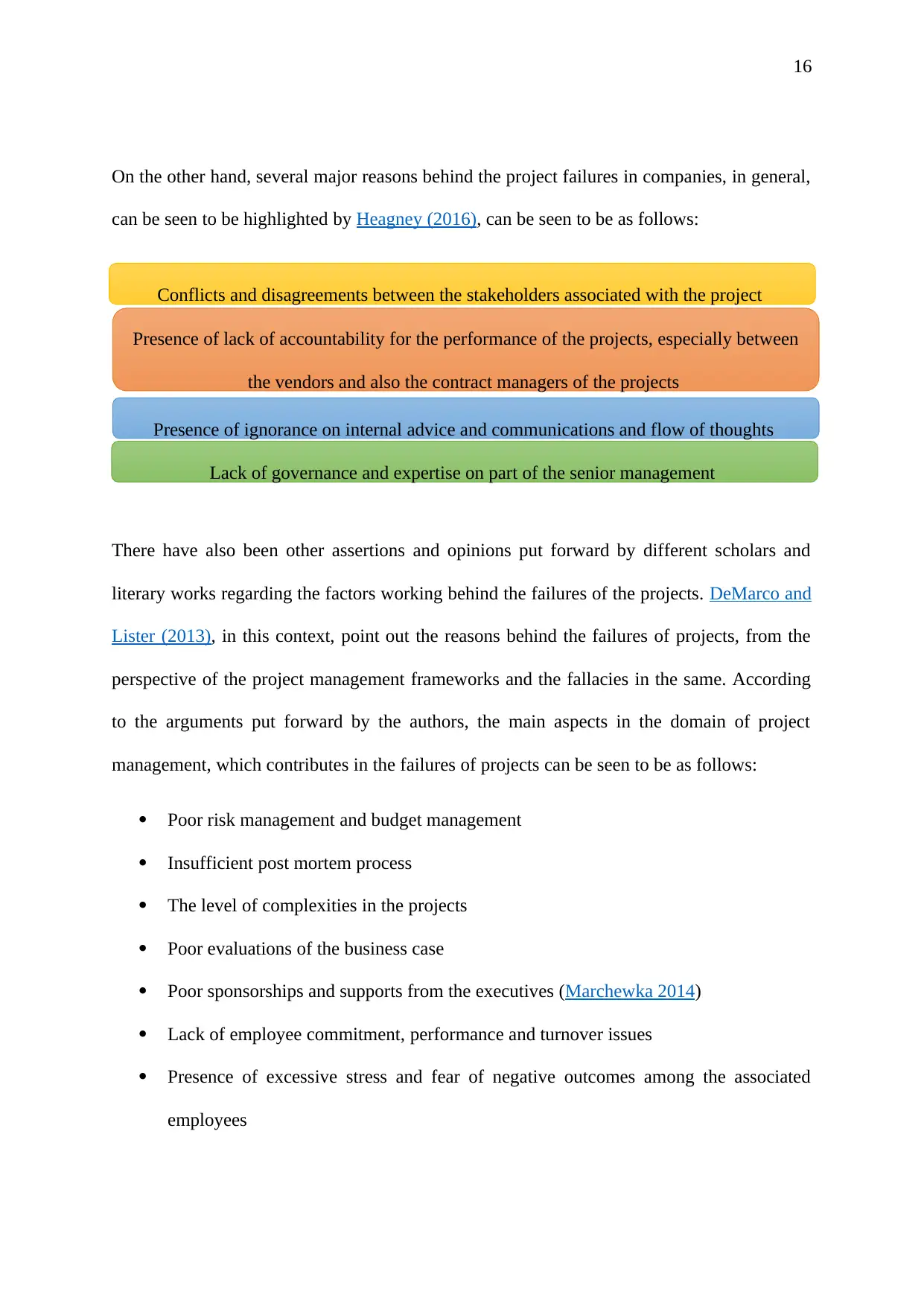
On the other hand, several major reasons behind the project failures in companies, in general,
can be seen to be highlighted by Heagney (2016), can be seen to be as follows:
There have also been other assertions and opinions put forward by different scholars and
literary works regarding the factors working behind the failures of the projects. DeMarco and
Lister (2013), in this context, point out the reasons behind the failures of projects, from the
perspective of the project management frameworks and the fallacies in the same. According
to the arguments put forward by the authors, the main aspects in the domain of project
management, which contributes in the failures of projects can be seen to be as follows:
Poor risk management and budget management
Insufficient post mortem process
The level of complexities in the projects
Poor evaluations of the business case
Poor sponsorships and supports from the executives (Marchewka 2014)
Lack of employee commitment, performance and turnover issues
Presence of excessive stress and fear of negative outcomes among the associated
employees
Conflicts and disagreements between the stakeholders associated with the project
Presence of lack of accountability for the performance of the projects, especially between
the vendors and also the contract managers of the projects
Presence of ignorance on internal advice and communications and flow of thoughts
Lack of governance and expertise on part of the senior management
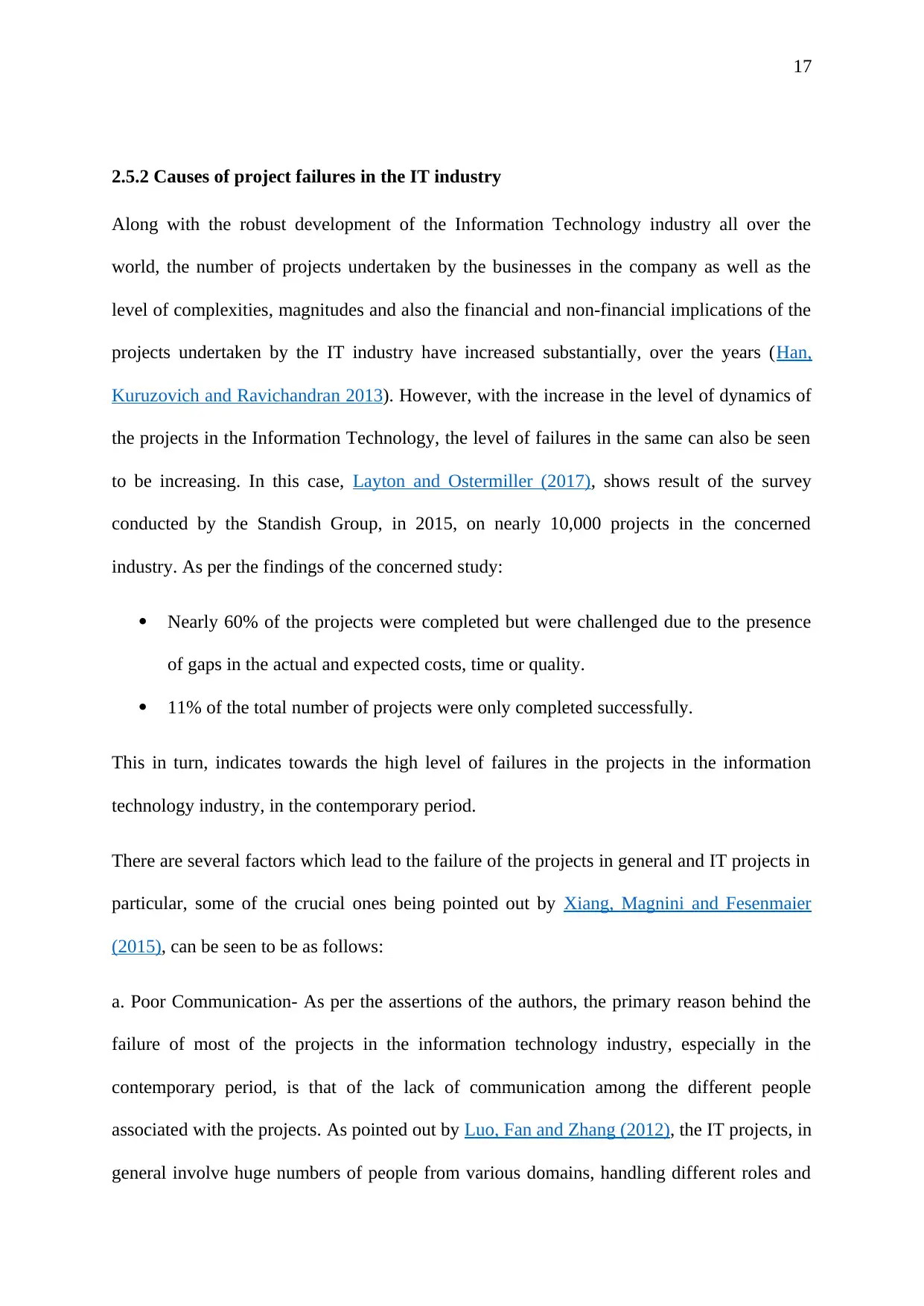
2.5.2 Causes of project failures in the IT industry
Along with the robust development of the Information Technology industry all over the
world, the number of projects undertaken by the businesses in the company as well as the
level of complexities, magnitudes and also the financial and non-financial implications of the
projects undertaken by the IT industry have increased substantially, over the years (Han,
Kuruzovich and Ravichandran 2013). However, with the increase in the level of dynamics of
the projects in the Information Technology, the level of failures in the same can also be seen
to be increasing. In this case, Layton and Ostermiller (2017), shows result of the survey
conducted by the Standish Group, in 2015, on nearly 10,000 projects in the concerned
industry. As per the findings of the concerned study:
Nearly 60% of the projects were completed but were challenged due to the presence
of gaps in the actual and expected costs, time or quality.
11% of the total number of projects were only completed successfully.
This in turn, indicates towards the high level of failures in the projects in the information
technology industry, in the contemporary period.
There are several factors which lead to the failure of the projects in general and IT projects in
particular, some of the crucial ones being pointed out by Xiang, Magnini and Fesenmaier
(2015), can be seen to be as follows:
a. Poor Communication- As per the assertions of the authors, the primary reason behind the
failure of most of the projects in the information technology industry, especially in the
contemporary period, is that of the lack of communication among the different people
associated with the projects. As pointed out by Luo, Fan and Zhang (2012), the IT projects, in
general involve huge numbers of people from various domains, handling different roles and
You're viewing a preview
Unlock full access by subscribing today!
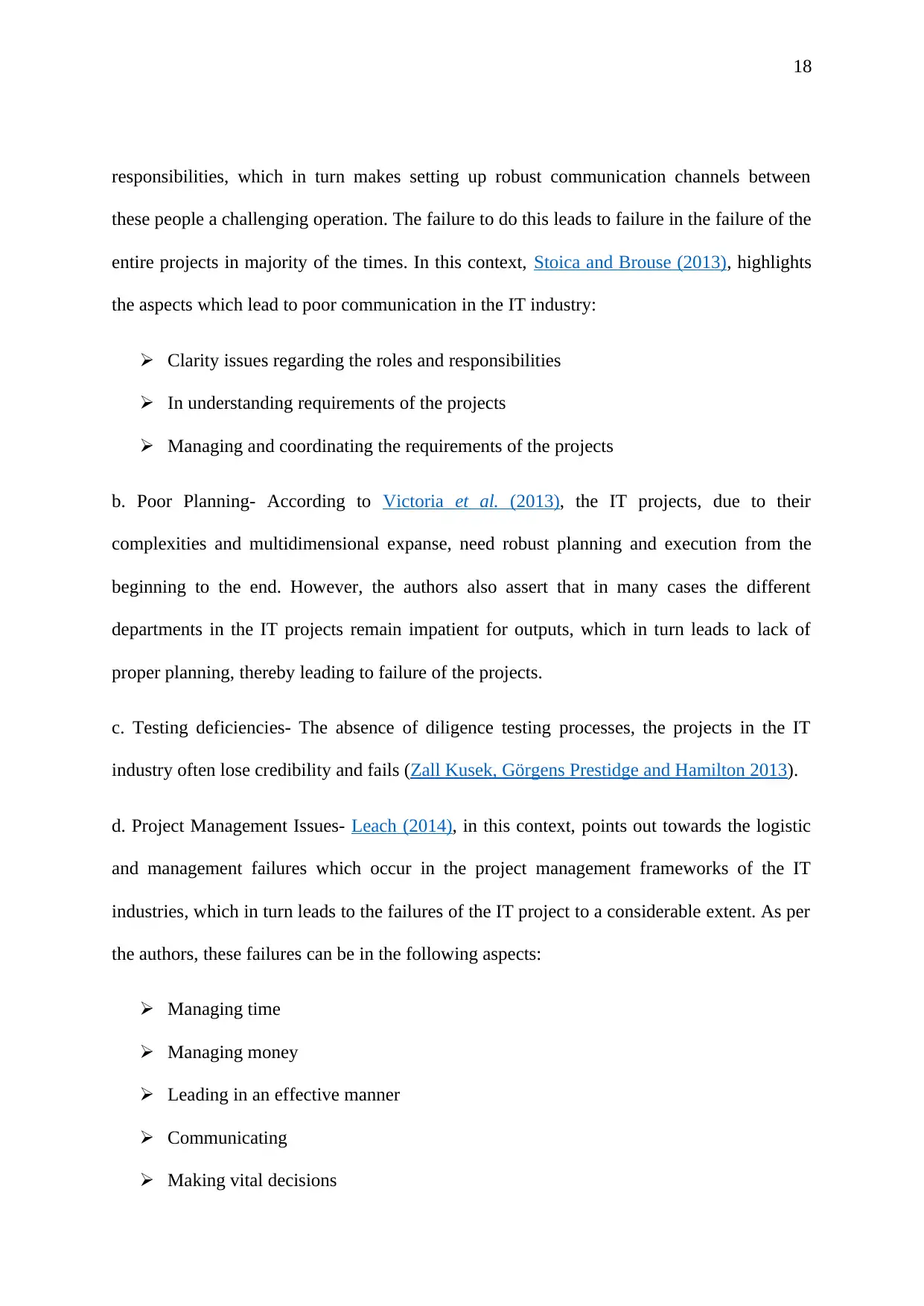
responsibilities, which in turn makes setting up robust communication channels between
these people a challenging operation. The failure to do this leads to failure in the failure of the
entire projects in majority of the times. In this context, Stoica and Brouse (2013), highlights
the aspects which lead to poor communication in the IT industry:
Clarity issues regarding the roles and responsibilities
In understanding requirements of the projects
Managing and coordinating the requirements of the projects
b. Poor Planning- According to Victoria et al. (2013), the IT projects, due to their
complexities and multidimensional expanse, need robust planning and execution from the
beginning to the end. However, the authors also assert that in many cases the different
departments in the IT projects remain impatient for outputs, which in turn leads to lack of
proper planning, thereby leading to failure of the projects.
c. Testing deficiencies- The absence of diligence testing processes, the projects in the IT
industry often lose credibility and fails (Zall Kusek, Görgens Prestidge and Hamilton 2013).
d. Project Management Issues- Leach (2014), in this context, points out towards the logistic
and management failures which occur in the project management frameworks of the IT
industries, which in turn leads to the failures of the IT project to a considerable extent. As per
the authors, these failures can be in the following aspects:
Managing time
Managing money
Leading in an effective manner
Communicating
Making vital decisions
Paraphrase This Document
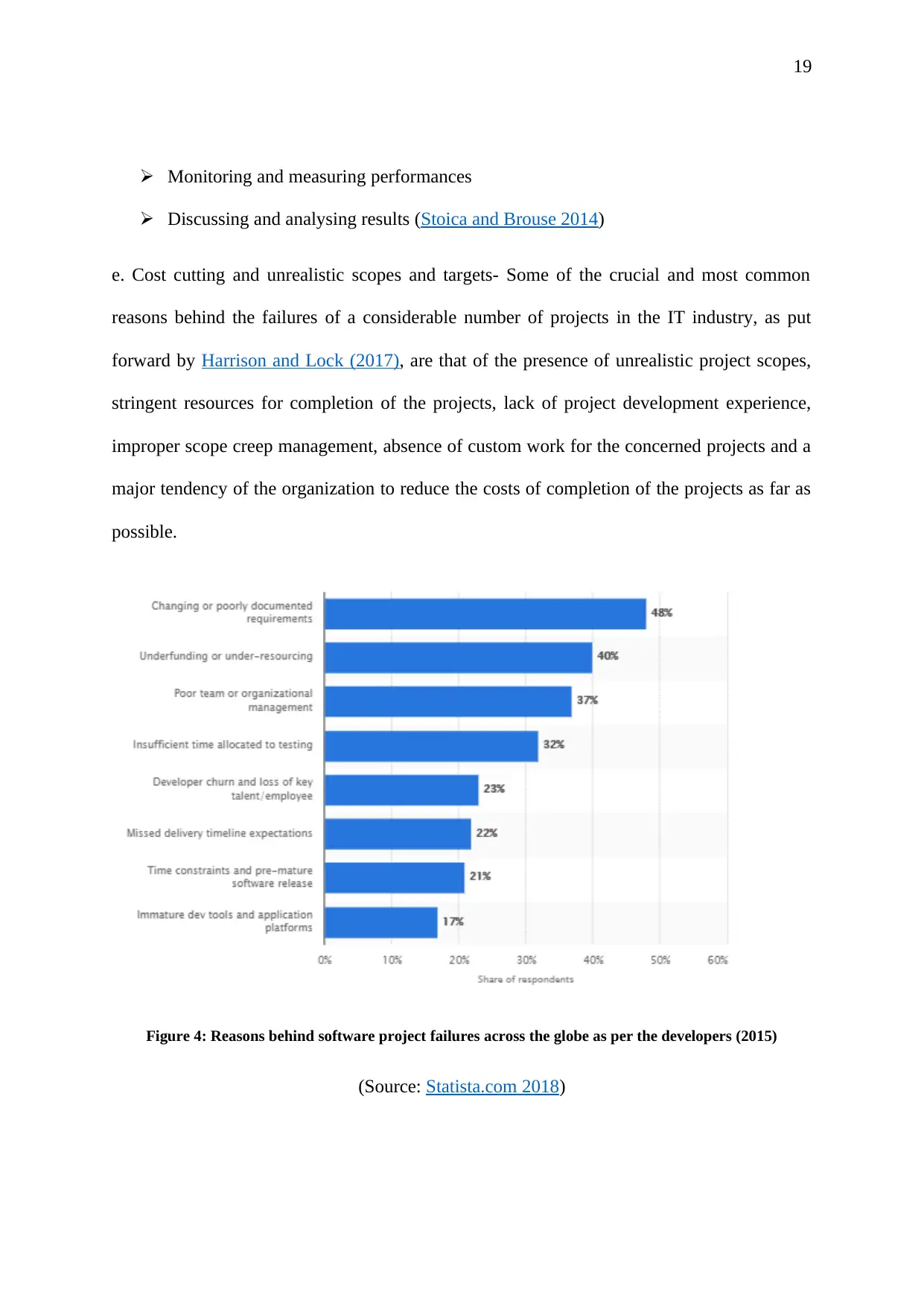
Monitoring and measuring performances
Discussing and analysing results (Stoica and Brouse 2014)
e. Cost cutting and unrealistic scopes and targets- Some of the crucial and most common
reasons behind the failures of a considerable number of projects in the IT industry, as put
forward by Harrison and Lock (2017), are that of the presence of unrealistic project scopes,
stringent resources for completion of the projects, lack of project development experience,
improper scope creep management, absence of custom work for the concerned projects and a
major tendency of the organization to reduce the costs of completion of the projects as far as
possible.
Figure 4: Reasons behind software project failures across the globe as per the developers (2015)
(Source: Statista.com 2018)
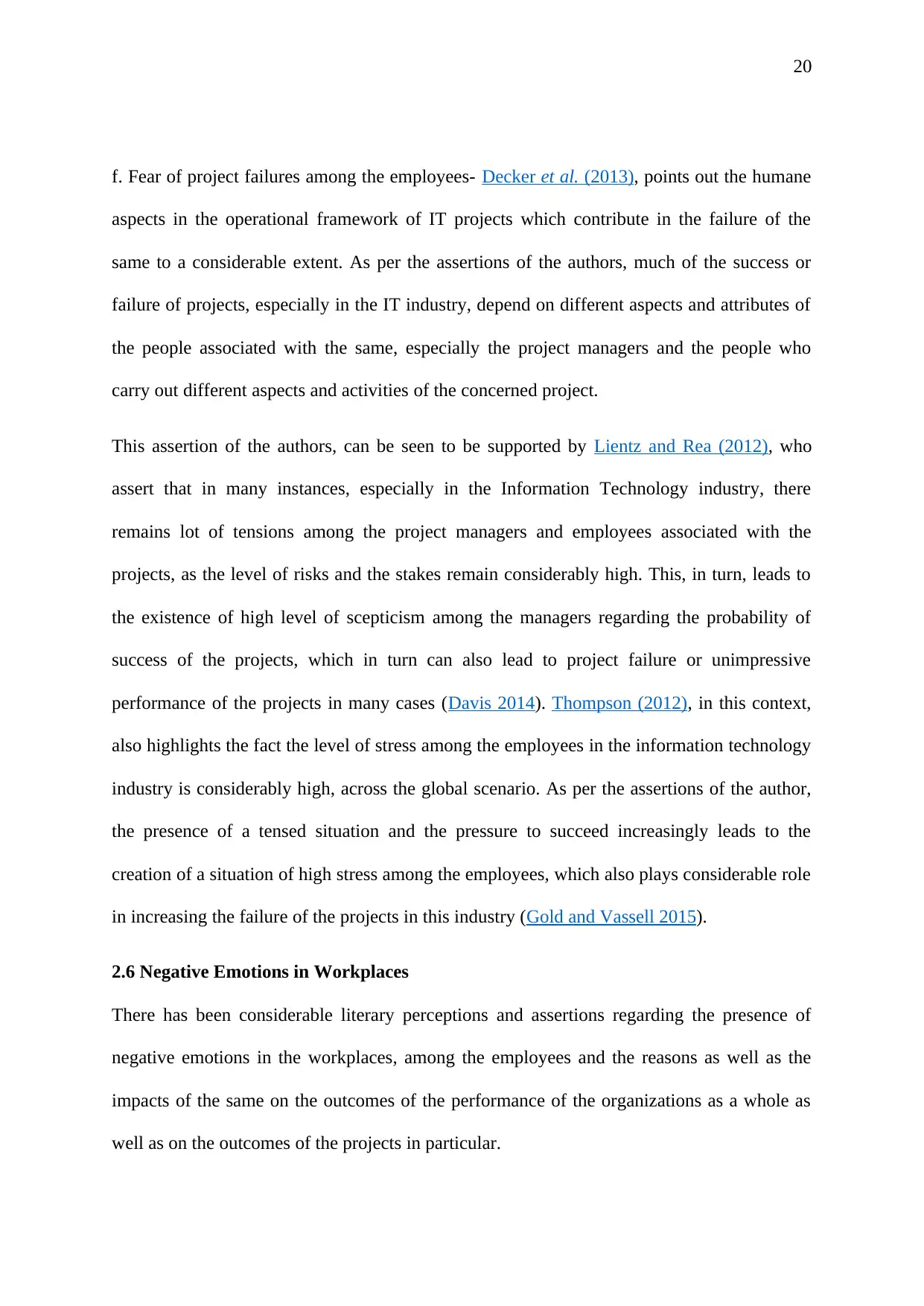
f. Fear of project failures among the employees- Decker et al. (2013), points out the humane
aspects in the operational framework of IT projects which contribute in the failure of the
same to a considerable extent. As per the assertions of the authors, much of the success or
failure of projects, especially in the IT industry, depend on different aspects and attributes of
the people associated with the same, especially the project managers and the people who
carry out different aspects and activities of the concerned project.
This assertion of the authors, can be seen to be supported by Lientz and Rea (2012), who
assert that in many instances, especially in the Information Technology industry, there
remains lot of tensions among the project managers and employees associated with the
projects, as the level of risks and the stakes remain considerably high. This, in turn, leads to
the existence of high level of scepticism among the managers regarding the probability of
success of the projects, which in turn can also lead to project failure or unimpressive
performance of the projects in many cases (Davis 2014). Thompson (2012), in this context,
also highlights the fact the level of stress among the employees in the information technology
industry is considerably high, across the global scenario. As per the assertions of the author,
the presence of a tensed situation and the pressure to succeed increasingly leads to the
creation of a situation of high stress among the employees, which also plays considerable role
in increasing the failure of the projects in this industry (Gold and Vassell 2015).
2.6 Negative Emotions in Workplaces
There has been considerable literary perceptions and assertions regarding the presence of
negative emotions in the workplaces, among the employees and the reasons as well as the
impacts of the same on the outcomes of the performance of the organizations as a whole as
well as on the outcomes of the projects in particular.
You're viewing a preview
Unlock full access by subscribing today!
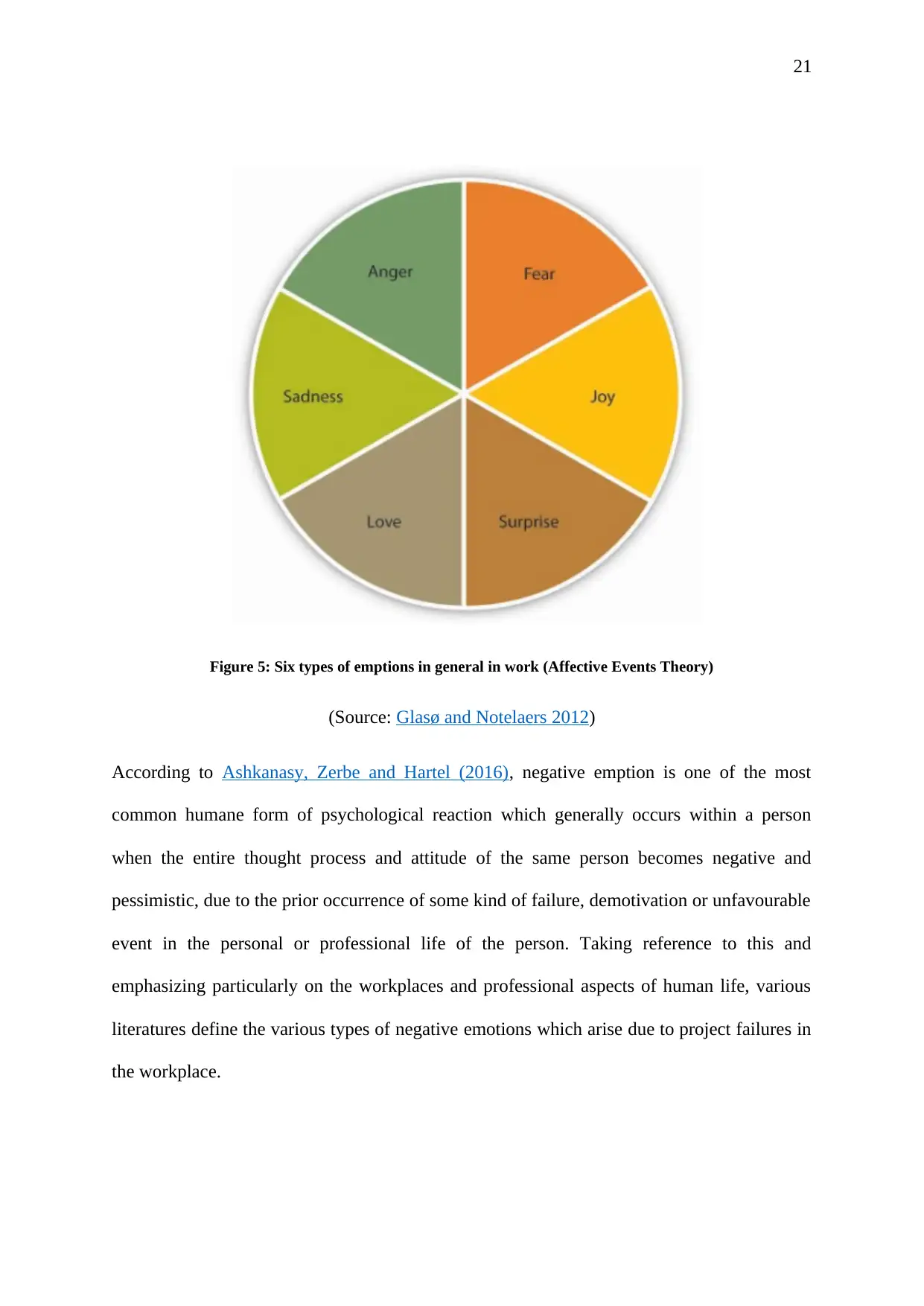
Figure 5: Six types of emptions in general in work (Affective Events Theory)
(Source: Glasø and Notelaers 2012)
According to Ashkanasy, Zerbe and Hartel (2016), negative emption is one of the most
common humane form of psychological reaction which generally occurs within a person
when the entire thought process and attitude of the same person becomes negative and
pessimistic, due to the prior occurrence of some kind of failure, demotivation or unfavourable
event in the personal or professional life of the person. Taking reference to this and
emphasizing particularly on the workplaces and professional aspects of human life, various
literatures define the various types of negative emotions which arise due to project failures in
the workplace.
Paraphrase This Document
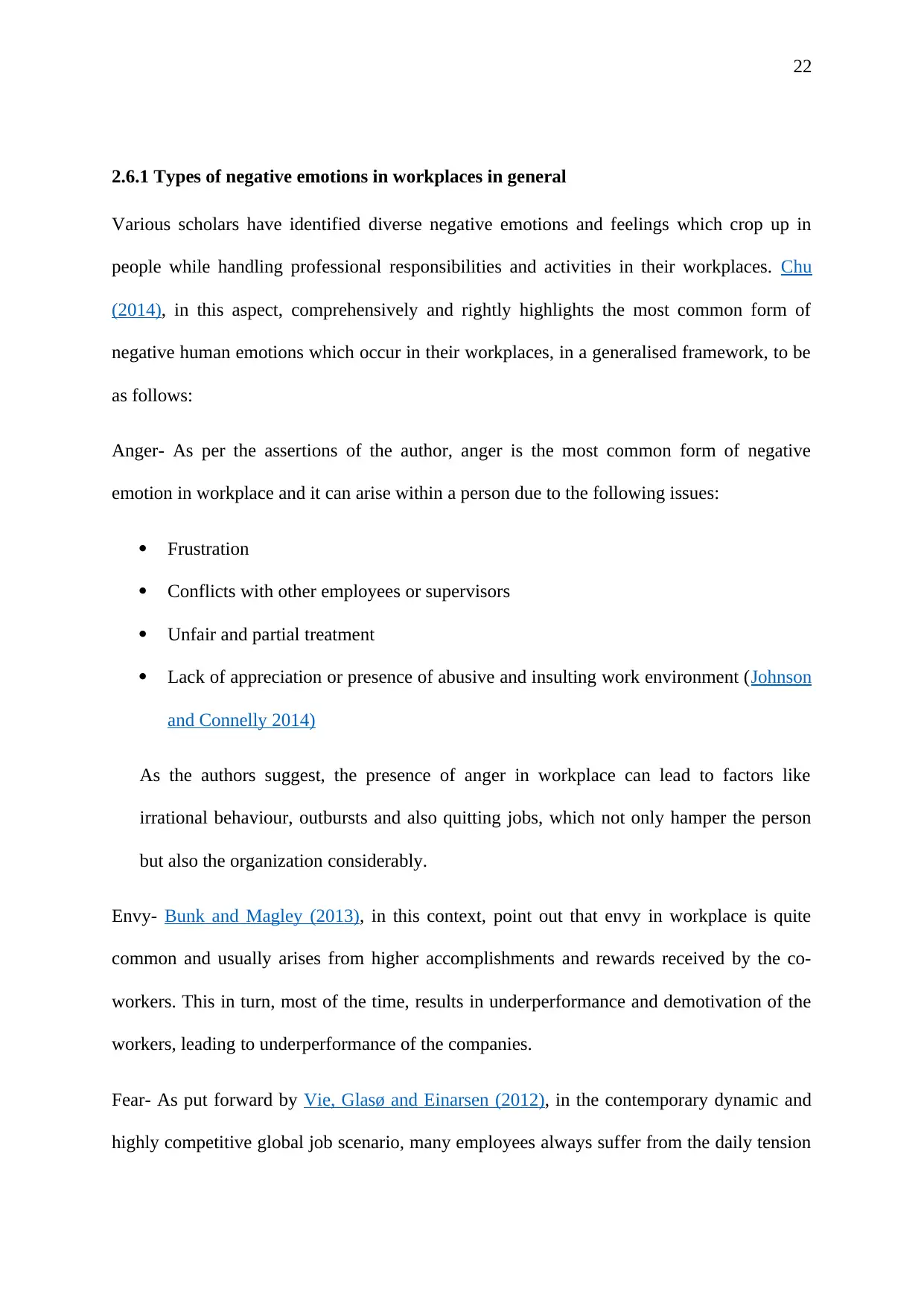
2.6.1 Types of negative emotions in workplaces in general
Various scholars have identified diverse negative emotions and feelings which crop up in
people while handling professional responsibilities and activities in their workplaces. Chu
(2014), in this aspect, comprehensively and rightly highlights the most common form of
negative human emotions which occur in their workplaces, in a generalised framework, to be
as follows:
Anger- As per the assertions of the author, anger is the most common form of negative
emotion in workplace and it can arise within a person due to the following issues:
Frustration
Conflicts with other employees or supervisors
Unfair and partial treatment
Lack of appreciation or presence of abusive and insulting work environment (Johnson
and Connelly 2014)
As the authors suggest, the presence of anger in workplace can lead to factors like
irrational behaviour, outbursts and also quitting jobs, which not only hamper the person
but also the organization considerably.
Envy- Bunk and Magley (2013), in this context, point out that envy in workplace is quite
common and usually arises from higher accomplishments and rewards received by the co-
workers. This in turn, most of the time, results in underperformance and demotivation of the
workers, leading to underperformance of the companies.
Fear- As put forward by Vie, Glasø and Einarsen (2012), in the contemporary dynamic and
highly competitive global job scenario, many employees always suffer from the daily tension
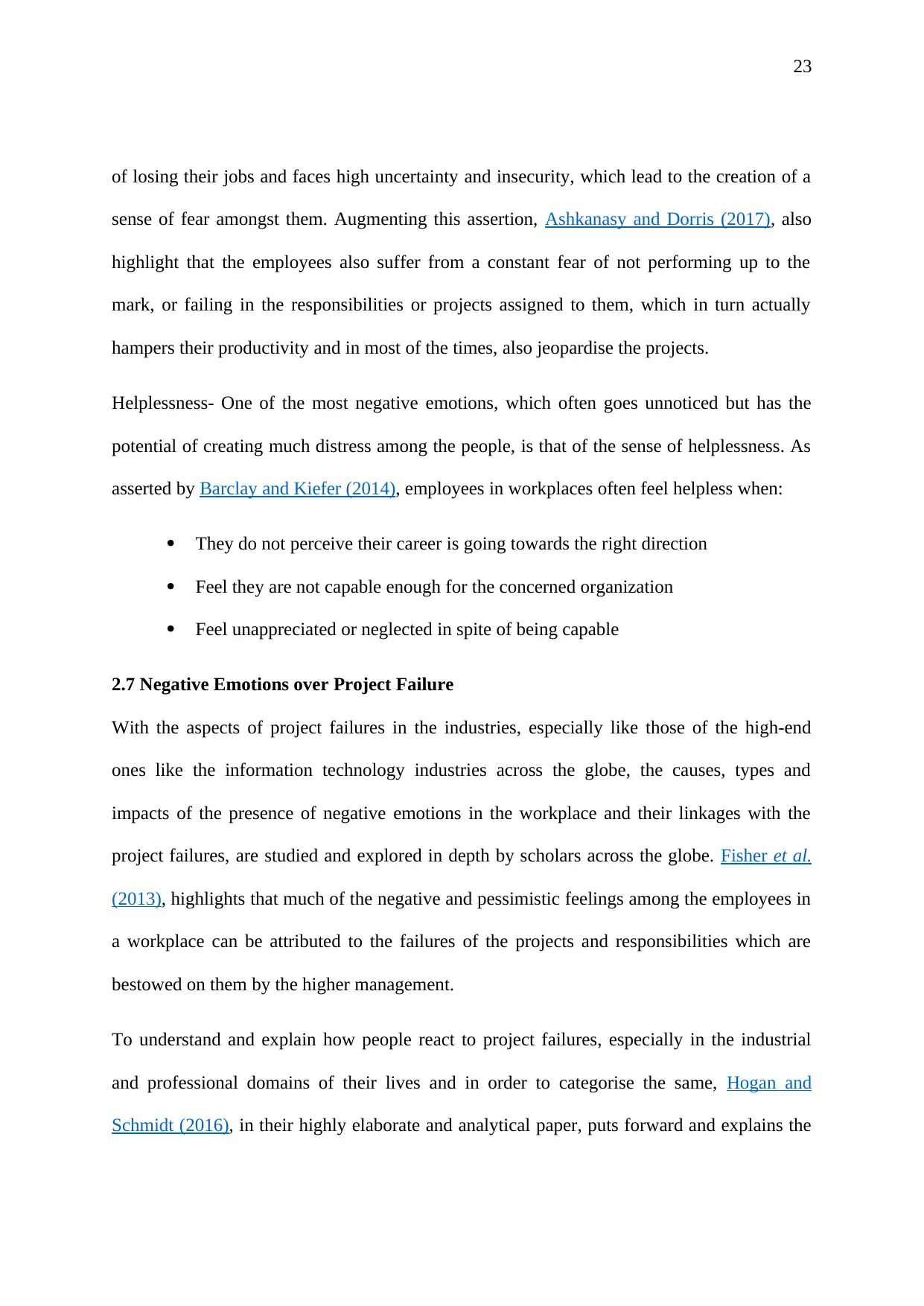
of losing their jobs and faces high uncertainty and insecurity, which lead to the creation of a
sense of fear amongst them. Augmenting this assertion, Ashkanasy and Dorris (2017), also
highlight that the employees also suffer from a constant fear of not performing up to the
mark, or failing in the responsibilities or projects assigned to them, which in turn actually
hampers their productivity and in most of the times, also jeopardise the projects.
Helplessness- One of the most negative emotions, which often goes unnoticed but has the
potential of creating much distress among the people, is that of the sense of helplessness. As
asserted by Barclay and Kiefer (2014), employees in workplaces often feel helpless when:
They do not perceive their career is going towards the right direction
Feel they are not capable enough for the concerned organization
Feel unappreciated or neglected in spite of being capable
2.7 Negative Emotions over Project Failure
With the aspects of project failures in the industries, especially like those of the high-end
ones like the information technology industries across the globe, the causes, types and
impacts of the presence of negative emotions in the workplace and their linkages with the
project failures, are studied and explored in depth by scholars across the globe. Fisher et al.
(2013), highlights that much of the negative and pessimistic feelings among the employees in
a workplace can be attributed to the failures of the projects and responsibilities which are
bestowed on them by the higher management.
To understand and explain how people react to project failures, especially in the industrial
and professional domains of their lives and in order to categorise the same, Hogan and
Schmidt (2016), in their highly elaborate and analytical paper, puts forward and explains the
You're viewing a preview
Unlock full access by subscribing today!
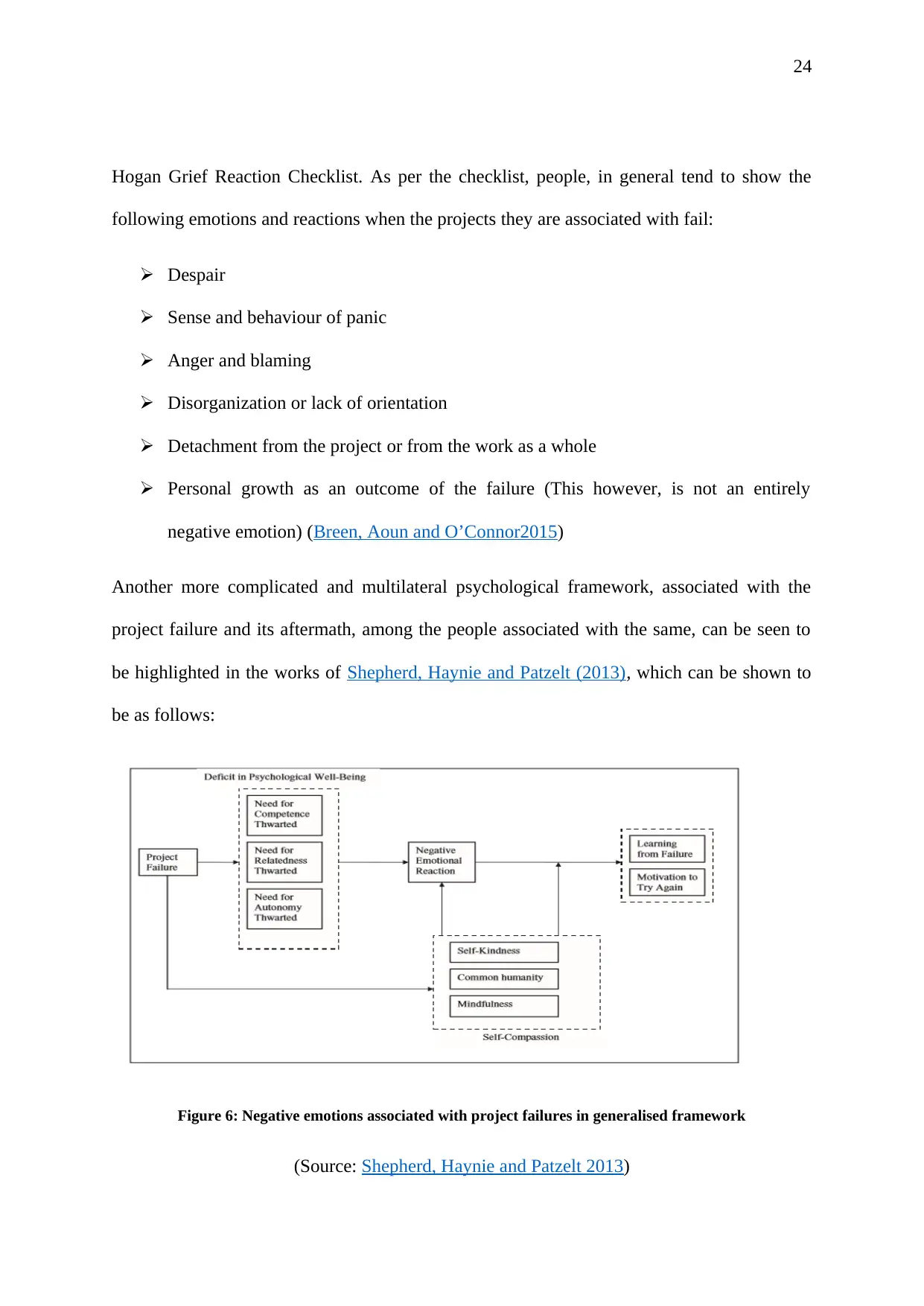
Hogan Grief Reaction Checklist. As per the checklist, people, in general tend to show the
following emotions and reactions when the projects they are associated with fail:
Despair
Sense and behaviour of panic
Anger and blaming
Disorganization or lack of orientation
Detachment from the project or from the work as a whole
Personal growth as an outcome of the failure (This however, is not an entirely
negative emotion) (Breen, Aoun and O’Connor2015)
Another more complicated and multilateral psychological framework, associated with the
project failure and its aftermath, among the people associated with the same, can be seen to
be highlighted in the works of Shepherd, Haynie and Patzelt (2013), which can be shown to
be as follows:
Figure 6: Negative emotions associated with project failures in generalised framework
(Source: Shepherd, Haynie and Patzelt 2013)
Paraphrase This Document
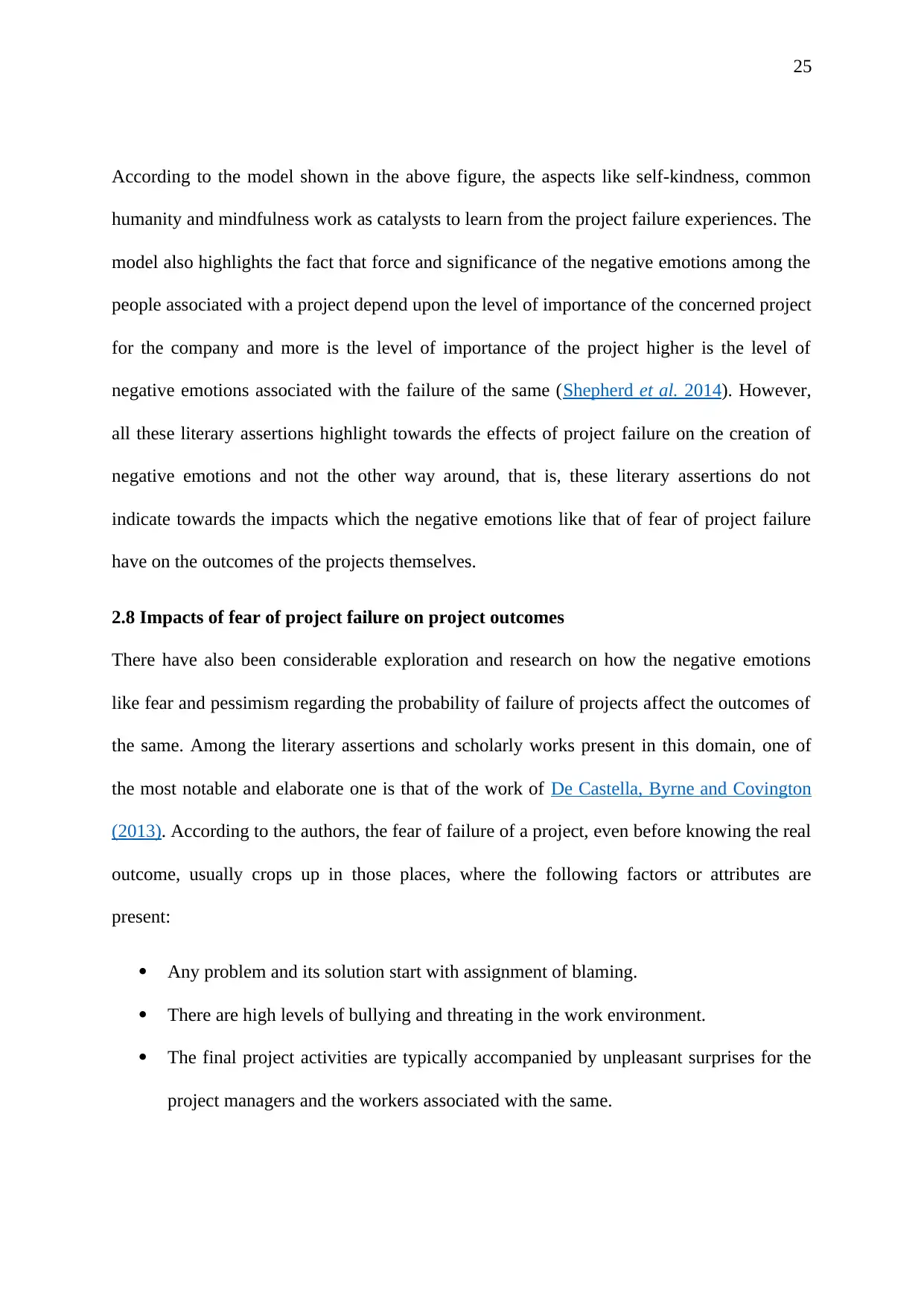
According to the model shown in the above figure, the aspects like self-kindness, common
humanity and mindfulness work as catalysts to learn from the project failure experiences. The
model also highlights the fact that force and significance of the negative emotions among the
people associated with a project depend upon the level of importance of the concerned project
for the company and more is the level of importance of the project higher is the level of
negative emotions associated with the failure of the same (Shepherd et al. 2014). However,
all these literary assertions highlight towards the effects of project failure on the creation of
negative emotions and not the other way around, that is, these literary assertions do not
indicate towards the impacts which the negative emotions like that of fear of project failure
have on the outcomes of the projects themselves.
2.8 Impacts of fear of project failure on project outcomes
There have also been considerable exploration and research on how the negative emotions
like fear and pessimism regarding the probability of failure of projects affect the outcomes of
the same. Among the literary assertions and scholarly works present in this domain, one of
the most notable and elaborate one is that of the work of De Castella, Byrne and Covington
(2013). According to the authors, the fear of failure of a project, even before knowing the real
outcome, usually crops up in those places, where the following factors or attributes are
present:
Any problem and its solution start with assignment of blaming.
There are high levels of bullying and threating in the work environment.
The final project activities are typically accompanied by unpleasant surprises for the
project managers and the workers associated with the same.
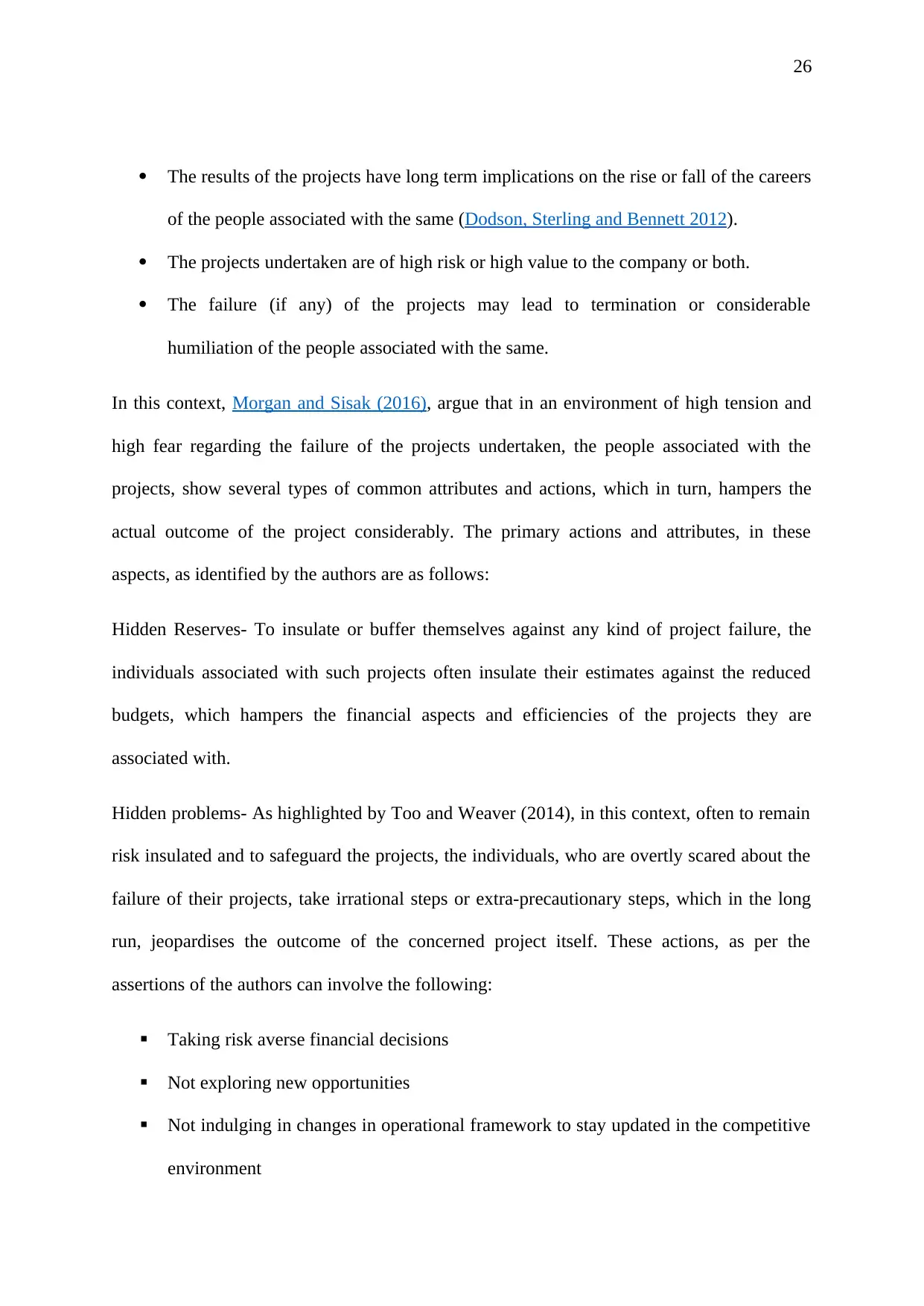
The results of the projects have long term implications on the rise or fall of the careers
of the people associated with the same (Dodson, Sterling and Bennett 2012).
The projects undertaken are of high risk or high value to the company or both.
The failure (if any) of the projects may lead to termination or considerable
humiliation of the people associated with the same.
In this context, Morgan and Sisak (2016), argue that in an environment of high tension and
high fear regarding the failure of the projects undertaken, the people associated with the
projects, show several types of common attributes and actions, which in turn, hampers the
actual outcome of the project considerably. The primary actions and attributes, in these
aspects, as identified by the authors are as follows:
Hidden Reserves- To insulate or buffer themselves against any kind of project failure, the
individuals associated with such projects often insulate their estimates against the reduced
budgets, which hampers the financial aspects and efficiencies of the projects they are
associated with.
Hidden problems- As highlighted by Too and Weaver (2014), in this context, often to remain
risk insulated and to safeguard the projects, the individuals, who are overtly scared about the
failure of their projects, take irrational steps or extra-precautionary steps, which in the long
run, jeopardises the outcome of the concerned project itself. These actions, as per the
assertions of the authors can involve the following:
Taking risk averse financial decisions
Not exploring new opportunities
Not indulging in changes in operational framework to stay updated in the competitive
environment
You're viewing a preview
Unlock full access by subscribing today!
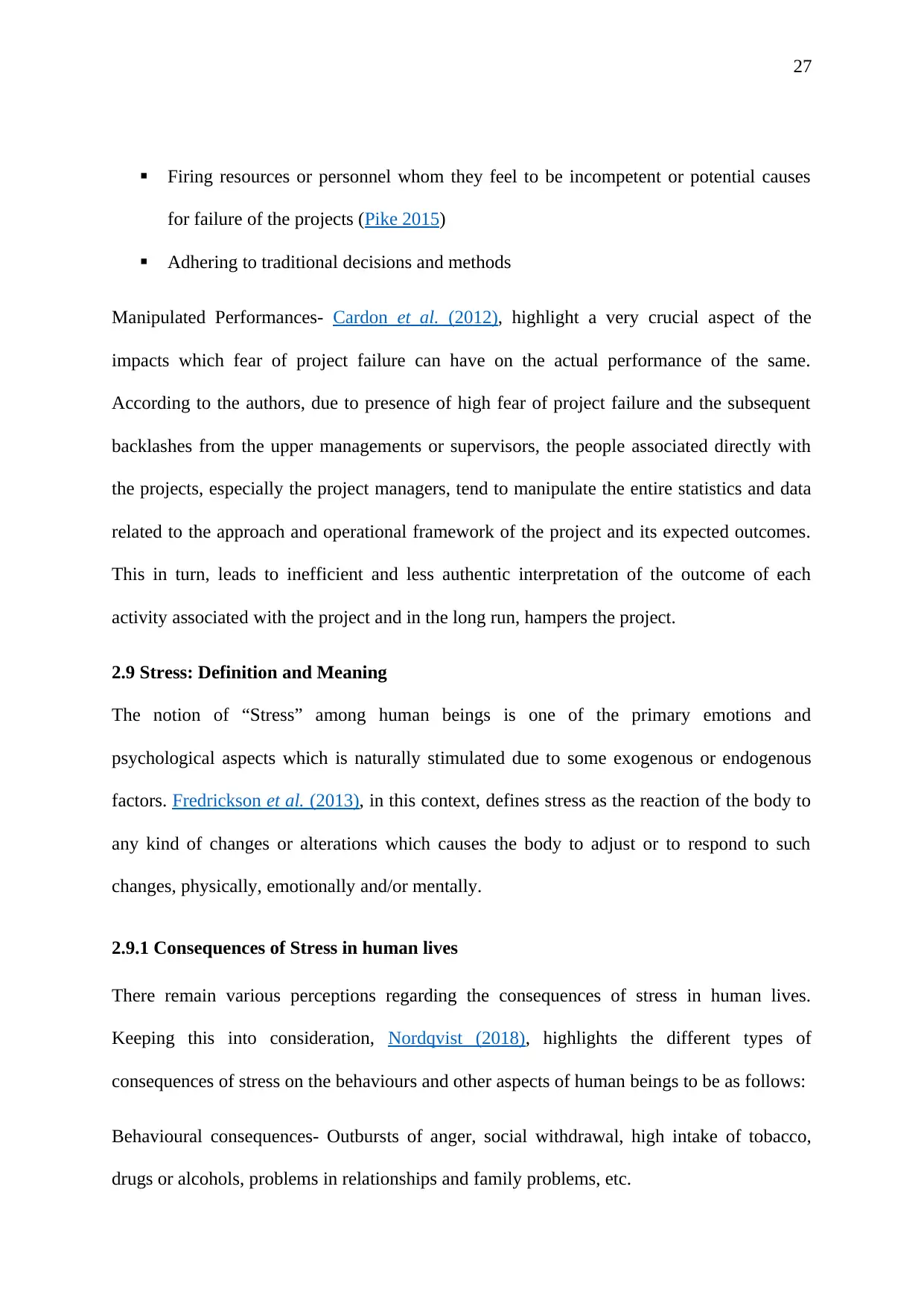
Firing resources or personnel whom they feel to be incompetent or potential causes
for failure of the projects (Pike 2015)
Adhering to traditional decisions and methods
Manipulated Performances- Cardon et al. (2012), highlight a very crucial aspect of the
impacts which fear of project failure can have on the actual performance of the same.
According to the authors, due to presence of high fear of project failure and the subsequent
backlashes from the upper managements or supervisors, the people associated directly with
the projects, especially the project managers, tend to manipulate the entire statistics and data
related to the approach and operational framework of the project and its expected outcomes.
This in turn, leads to inefficient and less authentic interpretation of the outcome of each
activity associated with the project and in the long run, hampers the project.
2.9 Stress: Definition and Meaning
The notion of “Stress” among human beings is one of the primary emotions and
psychological aspects which is naturally stimulated due to some exogenous or endogenous
factors. Fredrickson et al. (2013), in this context, defines stress as the reaction of the body to
any kind of changes or alterations which causes the body to adjust or to respond to such
changes, physically, emotionally and/or mentally.
2.9.1 Consequences of Stress in human lives
There remain various perceptions regarding the consequences of stress in human lives.
Keeping this into consideration, Nordqvist (2018), highlights the different types of
consequences of stress on the behaviours and other aspects of human beings to be as follows:
Behavioural consequences- Outbursts of anger, social withdrawal, high intake of tobacco,
drugs or alcohols, problems in relationships and family problems, etc.
Paraphrase This Document
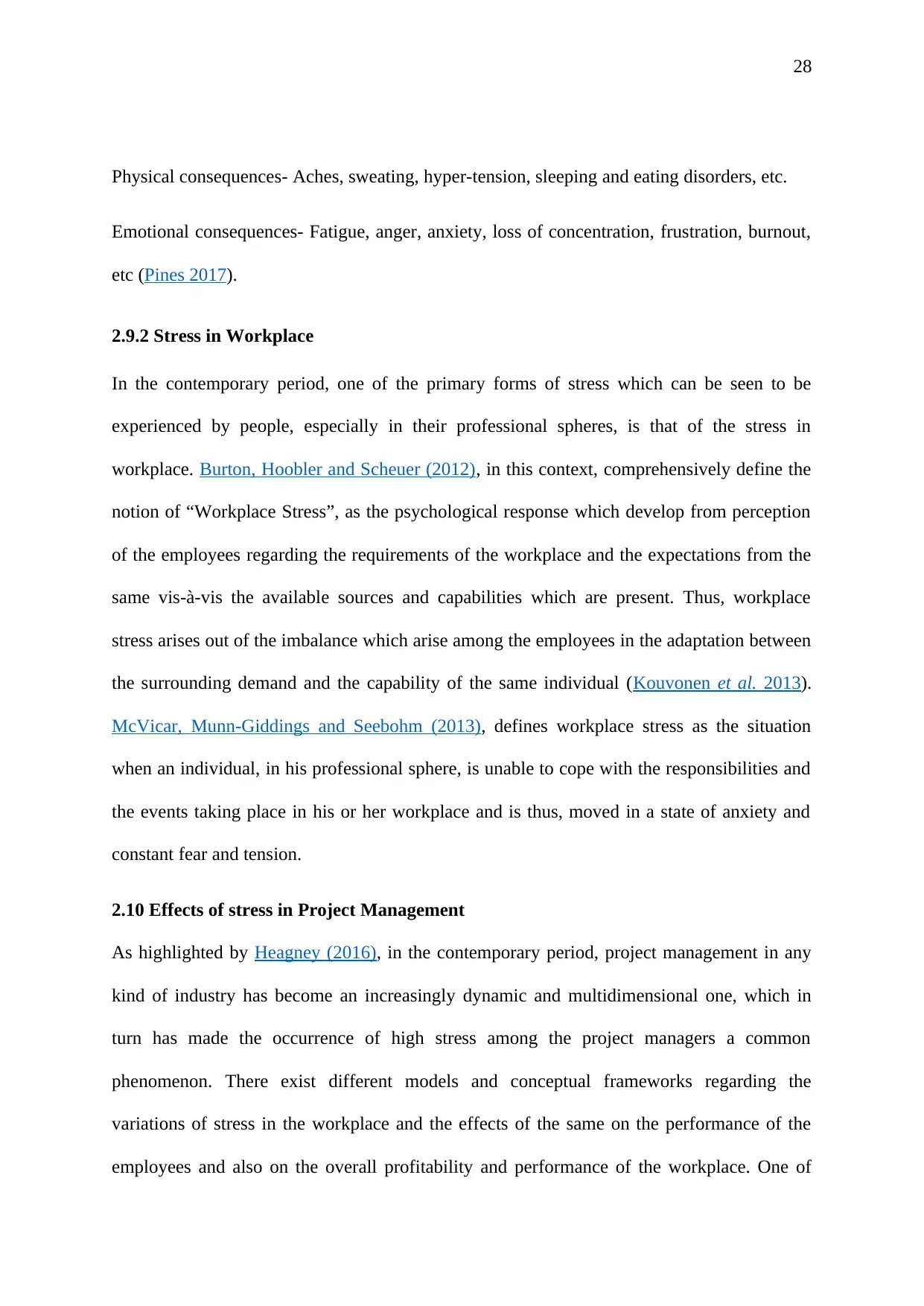
Physical consequences- Aches, sweating, hyper-tension, sleeping and eating disorders, etc.
Emotional consequences- Fatigue, anger, anxiety, loss of concentration, frustration, burnout,
etc (Pines 2017).
2.9.2 Stress in Workplace
In the contemporary period, one of the primary forms of stress which can be seen to be
experienced by people, especially in their professional spheres, is that of the stress in
workplace. Burton, Hoobler and Scheuer (2012), in this context, comprehensively define the
notion of “Workplace Stress”, as the psychological response which develop from perception
of the employees regarding the requirements of the workplace and the expectations from the
same vis-à-vis the available sources and capabilities which are present. Thus, workplace
stress arises out of the imbalance which arise among the employees in the adaptation between
the surrounding demand and the capability of the same individual (Kouvonen et al. 2013).
McVicar, Munn-Giddings and Seebohm (2013), defines workplace stress as the situation
when an individual, in his professional sphere, is unable to cope with the responsibilities and
the events taking place in his or her workplace and is thus, moved in a state of anxiety and
constant fear and tension.
2.10 Effects of stress in Project Management
As highlighted by Heagney (2016), in the contemporary period, project management in any
kind of industry has become an increasingly dynamic and multidimensional one, which in
turn has made the occurrence of high stress among the project managers a common
phenomenon. There exist different models and conceptual frameworks regarding the
variations of stress in the workplace and the effects of the same on the performance of the
employees and also on the overall profitability and performance of the workplace. One of
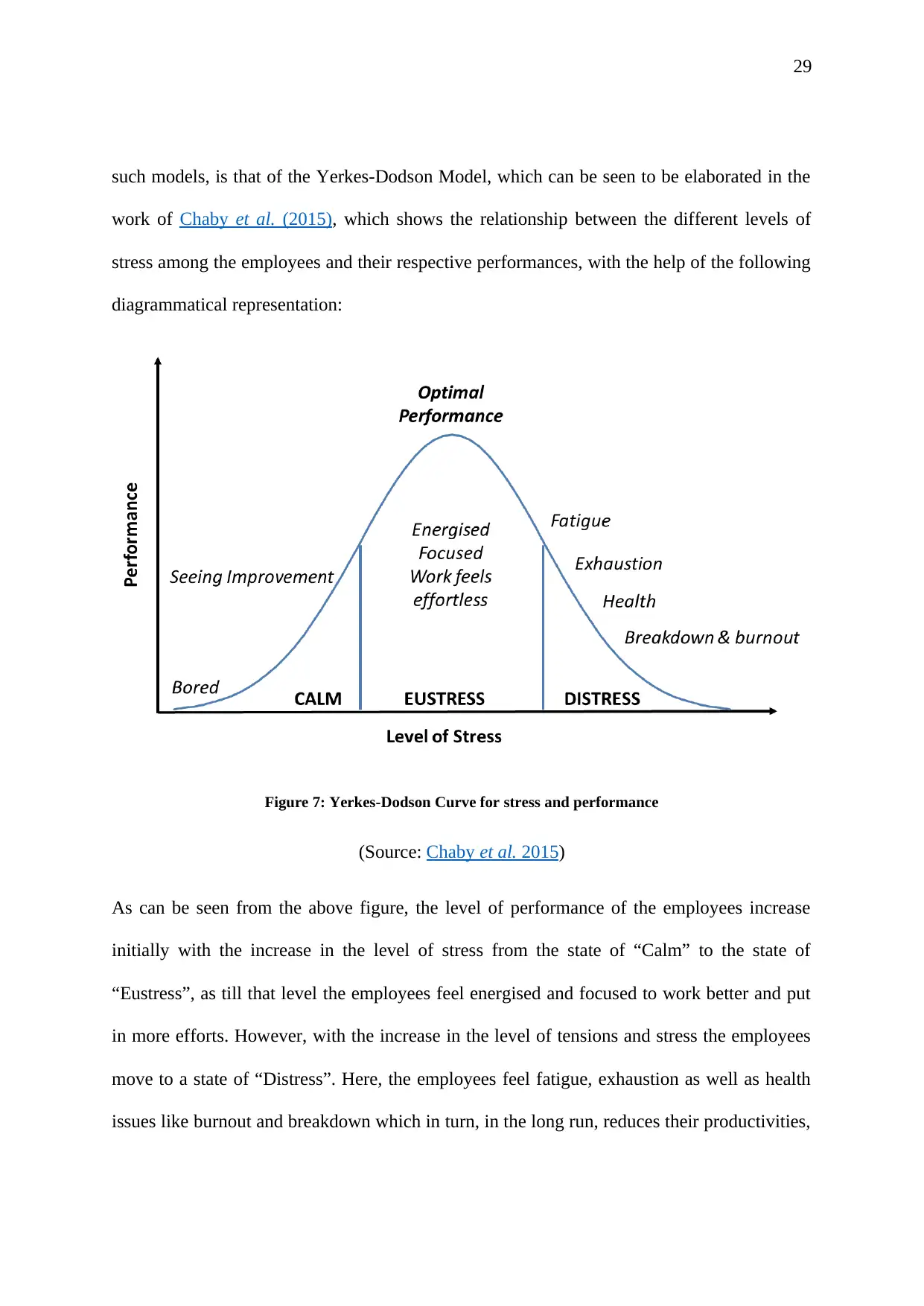
such models, is that of the Yerkes-Dodson Model, which can be seen to be elaborated in the
work of Chaby et al. (2015), which shows the relationship between the different levels of
stress among the employees and their respective performances, with the help of the following
diagrammatical representation:
Figure 7: Yerkes-Dodson Curve for stress and performance
(Source: Chaby et al. 2015)
As can be seen from the above figure, the level of performance of the employees increase
initially with the increase in the level of stress from the state of “Calm” to the state of
“Eustress”, as till that level the employees feel energised and focused to work better and put
in more efforts. However, with the increase in the level of tensions and stress the employees
move to a state of “Distress”. Here, the employees feel fatigue, exhaustion as well as health
issues like burnout and breakdown which in turn, in the long run, reduces their productivities,
You're viewing a preview
Unlock full access by subscribing today!
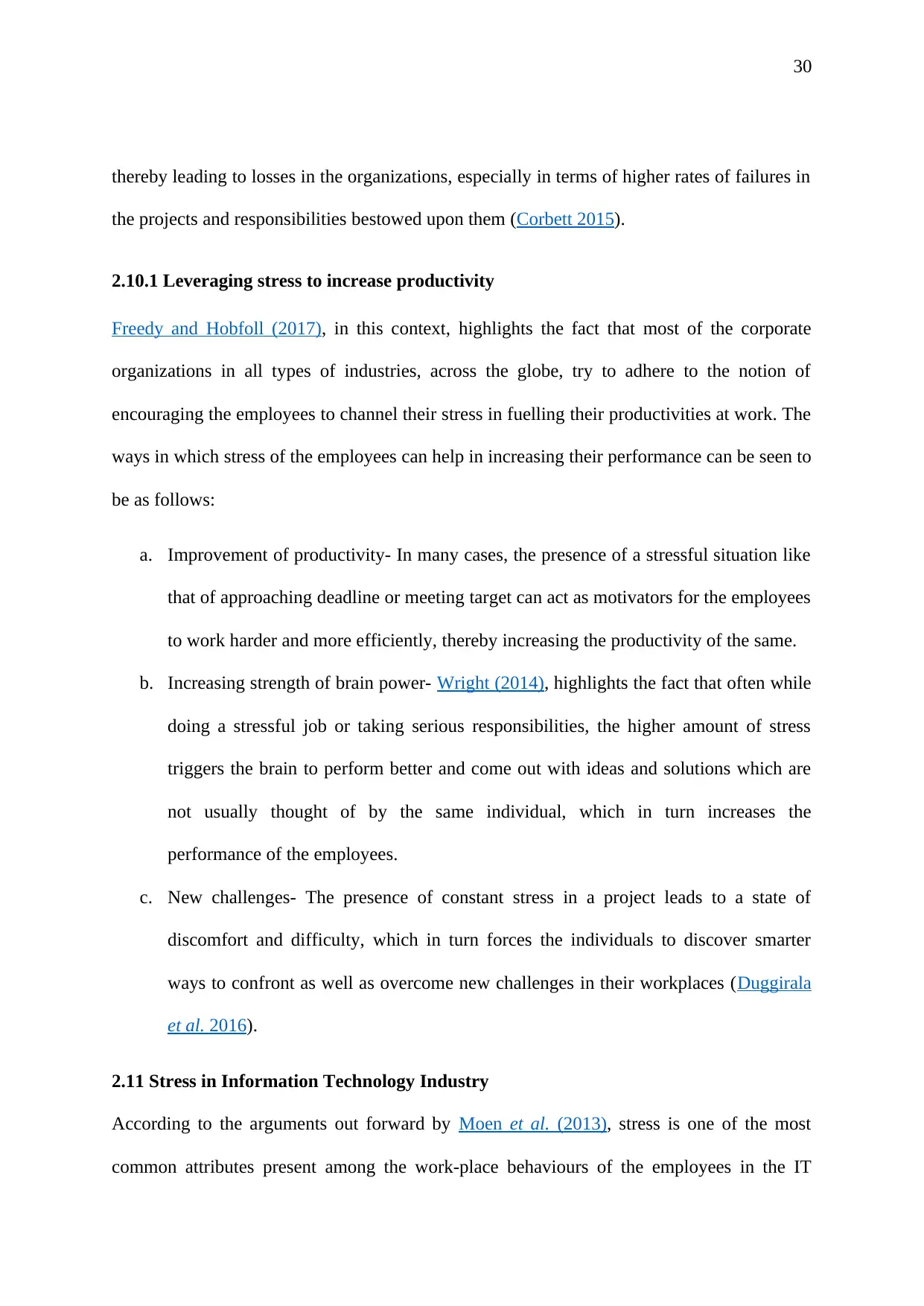
thereby leading to losses in the organizations, especially in terms of higher rates of failures in
the projects and responsibilities bestowed upon them (Corbett 2015).
2.10.1 Leveraging stress to increase productivity
Freedy and Hobfoll (2017), in this context, highlights the fact that most of the corporate
organizations in all types of industries, across the globe, try to adhere to the notion of
encouraging the employees to channel their stress in fuelling their productivities at work. The
ways in which stress of the employees can help in increasing their performance can be seen to
be as follows:
a. Improvement of productivity- In many cases, the presence of a stressful situation like
that of approaching deadline or meeting target can act as motivators for the employees
to work harder and more efficiently, thereby increasing the productivity of the same.
b. Increasing strength of brain power- Wright (2014), highlights the fact that often while
doing a stressful job or taking serious responsibilities, the higher amount of stress
triggers the brain to perform better and come out with ideas and solutions which are
not usually thought of by the same individual, which in turn increases the
performance of the employees.
c. New challenges- The presence of constant stress in a project leads to a state of
discomfort and difficulty, which in turn forces the individuals to discover smarter
ways to confront as well as overcome new challenges in their workplaces (Duggirala
et al. 2016).
2.11 Stress in Information Technology Industry
According to the arguments out forward by Moen et al. (2013), stress is one of the most
common attributes present among the work-place behaviours of the employees in the IT
Paraphrase This Document
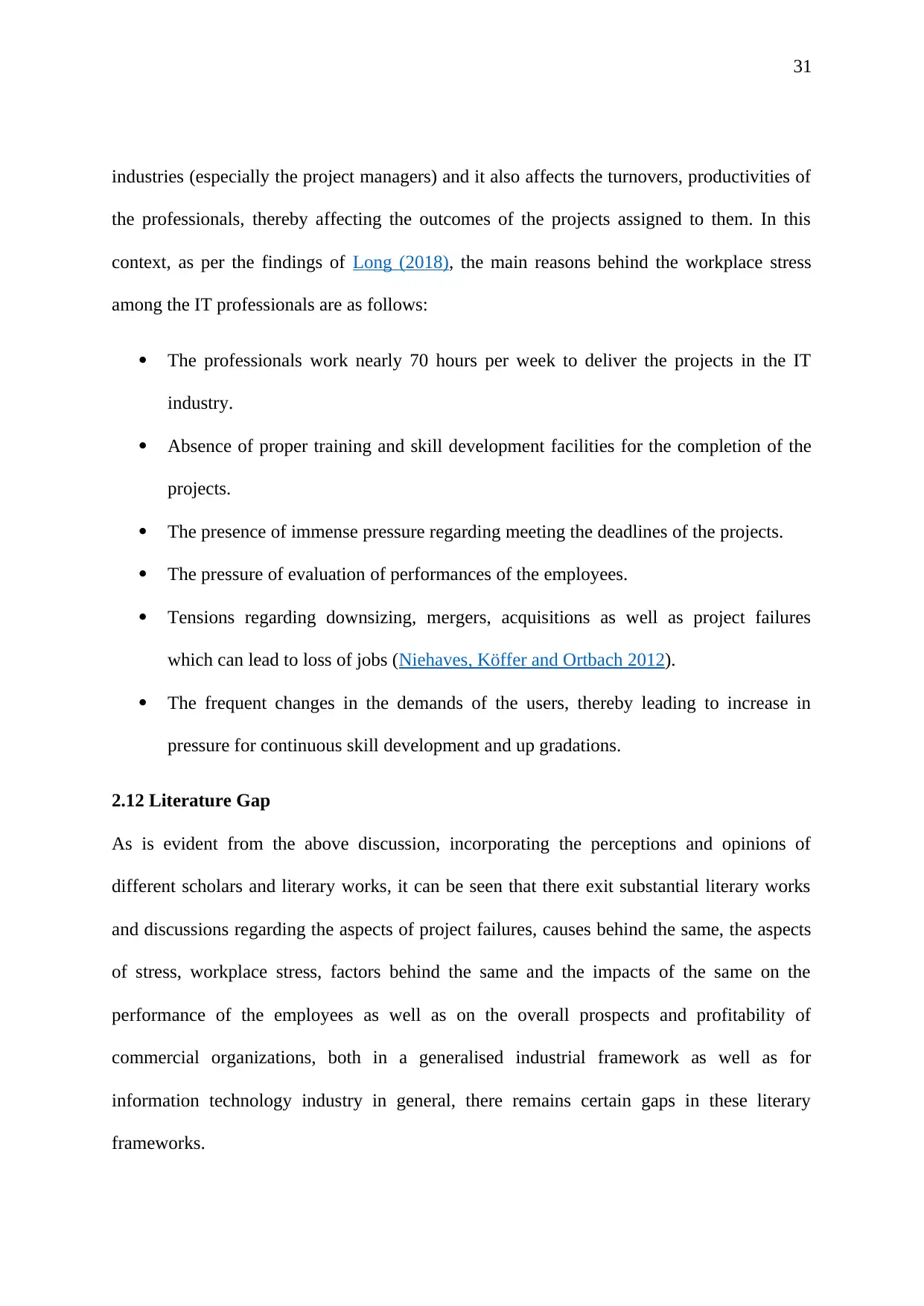
industries (especially the project managers) and it also affects the turnovers, productivities of
the professionals, thereby affecting the outcomes of the projects assigned to them. In this
context, as per the findings of Long (2018), the main reasons behind the workplace stress
among the IT professionals are as follows:
The professionals work nearly 70 hours per week to deliver the projects in the IT
industry.
Absence of proper training and skill development facilities for the completion of the
projects.
The presence of immense pressure regarding meeting the deadlines of the projects.
The pressure of evaluation of performances of the employees.
Tensions regarding downsizing, mergers, acquisitions as well as project failures
which can lead to loss of jobs (Niehaves, Köffer and Ortbach 2012).
The frequent changes in the demands of the users, thereby leading to increase in
pressure for continuous skill development and up gradations.
2.12 Literature Gap
As is evident from the above discussion, incorporating the perceptions and opinions of
different scholars and literary works, it can be seen that there exit substantial literary works
and discussions regarding the aspects of project failures, causes behind the same, the aspects
of stress, workplace stress, factors behind the same and the impacts of the same on the
performance of the employees as well as on the overall prospects and profitability of
commercial organizations, both in a generalised industrial framework as well as for
information technology industry in general, there remains certain gaps in these literary
frameworks.
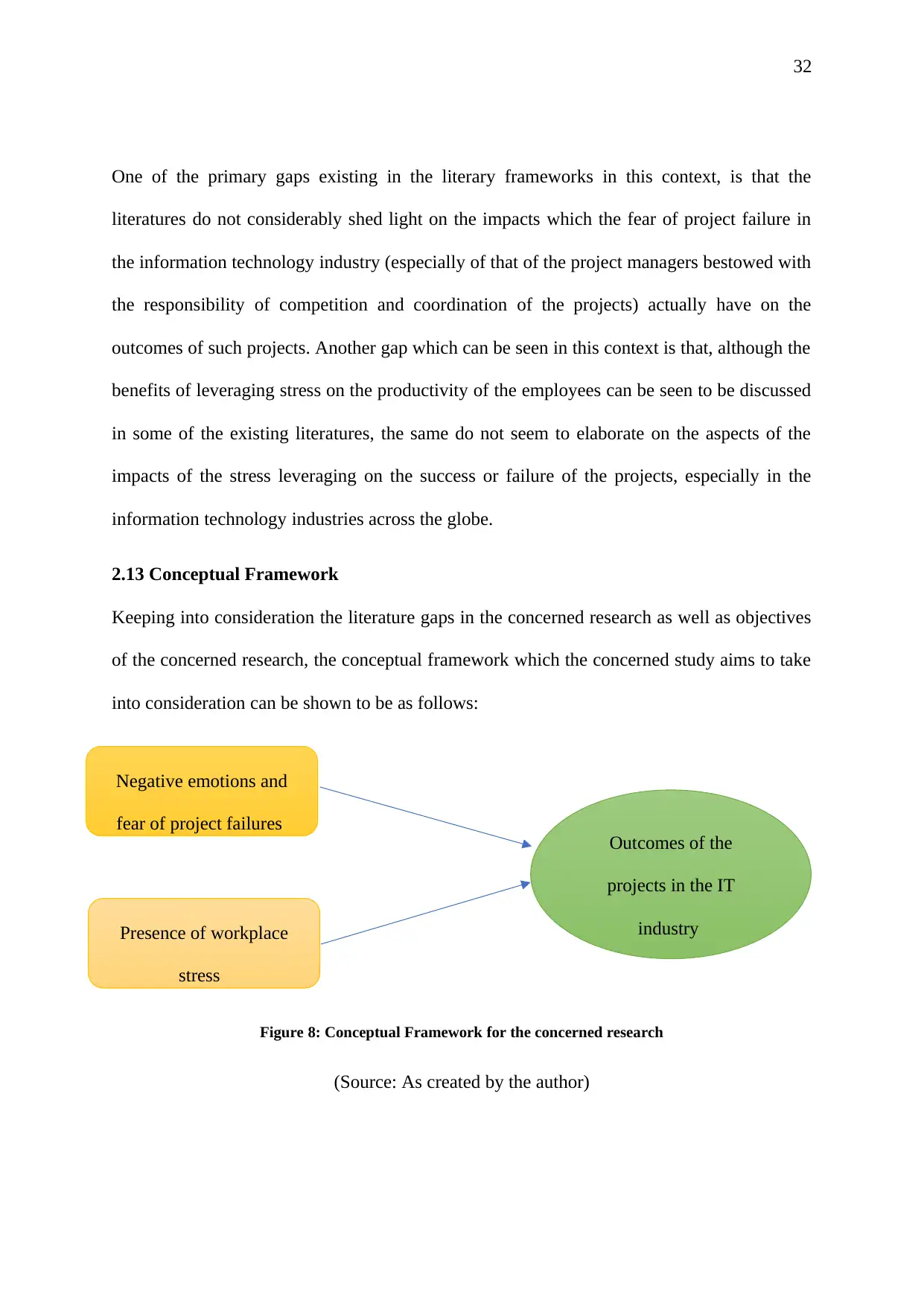
One of the primary gaps existing in the literary frameworks in this context, is that the
literatures do not considerably shed light on the impacts which the fear of project failure in
the information technology industry (especially of that of the project managers bestowed with
the responsibility of competition and coordination of the projects) actually have on the
outcomes of such projects. Another gap which can be seen in this context is that, although the
benefits of leveraging stress on the productivity of the employees can be seen to be discussed
in some of the existing literatures, the same do not seem to elaborate on the aspects of the
impacts of the stress leveraging on the success or failure of the projects, especially in the
information technology industries across the globe.
2.13 Conceptual Framework
Keeping into consideration the literature gaps in the concerned research as well as objectives
of the concerned research, the conceptual framework which the concerned study aims to take
into consideration can be shown to be as follows:
Figure 8: Conceptual Framework for the concerned research
(Source: As created by the author)
Negative emotions and
fear of project failures
Presence of workplace
stress
Outcomes of the
projects in the IT
industry
You're viewing a preview
Unlock full access by subscribing today!

As is evident from the above conceptual framework, the concerned research aims to study the
effects of negative emotions as well as workplace stress among the IT project managers on
the outcomes of the projects (both positive as well as negative) assigned to them.
Paraphrase This Document
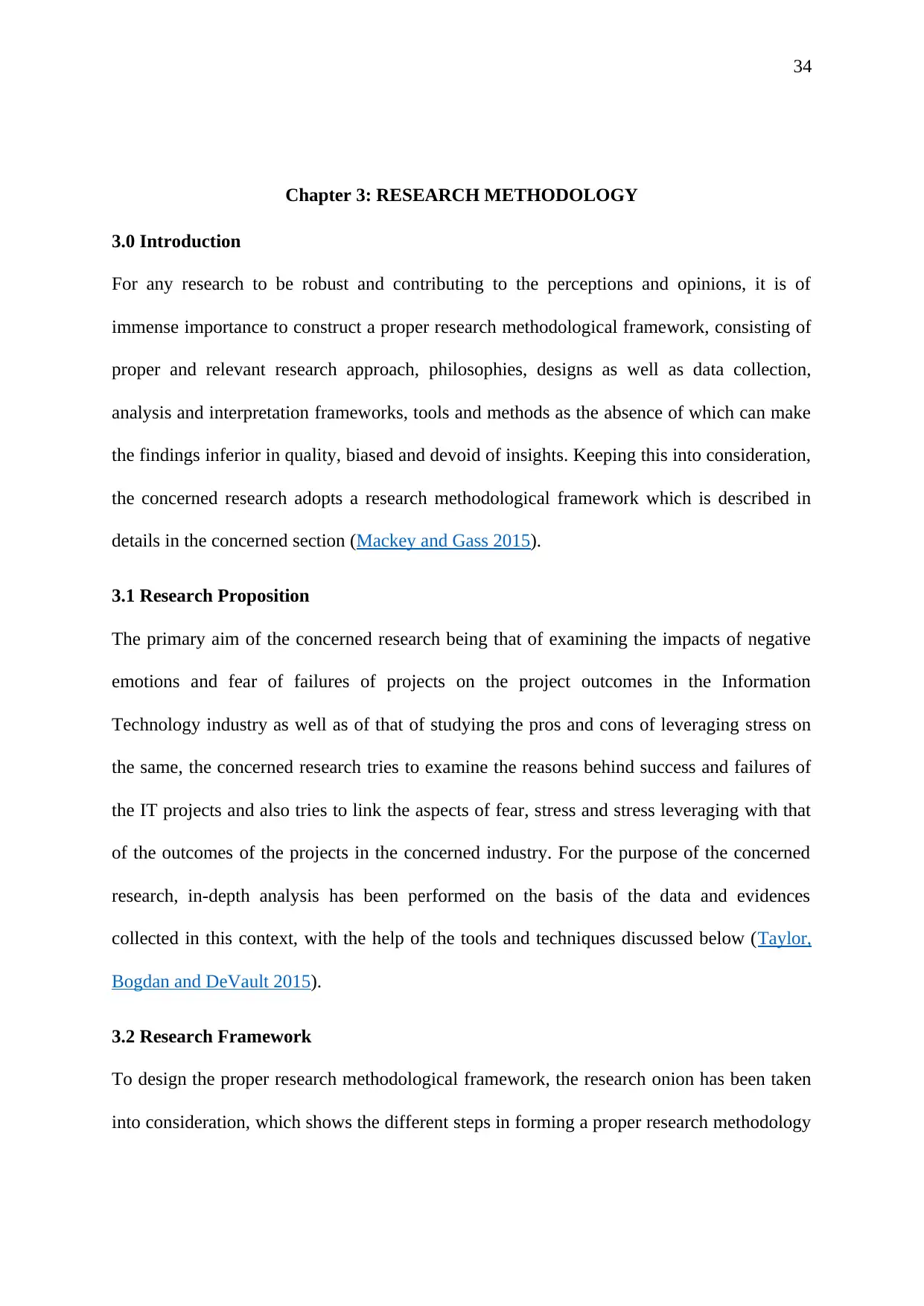
Chapter 3: RESEARCH METHODOLOGY
3.0 Introduction
For any research to be robust and contributing to the perceptions and opinions, it is of
immense importance to construct a proper research methodological framework, consisting of
proper and relevant research approach, philosophies, designs as well as data collection,
analysis and interpretation frameworks, tools and methods as the absence of which can make
the findings inferior in quality, biased and devoid of insights. Keeping this into consideration,
the concerned research adopts a research methodological framework which is described in
details in the concerned section (Mackey and Gass 2015).
3.1 Research Proposition
The primary aim of the concerned research being that of examining the impacts of negative
emotions and fear of failures of projects on the project outcomes in the Information
Technology industry as well as of that of studying the pros and cons of leveraging stress on
the same, the concerned research tries to examine the reasons behind success and failures of
the IT projects and also tries to link the aspects of fear, stress and stress leveraging with that
of the outcomes of the projects in the concerned industry. For the purpose of the concerned
research, in-depth analysis has been performed on the basis of the data and evidences
collected in this context, with the help of the tools and techniques discussed below (Taylor,
Bogdan and DeVault 2015).
3.2 Research Framework
To design the proper research methodological framework, the research onion has been taken
into consideration, which shows the different steps in forming a proper research methodology
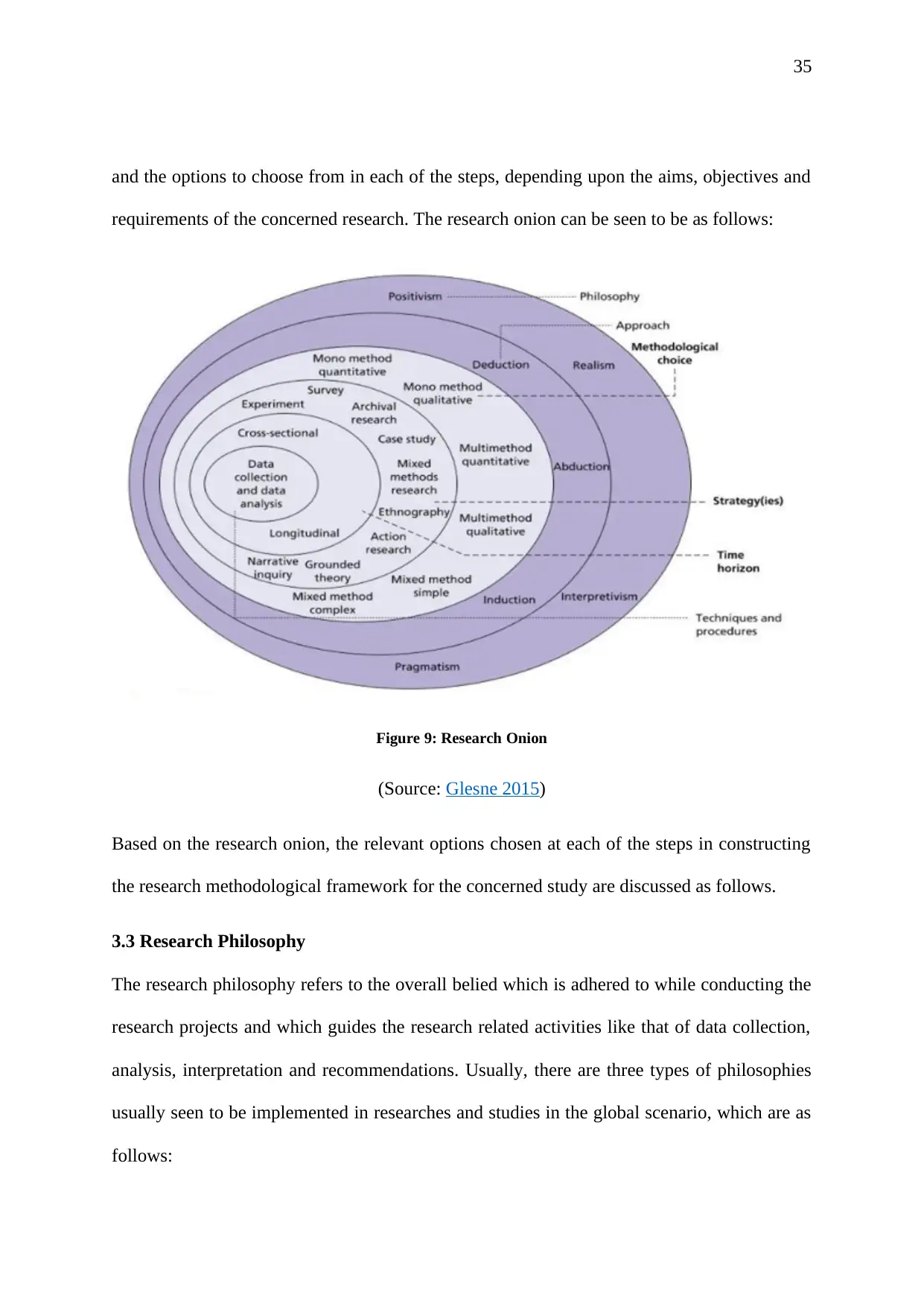
and the options to choose from in each of the steps, depending upon the aims, objectives and
requirements of the concerned research. The research onion can be seen to be as follows:
Figure 9: Research Onion
(Source: Glesne 2015)
Based on the research onion, the relevant options chosen at each of the steps in constructing
the research methodological framework for the concerned study are discussed as follows.
3.3 Research Philosophy
The research philosophy refers to the overall belied which is adhered to while conducting the
research projects and which guides the research related activities like that of data collection,
analysis, interpretation and recommendations. Usually, there are three types of philosophies
usually seen to be implemented in researches and studies in the global scenario, which are as
follows:
You're viewing a preview
Unlock full access by subscribing today!

Figure 10: Types of Philosophies in Research
(Source: Created by Author)
The Positivism philosophy has the provision of forming hypotheses and testing them to see
the relevance of the same. However, the same is primarily used for quantitative and cardinal
studies. The Realism philosophy, on the other hand, facilitates both quantitative and
qualitative studies regarding an issue of concern. The Interpretivism philosophy helps the
researchers to conduct in-depth and wide studies regarding the issues which the same aim to
examine (Brinkmann 2014).
Keeping this into consideration, the concerned research adapts the Realism research
philosophy to incorporate both qualitative as well as quantitative aspects regarding the
impacts of fear and stress on the outcomes of projects in the information technology industry.
3.4 Research Design
The systematic methods which are used for data collection and analysis, in a particular
research, are termed as research designed, which also, are of three broad types, as shown
below:
Paraphrase This Document
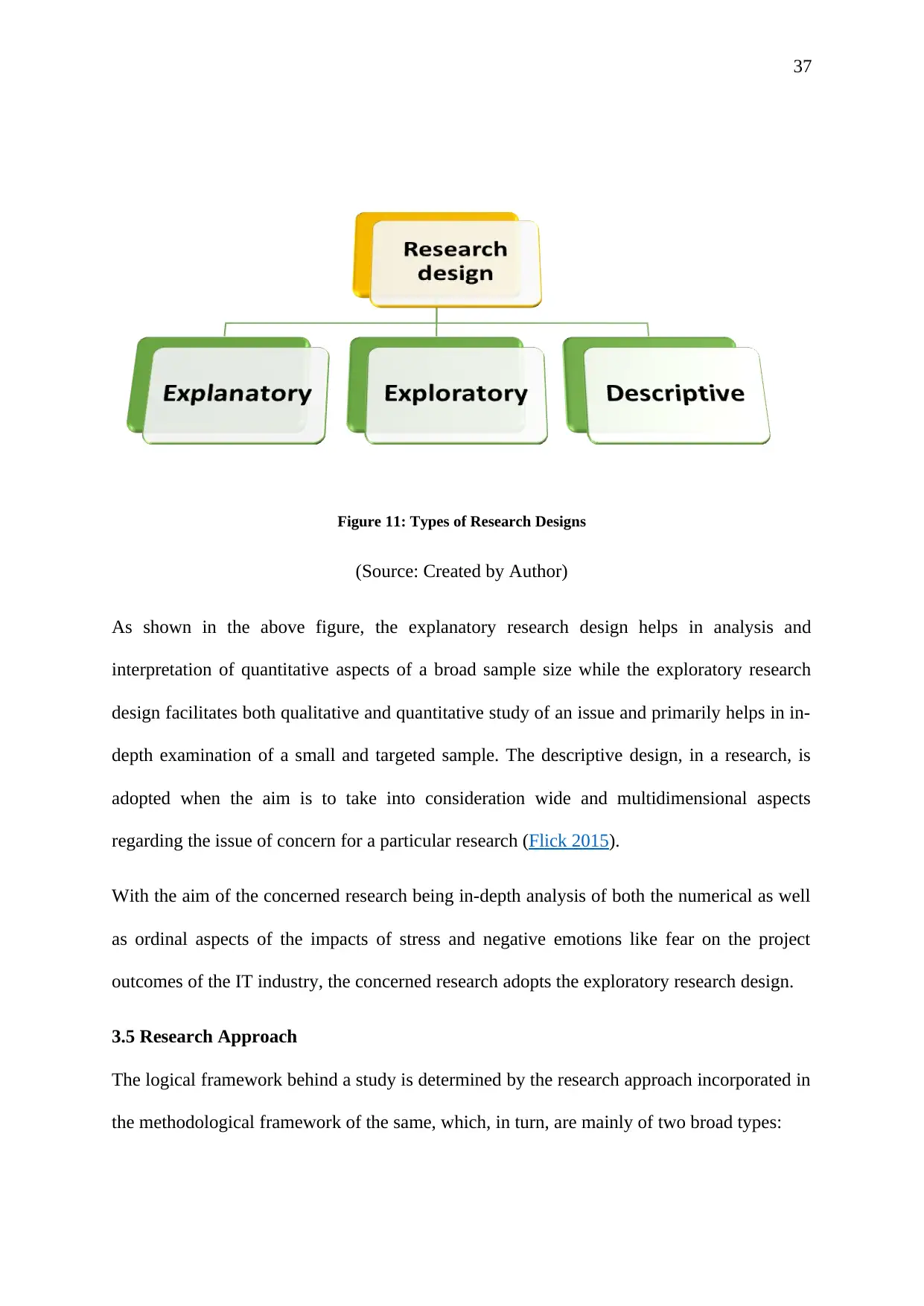
Figure 11: Types of Research Designs
(Source: Created by Author)
As shown in the above figure, the explanatory research design helps in analysis and
interpretation of quantitative aspects of a broad sample size while the exploratory research
design facilitates both qualitative and quantitative study of an issue and primarily helps in in-
depth examination of a small and targeted sample. The descriptive design, in a research, is
adopted when the aim is to take into consideration wide and multidimensional aspects
regarding the issue of concern for a particular research (Flick 2015).
With the aim of the concerned research being in-depth analysis of both the numerical as well
as ordinal aspects of the impacts of stress and negative emotions like fear on the project
outcomes of the IT industry, the concerned research adopts the exploratory research design.
3.5 Research Approach
The logical framework behind a study is determined by the research approach incorporated in
the methodological framework of the same, which, in turn, are mainly of two broad types:
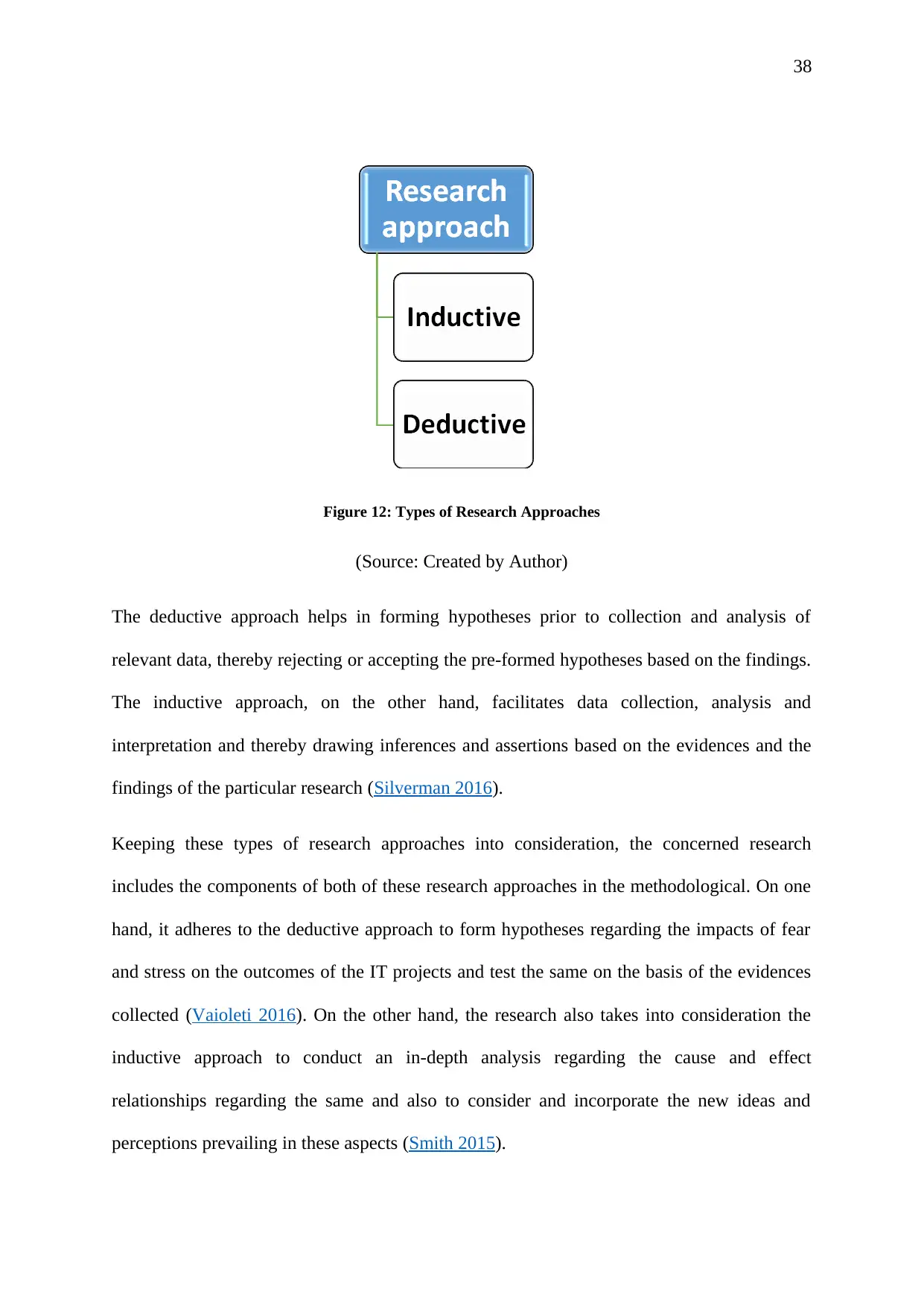
Figure 12: Types of Research Approaches
(Source: Created by Author)
The deductive approach helps in forming hypotheses prior to collection and analysis of
relevant data, thereby rejecting or accepting the pre-formed hypotheses based on the findings.
The inductive approach, on the other hand, facilitates data collection, analysis and
interpretation and thereby drawing inferences and assertions based on the evidences and the
findings of the particular research (Silverman 2016).
Keeping these types of research approaches into consideration, the concerned research
includes the components of both of these research approaches in the methodological. On one
hand, it adheres to the deductive approach to form hypotheses regarding the impacts of fear
and stress on the outcomes of the IT projects and test the same on the basis of the evidences
collected (Vaioleti 2016). On the other hand, the research also takes into consideration the
inductive approach to conduct an in-depth analysis regarding the cause and effect
relationships regarding the same and also to consider and incorporate the new ideas and
perceptions prevailing in these aspects (Smith 2015).
You're viewing a preview
Unlock full access by subscribing today!
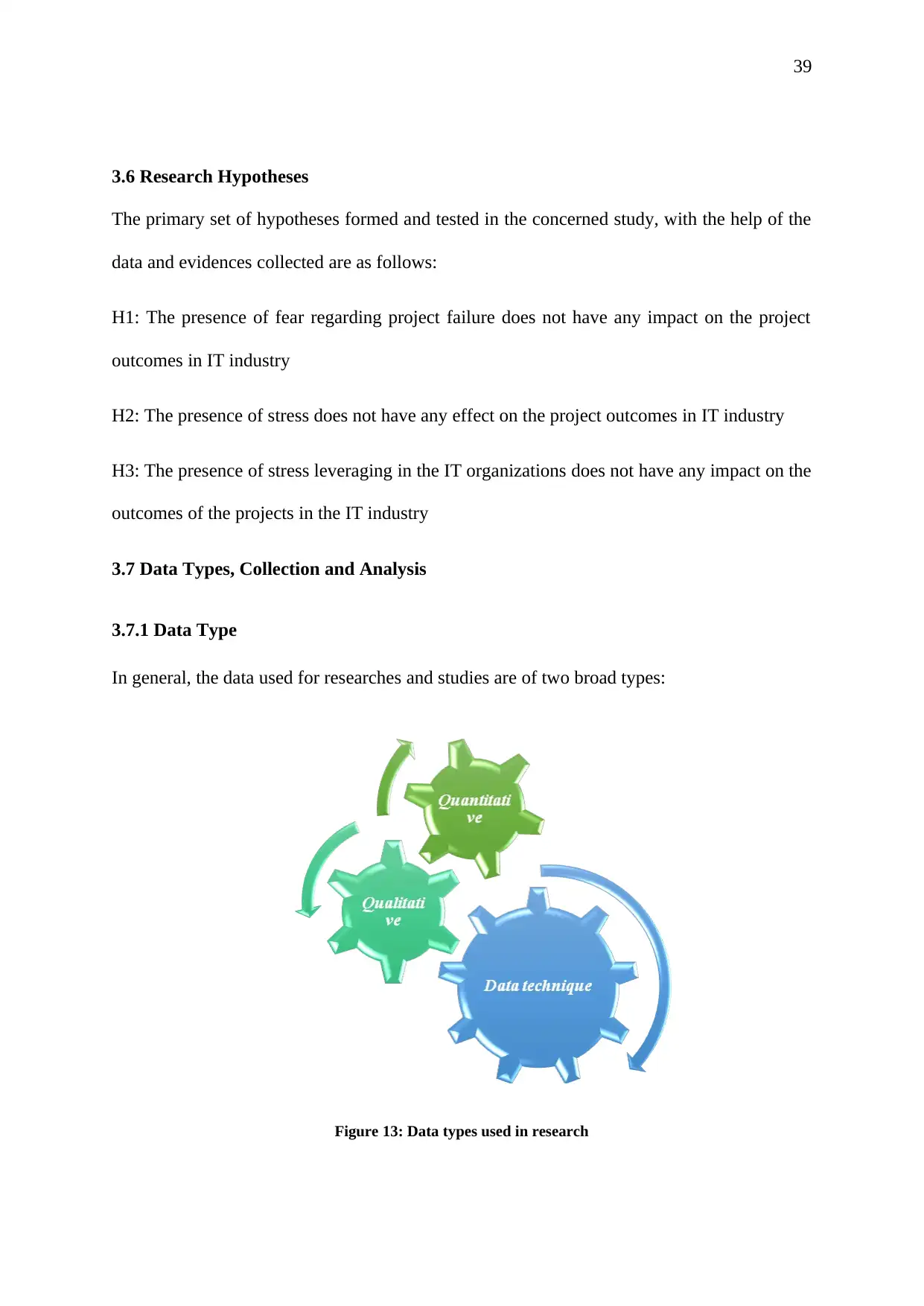
3.6 Research Hypotheses
The primary set of hypotheses formed and tested in the concerned study, with the help of the
data and evidences collected are as follows:
H1: The presence of fear regarding project failure does not have any impact on the project
outcomes in IT industry
H2: The presence of stress does not have any effect on the project outcomes in IT industry
H3: The presence of stress leveraging in the IT organizations does not have any impact on the
outcomes of the projects in the IT industry
3.7 Data Types, Collection and Analysis
3.7.1 Data Type
In general, the data used for researches and studies are of two broad types:
Figure 13: Data types used in research
Paraphrase This Document
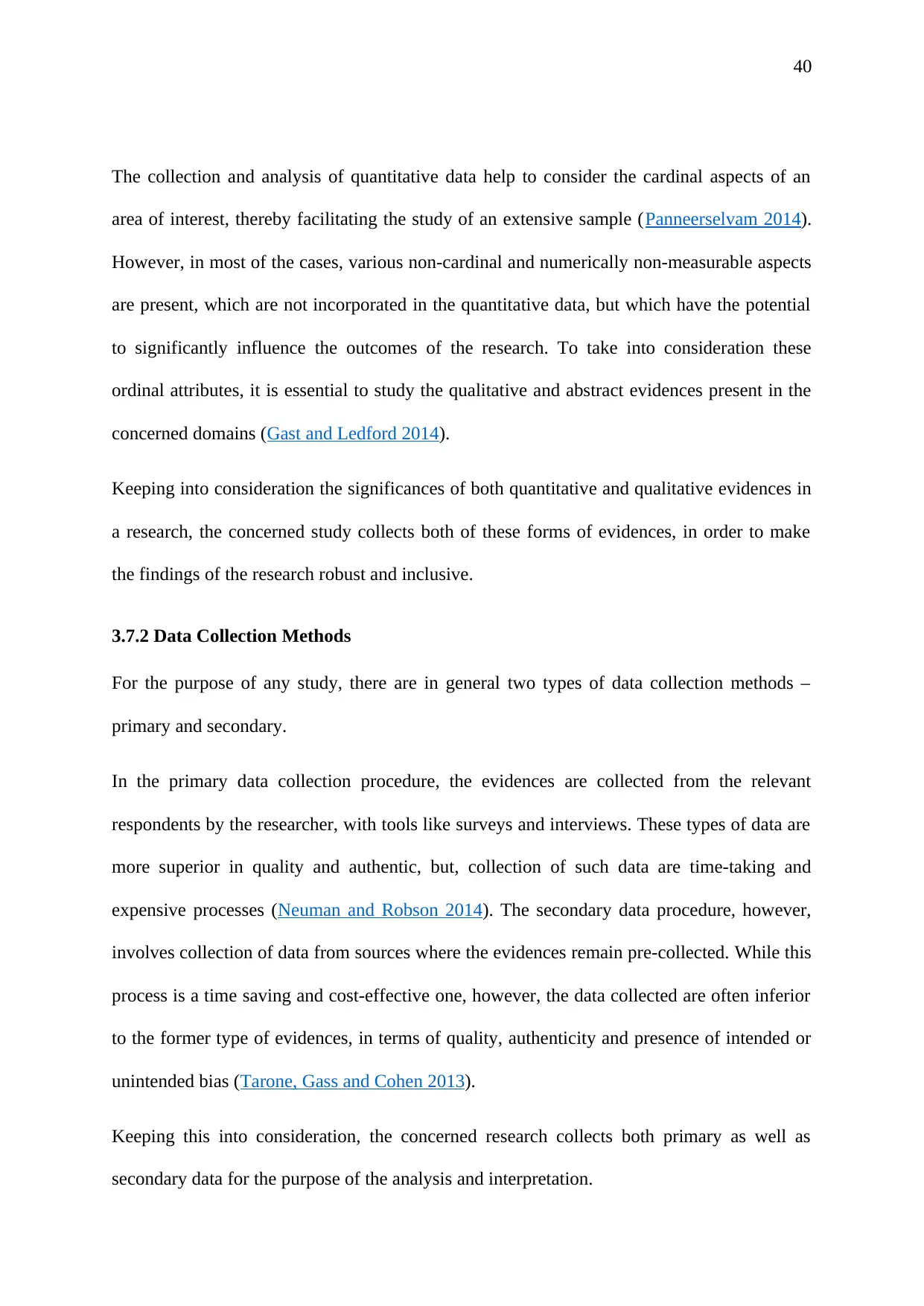
The collection and analysis of quantitative data help to consider the cardinal aspects of an
area of interest, thereby facilitating the study of an extensive sample (Panneerselvam 2014).
However, in most of the cases, various non-cardinal and numerically non-measurable aspects
are present, which are not incorporated in the quantitative data, but which have the potential
to significantly influence the outcomes of the research. To take into consideration these
ordinal attributes, it is essential to study the qualitative and abstract evidences present in the
concerned domains (Gast and Ledford 2014).
Keeping into consideration the significances of both quantitative and qualitative evidences in
a research, the concerned study collects both of these forms of evidences, in order to make
the findings of the research robust and inclusive.
3.7.2 Data Collection Methods
For the purpose of any study, there are in general two types of data collection methods –
primary and secondary.
In the primary data collection procedure, the evidences are collected from the relevant
respondents by the researcher, with tools like surveys and interviews. These types of data are
more superior in quality and authentic, but, collection of such data are time-taking and
expensive processes (Neuman and Robson 2014). The secondary data procedure, however,
involves collection of data from sources where the evidences remain pre-collected. While this
process is a time saving and cost-effective one, however, the data collected are often inferior
to the former type of evidences, in terms of quality, authenticity and presence of intended or
unintended bias (Tarone, Gass and Cohen 2013).
Keeping this into consideration, the concerned research collects both primary as well as
secondary data for the purpose of the analysis and interpretation.
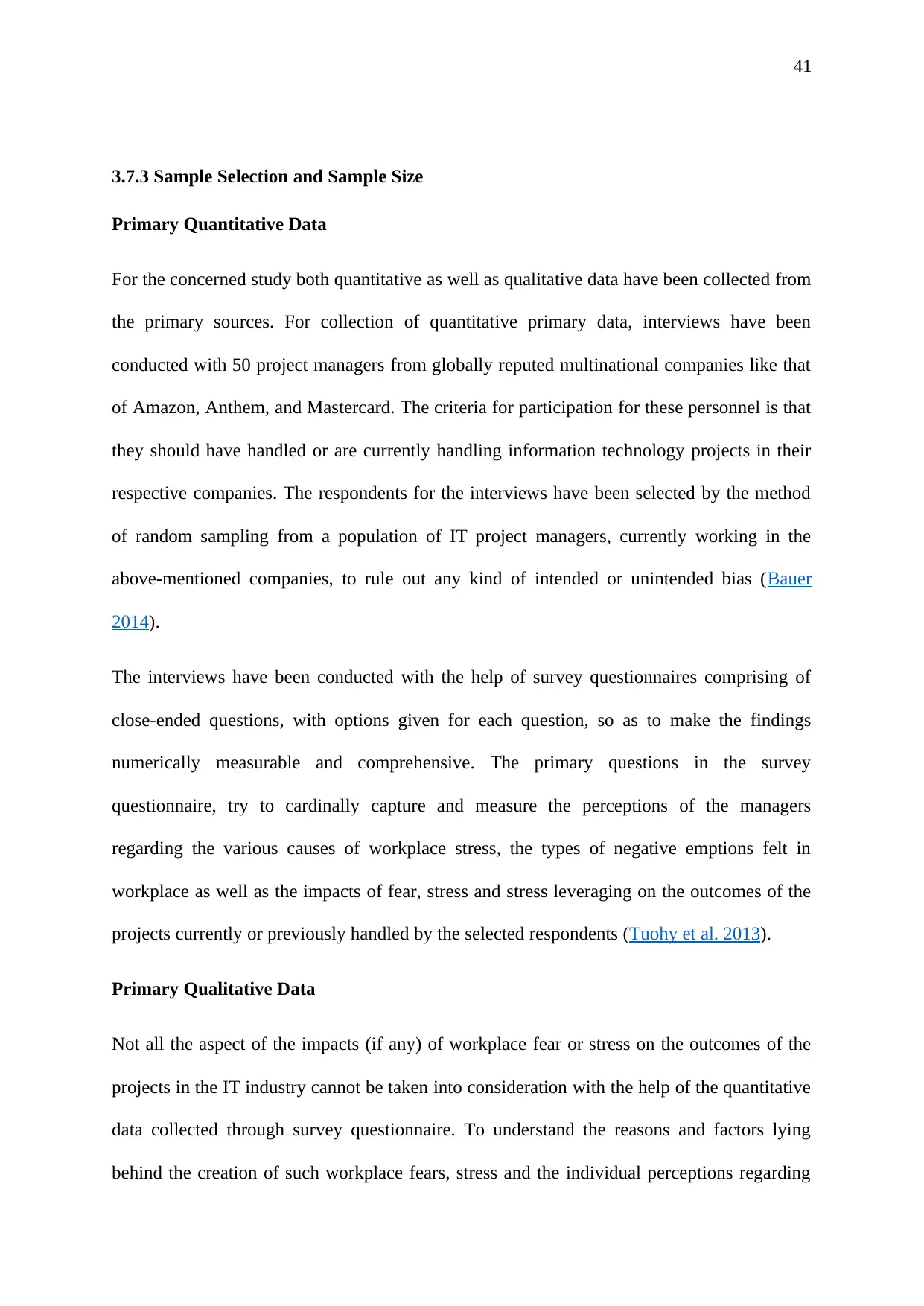
3.7.3 Sample Selection and Sample Size
Primary Quantitative Data
For the concerned study both quantitative as well as qualitative data have been collected from
the primary sources. For collection of quantitative primary data, interviews have been
conducted with 50 project managers from globally reputed multinational companies like that
of Amazon, Anthem, and Mastercard. The criteria for participation for these personnel is that
they should have handled or are currently handling information technology projects in their
respective companies. The respondents for the interviews have been selected by the method
of random sampling from a population of IT project managers, currently working in the
above-mentioned companies, to rule out any kind of intended or unintended bias (Bauer
2014).
The interviews have been conducted with the help of survey questionnaires comprising of
close-ended questions, with options given for each question, so as to make the findings
numerically measurable and comprehensive. The primary questions in the survey
questionnaire, try to cardinally capture and measure the perceptions of the managers
regarding the various causes of workplace stress, the types of negative emptions felt in
workplace as well as the impacts of fear, stress and stress leveraging on the outcomes of the
projects currently or previously handled by the selected respondents (Tuohy et al. 2013).
Primary Qualitative Data
Not all the aspect of the impacts (if any) of workplace fear or stress on the outcomes of the
projects in the IT industry cannot be taken into consideration with the help of the quantitative
data collected through survey questionnaire. To understand the reasons and factors lying
behind the creation of such workplace fears, stress and the individual perceptions regarding
You're viewing a preview
Unlock full access by subscribing today!
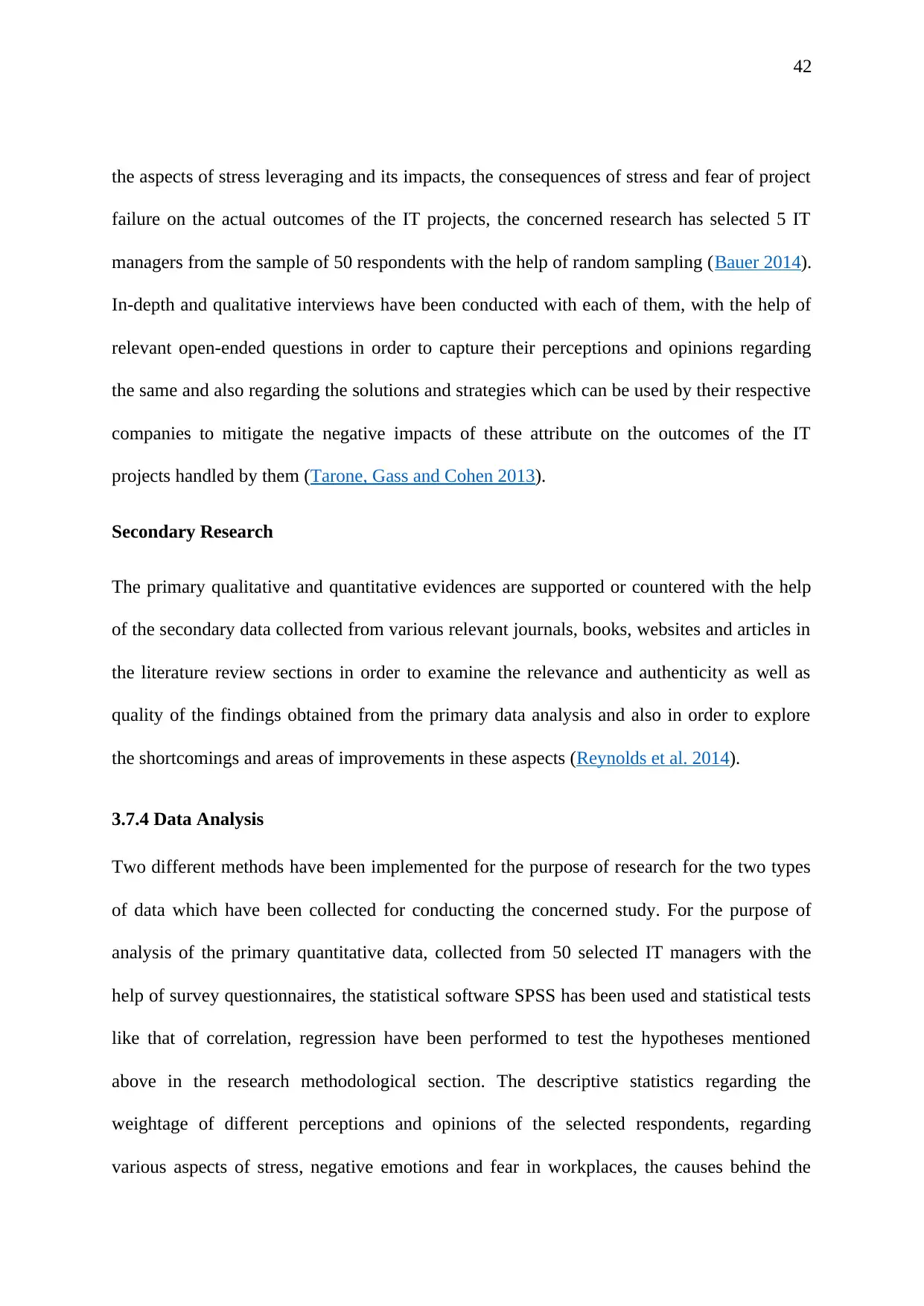
the aspects of stress leveraging and its impacts, the consequences of stress and fear of project
failure on the actual outcomes of the IT projects, the concerned research has selected 5 IT
managers from the sample of 50 respondents with the help of random sampling (Bauer 2014).
In-depth and qualitative interviews have been conducted with each of them, with the help of
relevant open-ended questions in order to capture their perceptions and opinions regarding
the same and also regarding the solutions and strategies which can be used by their respective
companies to mitigate the negative impacts of these attribute on the outcomes of the IT
projects handled by them (Tarone, Gass and Cohen 2013).
Secondary Research
The primary qualitative and quantitative evidences are supported or countered with the help
of the secondary data collected from various relevant journals, books, websites and articles in
the literature review sections in order to examine the relevance and authenticity as well as
quality of the findings obtained from the primary data analysis and also in order to explore
the shortcomings and areas of improvements in these aspects (Reynolds et al. 2014).
3.7.4 Data Analysis
Two different methods have been implemented for the purpose of research for the two types
of data which have been collected for conducting the concerned study. For the purpose of
analysis of the primary quantitative data, collected from 50 selected IT managers with the
help of survey questionnaires, the statistical software SPSS has been used and statistical tests
like that of correlation, regression have been performed to test the hypotheses mentioned
above in the research methodological section. The descriptive statistics regarding the
weightage of different perceptions and opinions of the selected respondents, regarding
various aspects of stress, negative emotions and fear in workplaces, the causes behind the
Paraphrase This Document
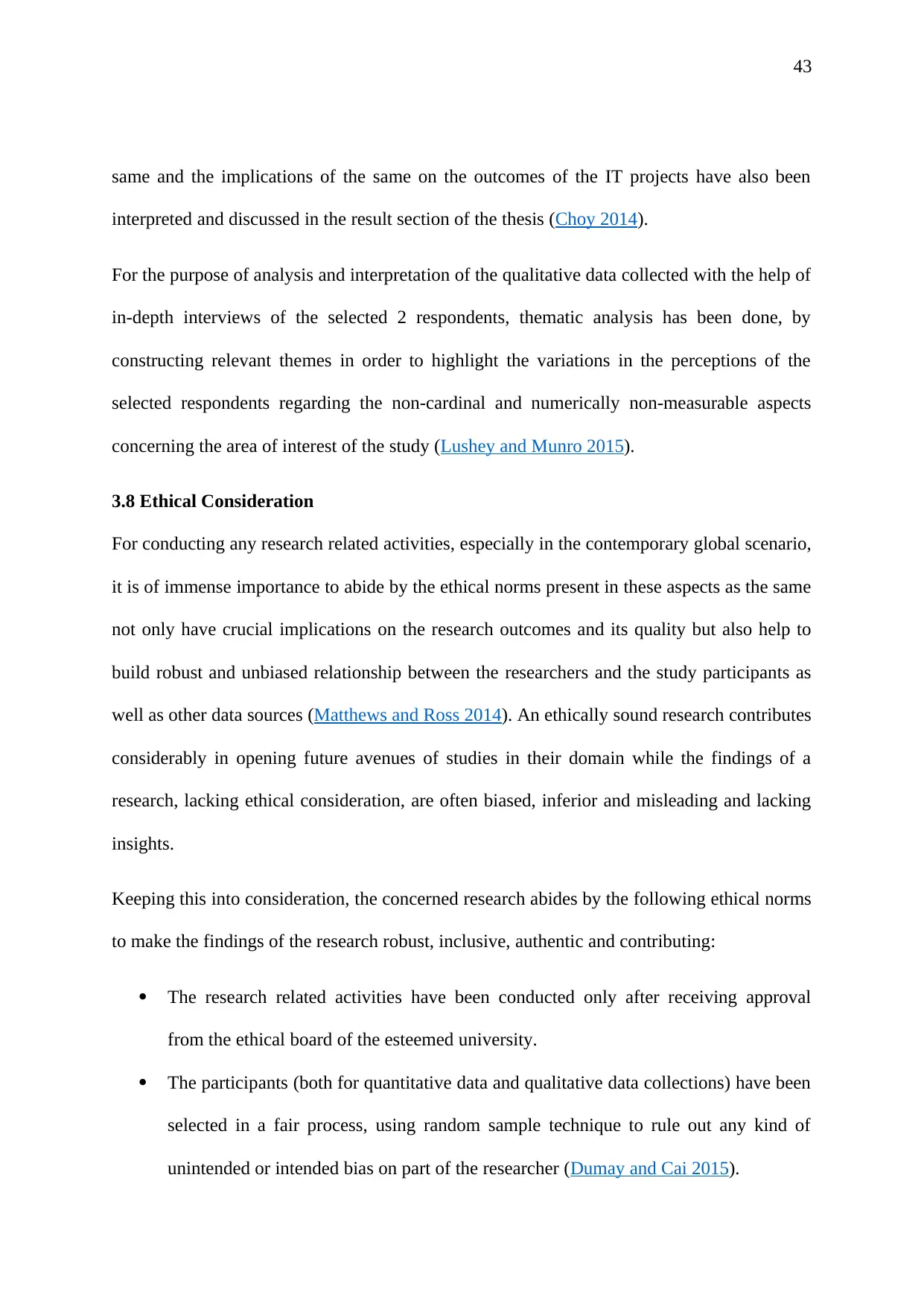
same and the implications of the same on the outcomes of the IT projects have also been
interpreted and discussed in the result section of the thesis (Choy 2014).
For the purpose of analysis and interpretation of the qualitative data collected with the help of
in-depth interviews of the selected 2 respondents, thematic analysis has been done, by
constructing relevant themes in order to highlight the variations in the perceptions of the
selected respondents regarding the non-cardinal and numerically non-measurable aspects
concerning the area of interest of the study (Lushey and Munro 2015).
3.8 Ethical Consideration
For conducting any research related activities, especially in the contemporary global scenario,
it is of immense importance to abide by the ethical norms present in these aspects as the same
not only have crucial implications on the research outcomes and its quality but also help to
build robust and unbiased relationship between the researchers and the study participants as
well as other data sources (Matthews and Ross 2014). An ethically sound research contributes
considerably in opening future avenues of studies in their domain while the findings of a
research, lacking ethical consideration, are often biased, inferior and misleading and lacking
insights.
Keeping this into consideration, the concerned research abides by the following ethical norms
to make the findings of the research robust, inclusive, authentic and contributing:
The research related activities have been conducted only after receiving approval
from the ethical board of the esteemed university.
The participants (both for quantitative data and qualitative data collections) have been
selected in a fair process, using random sample technique to rule out any kind of
unintended or intended bias on part of the researcher (Dumay and Cai 2015).
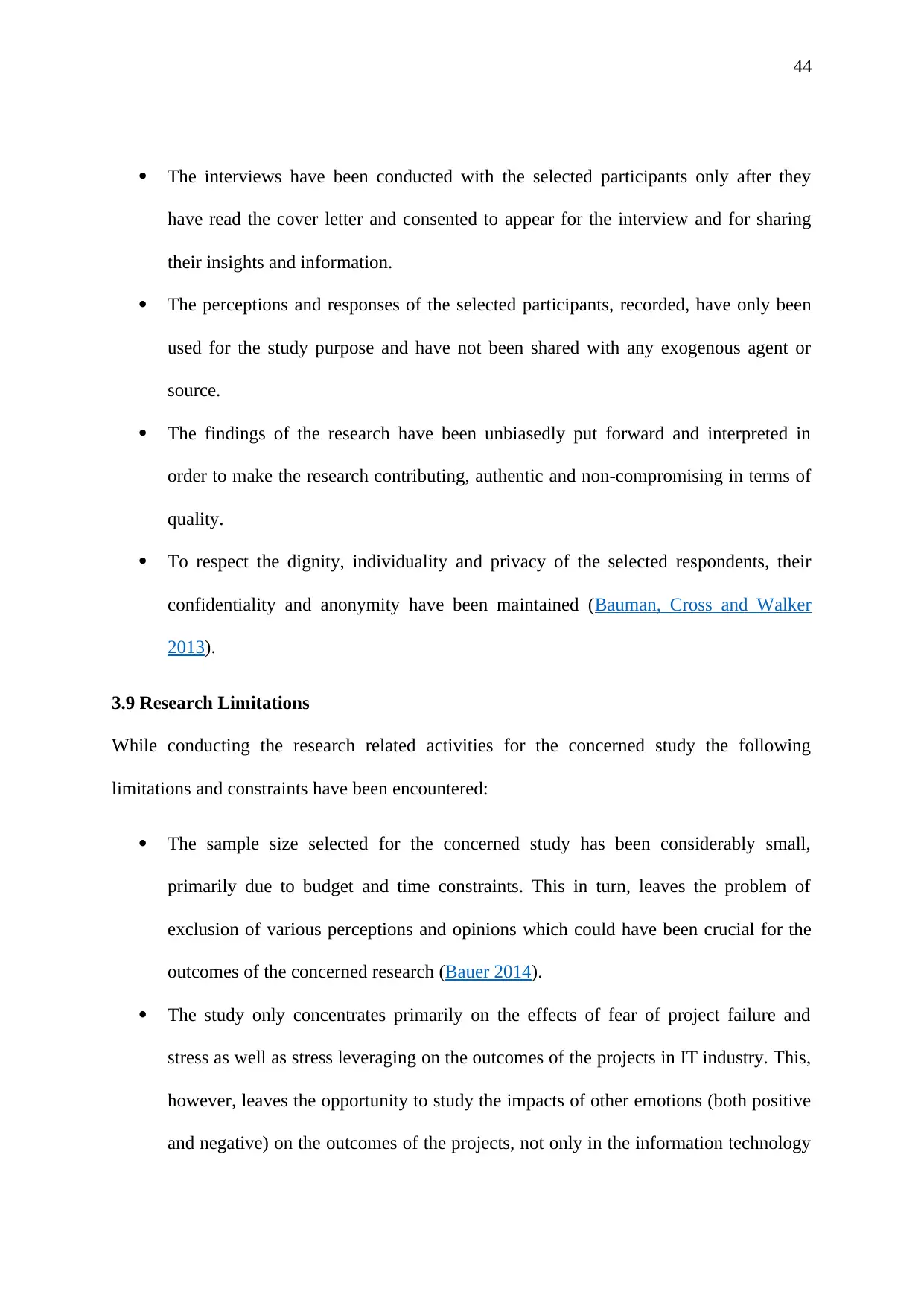
The interviews have been conducted with the selected participants only after they
have read the cover letter and consented to appear for the interview and for sharing
their insights and information.
The perceptions and responses of the selected participants, recorded, have only been
used for the study purpose and have not been shared with any exogenous agent or
source.
The findings of the research have been unbiasedly put forward and interpreted in
order to make the research contributing, authentic and non-compromising in terms of
quality.
To respect the dignity, individuality and privacy of the selected respondents, their
confidentiality and anonymity have been maintained (Bauman, Cross and Walker
2013).
3.9 Research Limitations
While conducting the research related activities for the concerned study the following
limitations and constraints have been encountered:
The sample size selected for the concerned study has been considerably small,
primarily due to budget and time constraints. This in turn, leaves the problem of
exclusion of various perceptions and opinions which could have been crucial for the
outcomes of the concerned research (Bauer 2014).
The study only concentrates primarily on the effects of fear of project failure and
stress as well as stress leveraging on the outcomes of the projects in IT industry. This,
however, leaves the opportunity to study the impacts of other emotions (both positive
and negative) on the outcomes of the projects, not only in the information technology
You're viewing a preview
Unlock full access by subscribing today!
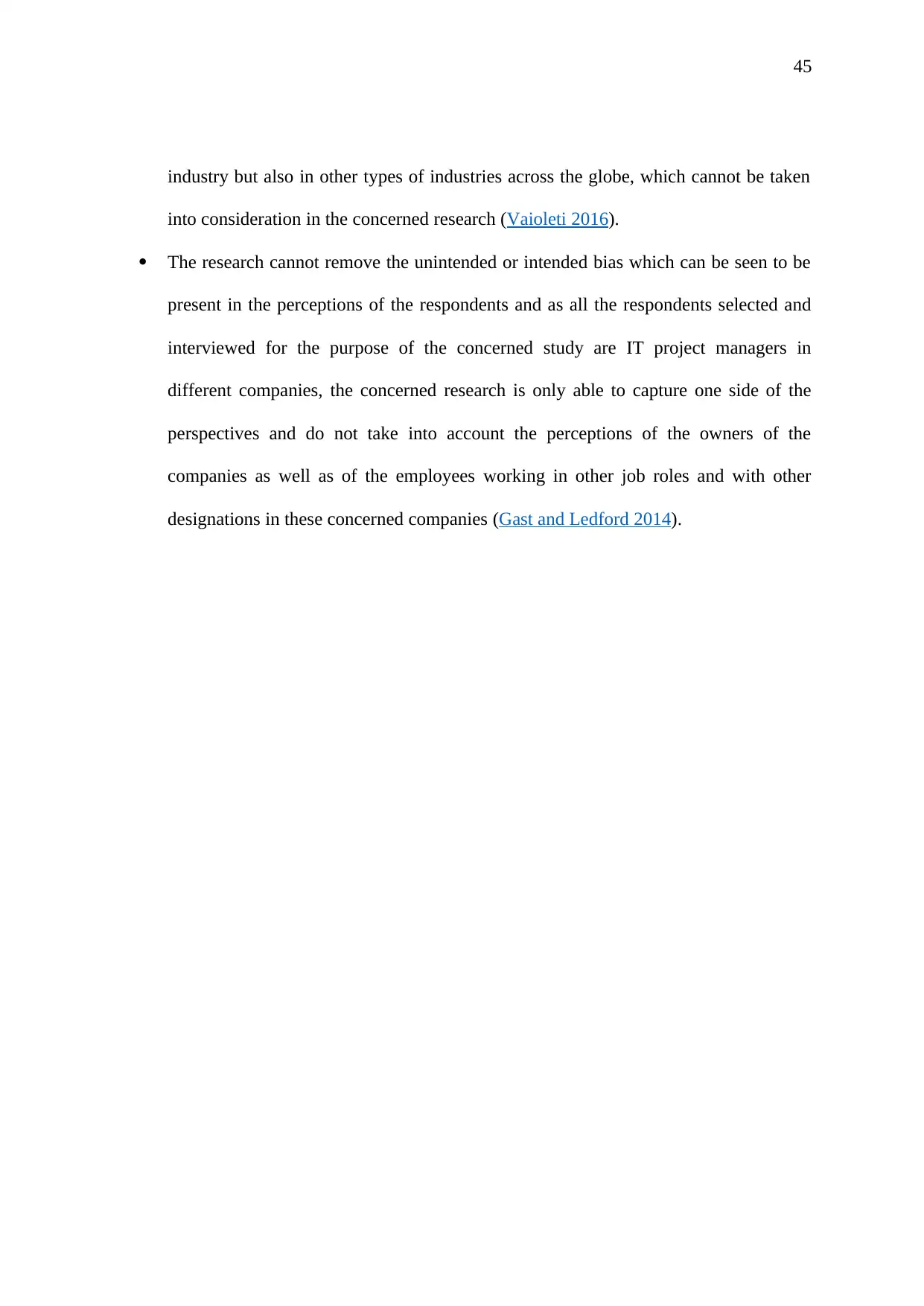
industry but also in other types of industries across the globe, which cannot be taken
into consideration in the concerned research (Vaioleti 2016).
The research cannot remove the unintended or intended bias which can be seen to be
present in the perceptions of the respondents and as all the respondents selected and
interviewed for the purpose of the concerned study are IT project managers in
different companies, the concerned research is only able to capture one side of the
perspectives and do not take into account the perceptions of the owners of the
companies as well as of the employees working in other job roles and with other
designations in these concerned companies (Gast and Ledford 2014).
Paraphrase This Document
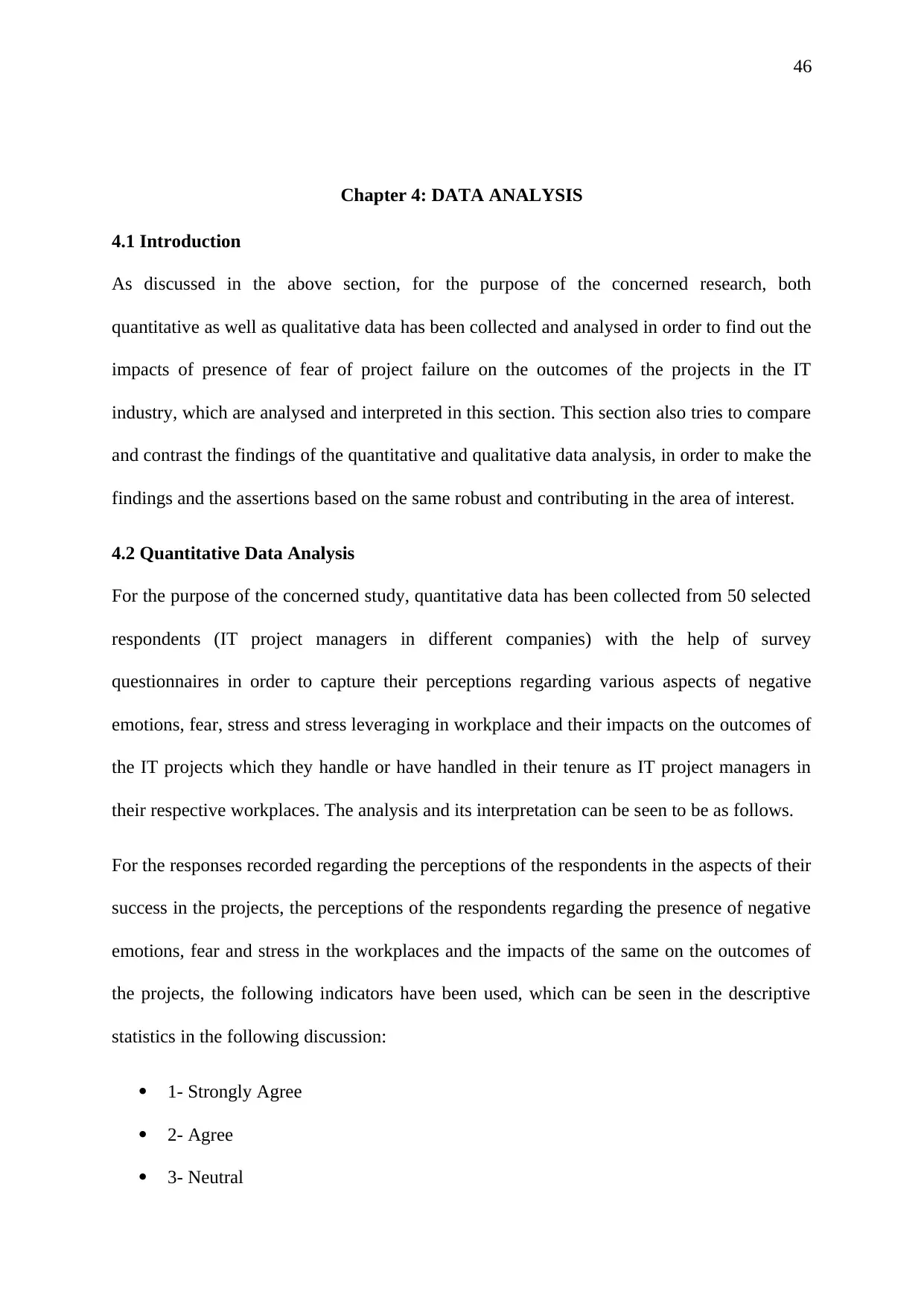
Chapter 4: DATA ANALYSIS
4.1 Introduction
As discussed in the above section, for the purpose of the concerned research, both
quantitative as well as qualitative data has been collected and analysed in order to find out the
impacts of presence of fear of project failure on the outcomes of the projects in the IT
industry, which are analysed and interpreted in this section. This section also tries to compare
and contrast the findings of the quantitative and qualitative data analysis, in order to make the
findings and the assertions based on the same robust and contributing in the area of interest.
4.2 Quantitative Data Analysis
For the purpose of the concerned study, quantitative data has been collected from 50 selected
respondents (IT project managers in different companies) with the help of survey
questionnaires in order to capture their perceptions regarding various aspects of negative
emotions, fear, stress and stress leveraging in workplace and their impacts on the outcomes of
the IT projects which they handle or have handled in their tenure as IT project managers in
their respective workplaces. The analysis and its interpretation can be seen to be as follows.
For the responses recorded regarding the perceptions of the respondents in the aspects of their
success in the projects, the perceptions of the respondents regarding the presence of negative
emotions, fear and stress in the workplaces and the impacts of the same on the outcomes of
the projects, the following indicators have been used, which can be seen in the descriptive
statistics in the following discussion:
1- Strongly Agree
2- Agree
3- Neutral

4- Disagree
5- Strongly Disagree
4.2.1 Demographic Characteristics of the selected respondents
The demographic characteristics of the selected sample of respondents can be seen to be as
follows:
a. Age of the respondents
To observe the age distribution of the respondents, the same are clubbed under different age
groups, which yield the following result:
Figure 14: Age distribution of the selected respondents
You're viewing a preview
Unlock full access by subscribing today!
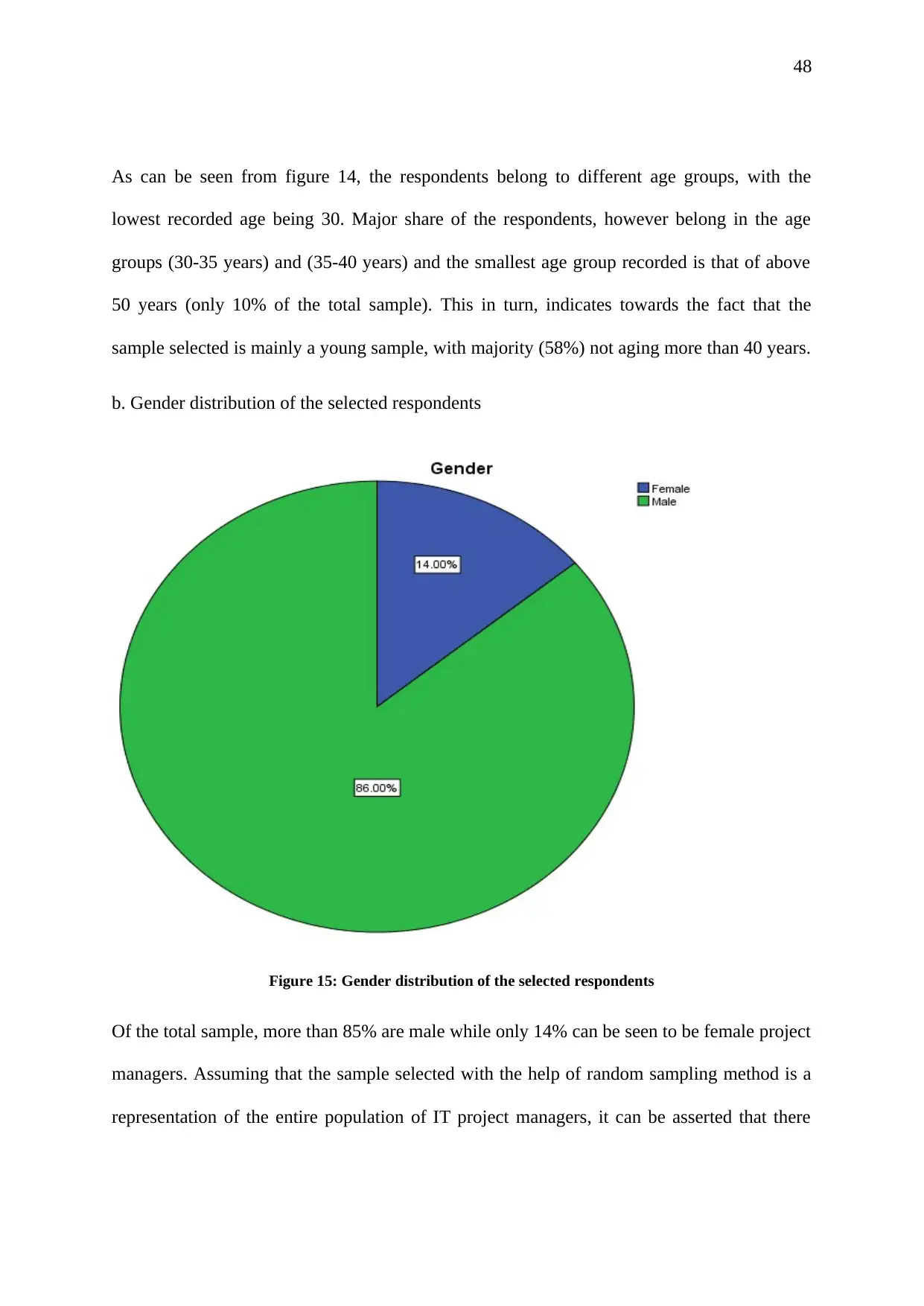
As can be seen from figure 14, the respondents belong to different age groups, with the
lowest recorded age being 30. Major share of the respondents, however belong in the age
groups (30-35 years) and (35-40 years) and the smallest age group recorded is that of above
50 years (only 10% of the total sample). This in turn, indicates towards the fact that the
sample selected is mainly a young sample, with majority (58%) not aging more than 40 years.
b. Gender distribution of the selected respondents
Figure 15: Gender distribution of the selected respondents
Of the total sample, more than 85% are male while only 14% can be seen to be female project
managers. Assuming that the sample selected with the help of random sampling method is a
representation of the entire population of IT project managers, it can be asserted that there
Paraphrase This Document
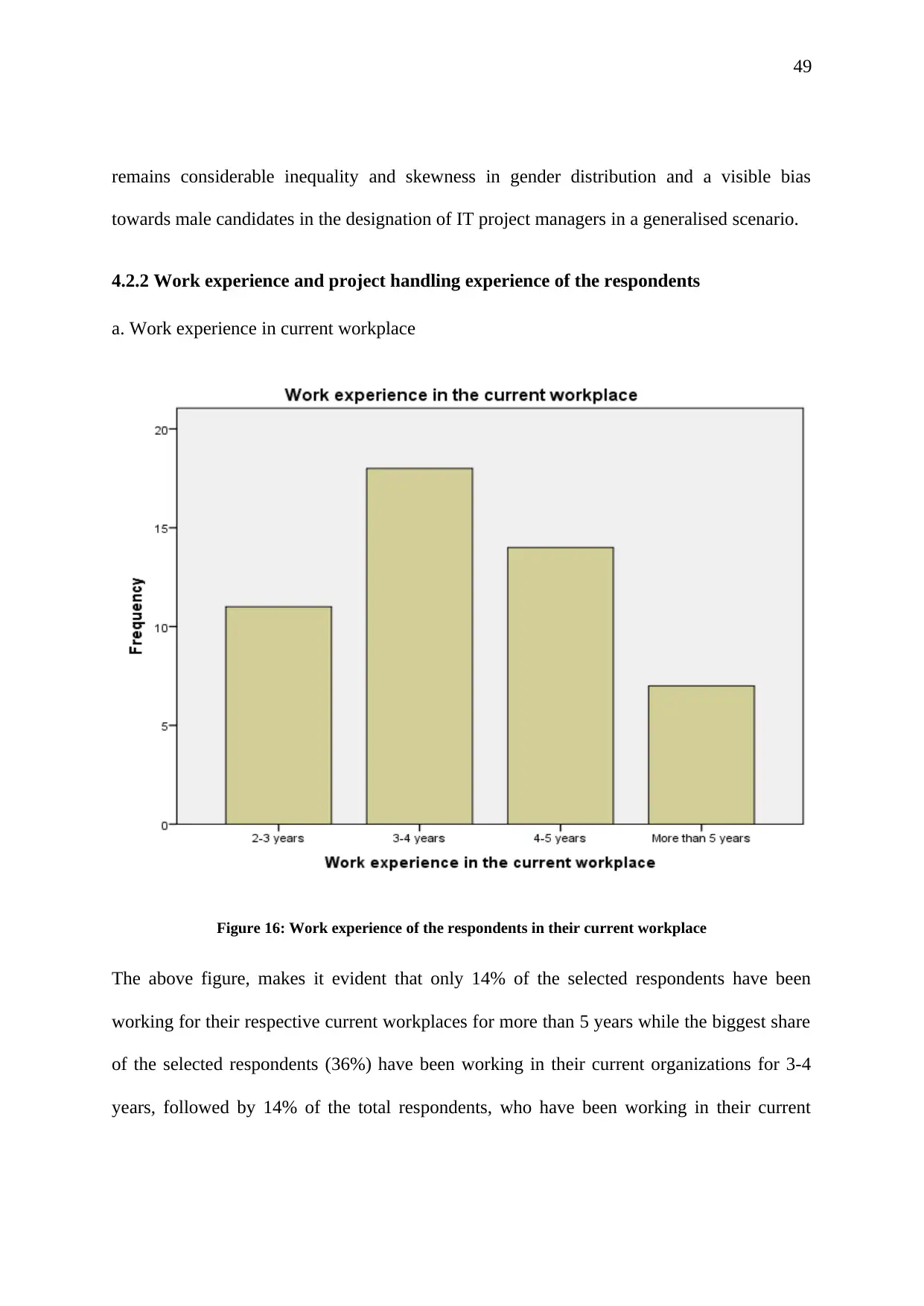
remains considerable inequality and skewness in gender distribution and a visible bias
towards male candidates in the designation of IT project managers in a generalised scenario.
4.2.2 Work experience and project handling experience of the respondents
a. Work experience in current workplace
Figure 16: Work experience of the respondents in their current workplace
The above figure, makes it evident that only 14% of the selected respondents have been
working for their respective current workplaces for more than 5 years while the biggest share
of the selected respondents (36%) have been working in their current organizations for 3-4
years, followed by 14% of the total respondents, who have been working in their current
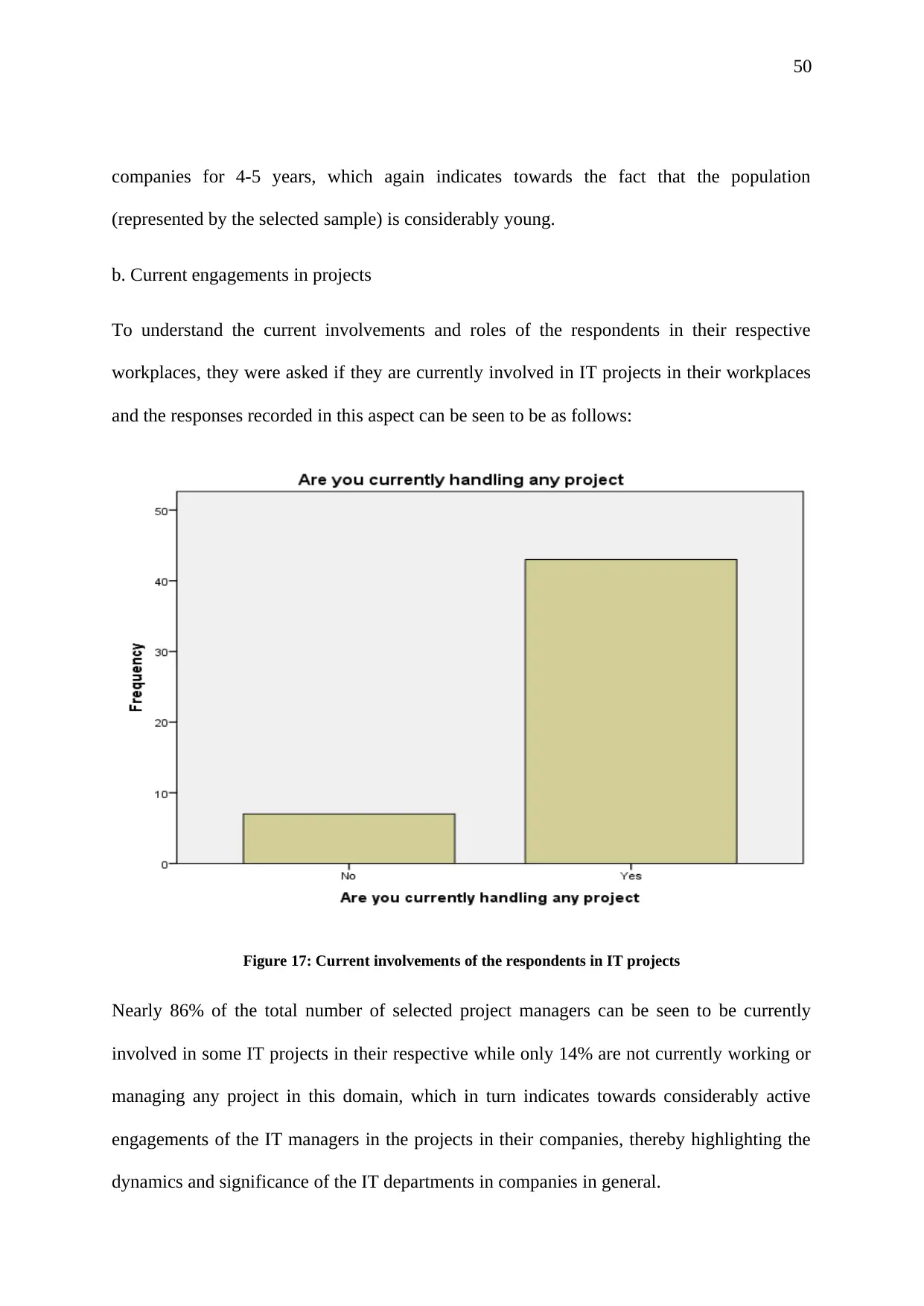
companies for 4-5 years, which again indicates towards the fact that the population
(represented by the selected sample) is considerably young.
b. Current engagements in projects
To understand the current involvements and roles of the respondents in their respective
workplaces, they were asked if they are currently involved in IT projects in their workplaces
and the responses recorded in this aspect can be seen to be as follows:
Figure 17: Current involvements of the respondents in IT projects
Nearly 86% of the total number of selected project managers can be seen to be currently
involved in some IT projects in their respective while only 14% are not currently working or
managing any project in this domain, which in turn indicates towards considerably active
engagements of the IT managers in the projects in their companies, thereby highlighting the
dynamics and significance of the IT departments in companies in general.
You're viewing a preview
Unlock full access by subscribing today!
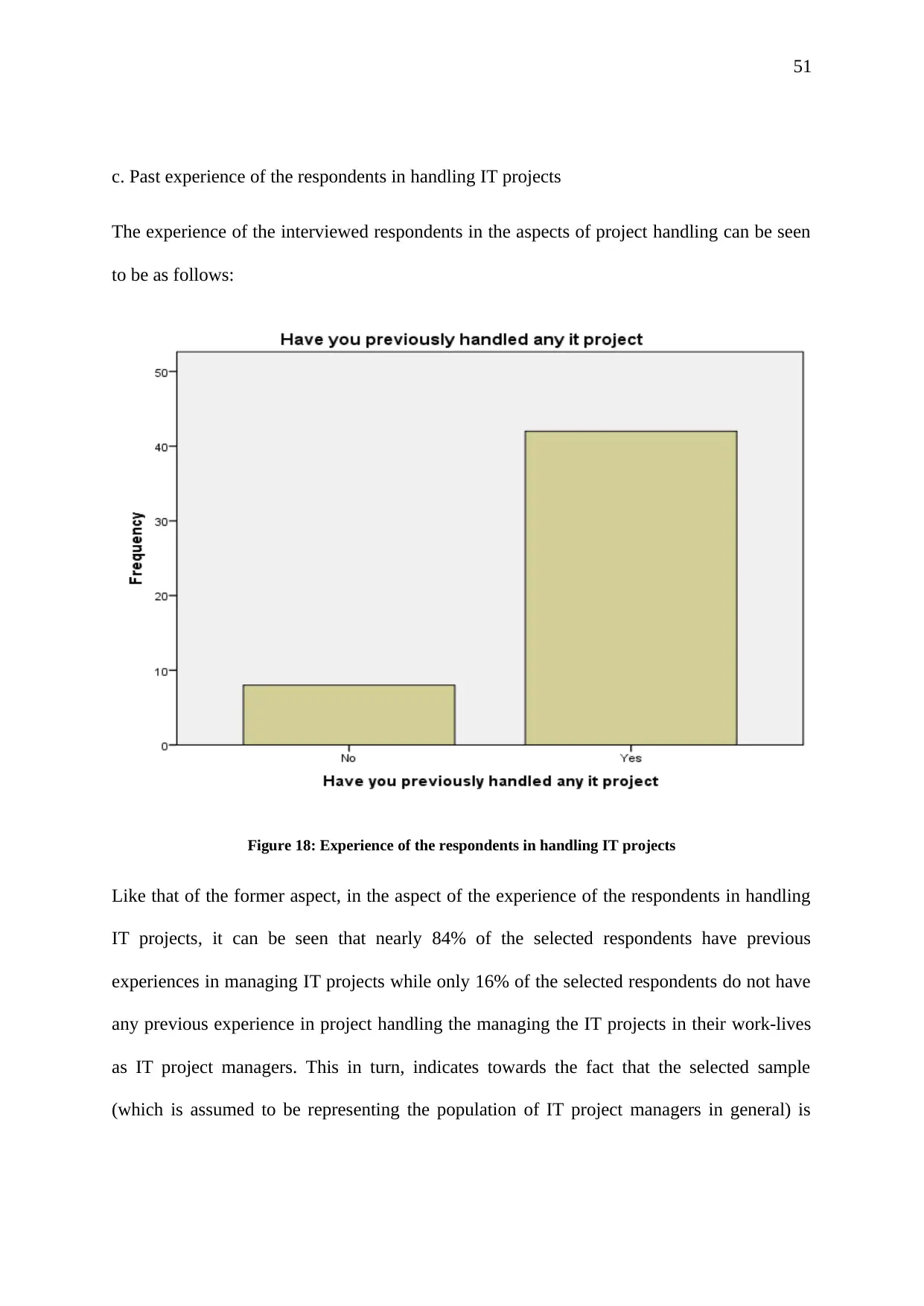
c. Past experience of the respondents in handling IT projects
The experience of the interviewed respondents in the aspects of project handling can be seen
to be as follows:
Figure 18: Experience of the respondents in handling IT projects
Like that of the former aspect, in the aspect of the experience of the respondents in handling
IT projects, it can be seen that nearly 84% of the selected respondents have previous
experiences in managing IT projects while only 16% of the selected respondents do not have
any previous experience in project handling the managing the IT projects in their work-lives
as IT project managers. This in turn, indicates towards the fact that the selected sample
(which is assumed to be representing the population of IT project managers in general) is
Paraphrase This Document
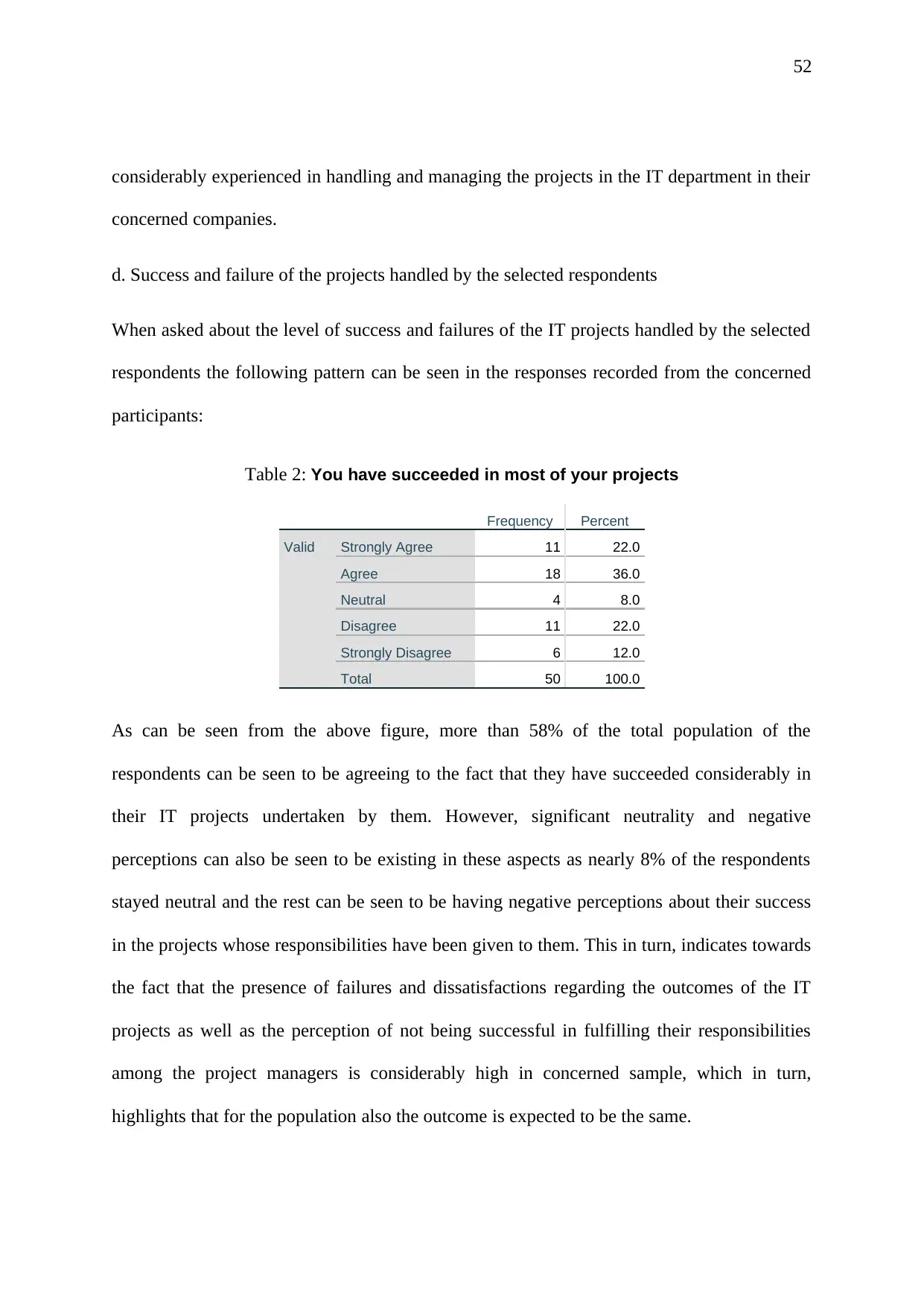
considerably experienced in handling and managing the projects in the IT department in their
concerned companies.
d. Success and failure of the projects handled by the selected respondents
When asked about the level of success and failures of the IT projects handled by the selected
respondents the following pattern can be seen in the responses recorded from the concerned
participants:
Table 2: You have succeeded in most of your projects
Frequency Percent
Valid Strongly Agree 11 22.0
Agree 18 36.0
Neutral 4 8.0
Disagree 11 22.0
Strongly Disagree 6 12.0
Total 50 100.0
As can be seen from the above figure, more than 58% of the total population of the
respondents can be seen to be agreeing to the fact that they have succeeded considerably in
their IT projects undertaken by them. However, significant neutrality and negative
perceptions can also be seen to be existing in these aspects as nearly 8% of the respondents
stayed neutral and the rest can be seen to be having negative perceptions about their success
in the projects whose responsibilities have been given to them. This in turn, indicates towards
the fact that the presence of failures and dissatisfactions regarding the outcomes of the IT
projects as well as the perception of not being successful in fulfilling their responsibilities
among the project managers is considerably high in concerned sample, which in turn,
highlights that for the population also the outcome is expected to be the same.
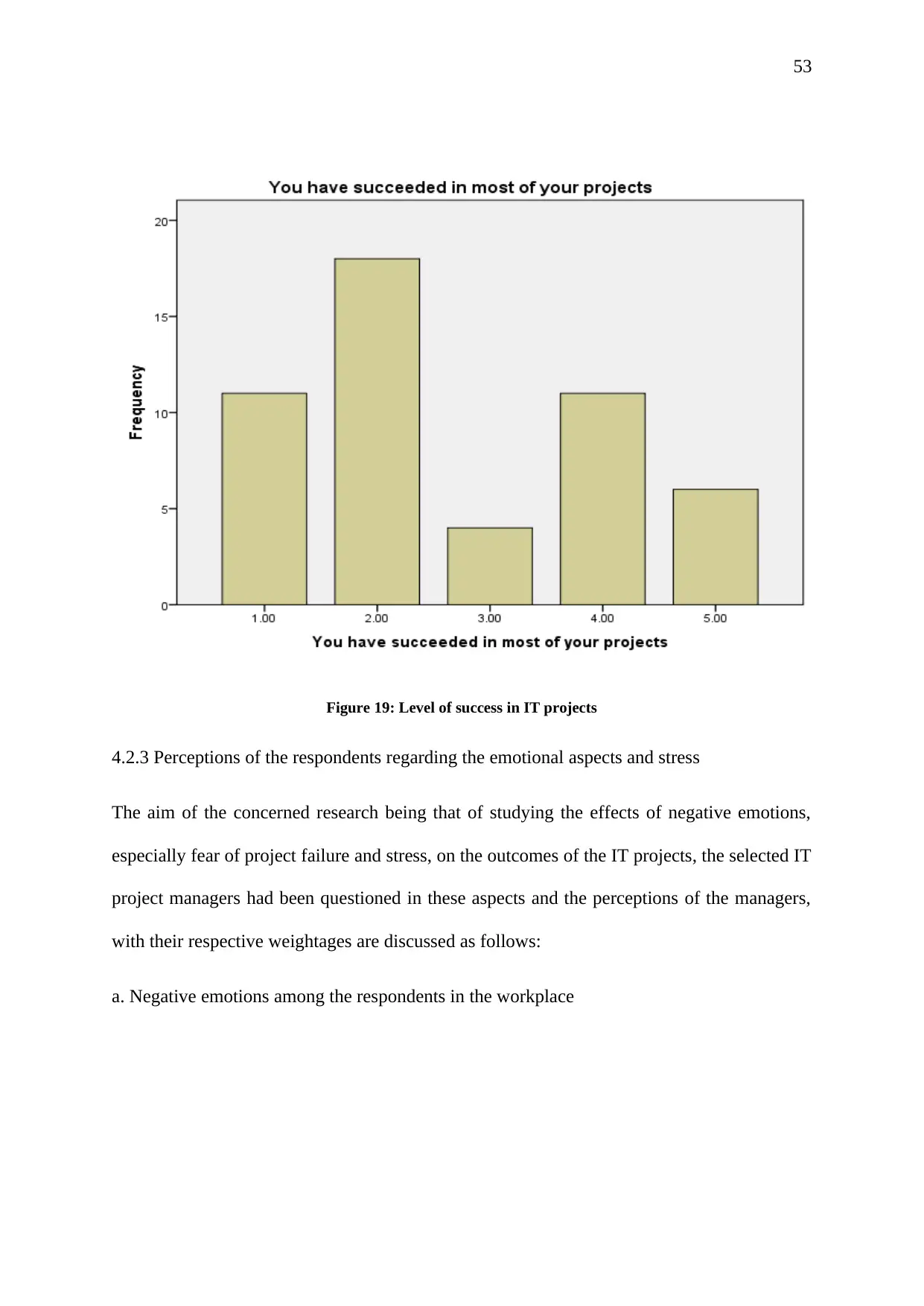
Figure 19: Level of success in IT projects
4.2.3 Perceptions of the respondents regarding the emotional aspects and stress
The aim of the concerned research being that of studying the effects of negative emotions,
especially fear of project failure and stress, on the outcomes of the IT projects, the selected IT
project managers had been questioned in these aspects and the perceptions of the managers,
with their respective weightages are discussed as follows:
a. Negative emotions among the respondents in the workplace
You're viewing a preview
Unlock full access by subscribing today!
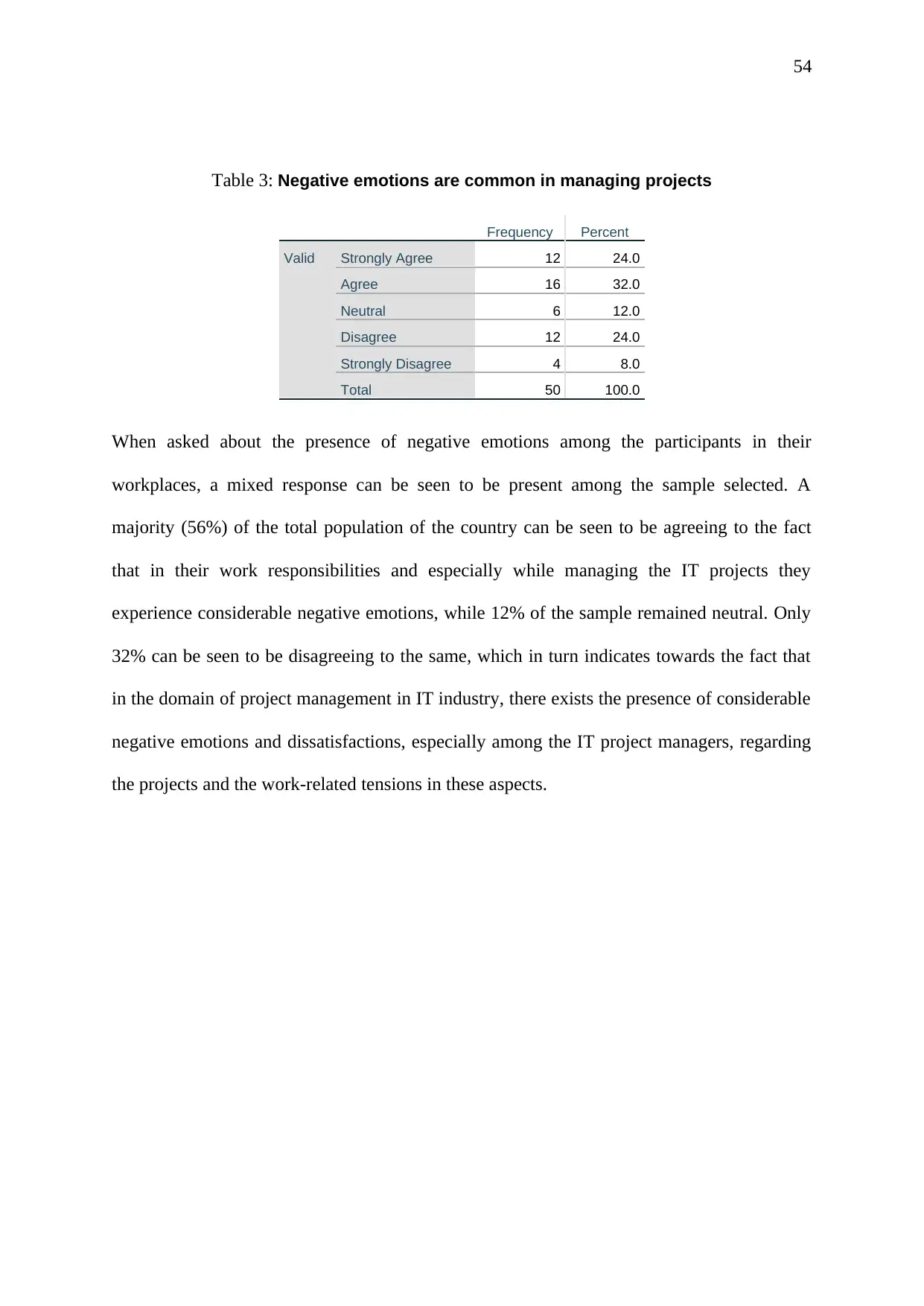
Table 3: Negative emotions are common in managing projects
Frequency Percent
Valid Strongly Agree 12 24.0
Agree 16 32.0
Neutral 6 12.0
Disagree 12 24.0
Strongly Disagree 4 8.0
Total 50 100.0
When asked about the presence of negative emotions among the participants in their
workplaces, a mixed response can be seen to be present among the sample selected. A
majority (56%) of the total population of the country can be seen to be agreeing to the fact
that in their work responsibilities and especially while managing the IT projects they
experience considerable negative emotions, while 12% of the sample remained neutral. Only
32% can be seen to be disagreeing to the same, which in turn indicates towards the fact that
in the domain of project management in IT industry, there exists the presence of considerable
negative emotions and dissatisfactions, especially among the IT project managers, regarding
the projects and the work-related tensions in these aspects.
Paraphrase This Document

Figure 20: Perceptions regarding the presence of negative emptions in managing projects
b. Presence of the fear of failure of projects among the respondents
When asked regarding the presence of fear among the selected IT project managers in the
aspects of handling and managing projects, especially of that of failure of the projects or of
not reaching to the desirable project outcomes the responses received can be seen to be as
follows:
Table 4: You often experience the fear of failure of projects you handle
Frequency Percent
Valid Strongly Agree 7 14.0
Agree 22 44.0
Neutral 7 14.0
Disagree 8 16.0
Strongly Disagree 6 12.0
Total 50 100.0
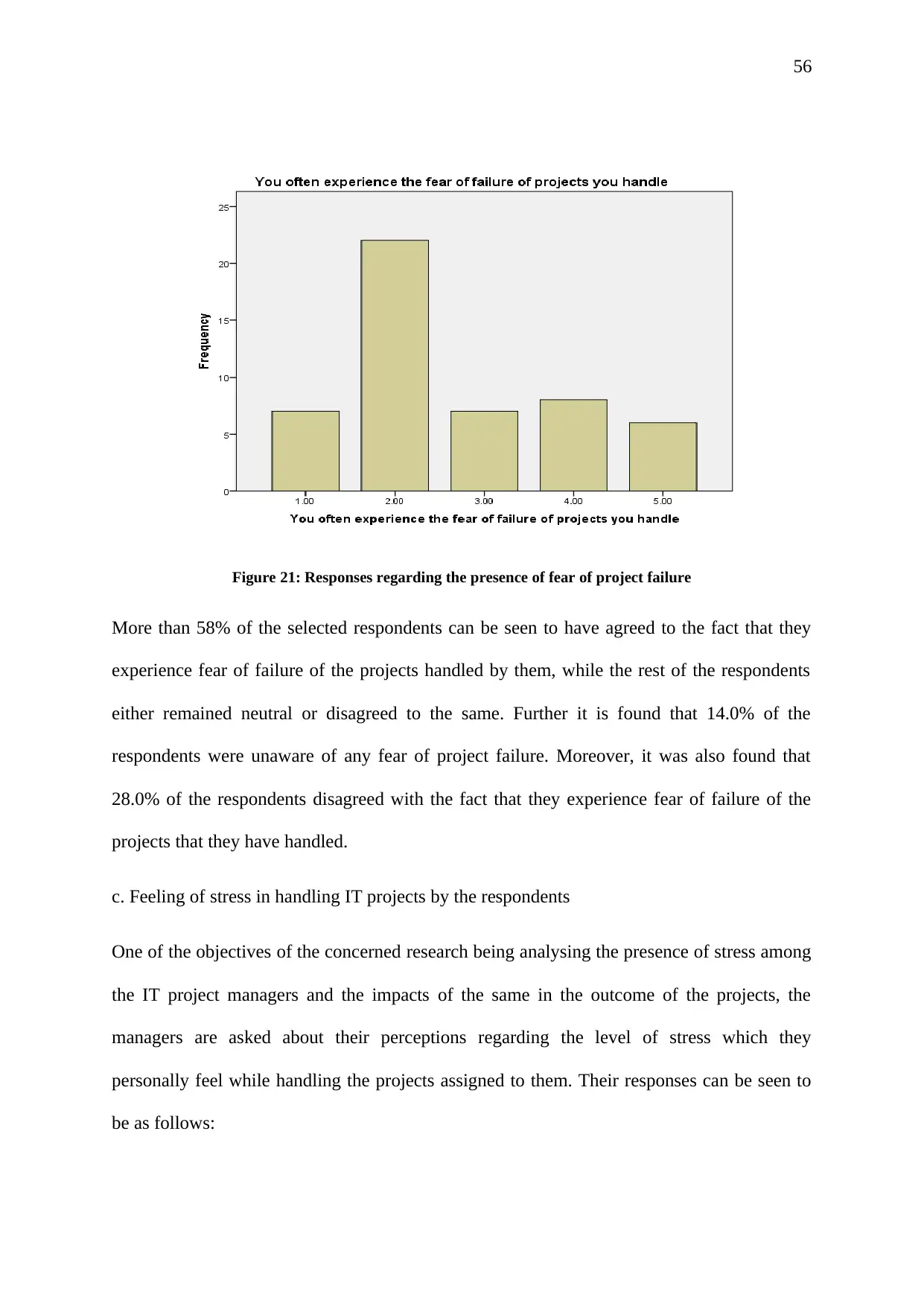
Figure 21: Responses regarding the presence of fear of project failure
More than 58% of the selected respondents can be seen to have agreed to the fact that they
experience fear of failure of the projects handled by them, while the rest of the respondents
either remained neutral or disagreed to the same. Further it is found that 14.0% of the
respondents were unaware of any fear of project failure. Moreover, it was also found that
28.0% of the respondents disagreed with the fact that they experience fear of failure of the
projects that they have handled.
c. Feeling of stress in handling IT projects by the respondents
One of the objectives of the concerned research being analysing the presence of stress among
the IT project managers and the impacts of the same in the outcome of the projects, the
managers are asked about their perceptions regarding the level of stress which they
personally feel while handling the projects assigned to them. Their responses can be seen to
be as follows:
You're viewing a preview
Unlock full access by subscribing today!

Table 5: You feel high level of stress in handling the projects
Frequency Percent
Valid Strongly Agree 7 14.0
Agree 24 48.0
Neutral 2 4.0
Disagree 11 22.0
Strongly Disagree 6 12.0
Total 50 100.0
Figure 22: Perceptions of the respondents regarding the feeling of high level of stress
The responses received in this aspect can be seen to be highly inclined towards the presence
of high level of stress as more than 60% agreed to the same while the remaining 40% of the
selected respondents either remained neutral or opposed the same. This highlights the
presence of a stressful work environment for the IT project managers in terms of project
handling and management.
Paraphrase This Document

4.2.4 Impacts of fear and stress
The presence of fear and stress are expected to have different types of outcomes for different
respondents. Assuming that the selected IT project managers are questioned about their
responses in the following aspects, which along with the responses obtained are discussed
below:
a. Effects of fear on motivation to work harder
Table 6: Fear of failure motivates you to work harder
Frequency Percent
Valid Strongly Agree 12 24.0
Agree 18 36.0
Neutral 6 12.0
Disagree 10 20.0
Strongly Disagree 4 8.0
Total 50 100.0
When asked about whether the fear of failure of the projects motivate them to work harder,
the selected participants could be seen to be having mixed perceptions. While a majority of
them asserted the same, agreeing to the positive contribution of fear of project failure behind
them putting in more efforts in their works, a smaller yet considerable section also denied the
positive impact of fear on their working motivations. 12% of the respondents remained
neutral in this aspect.
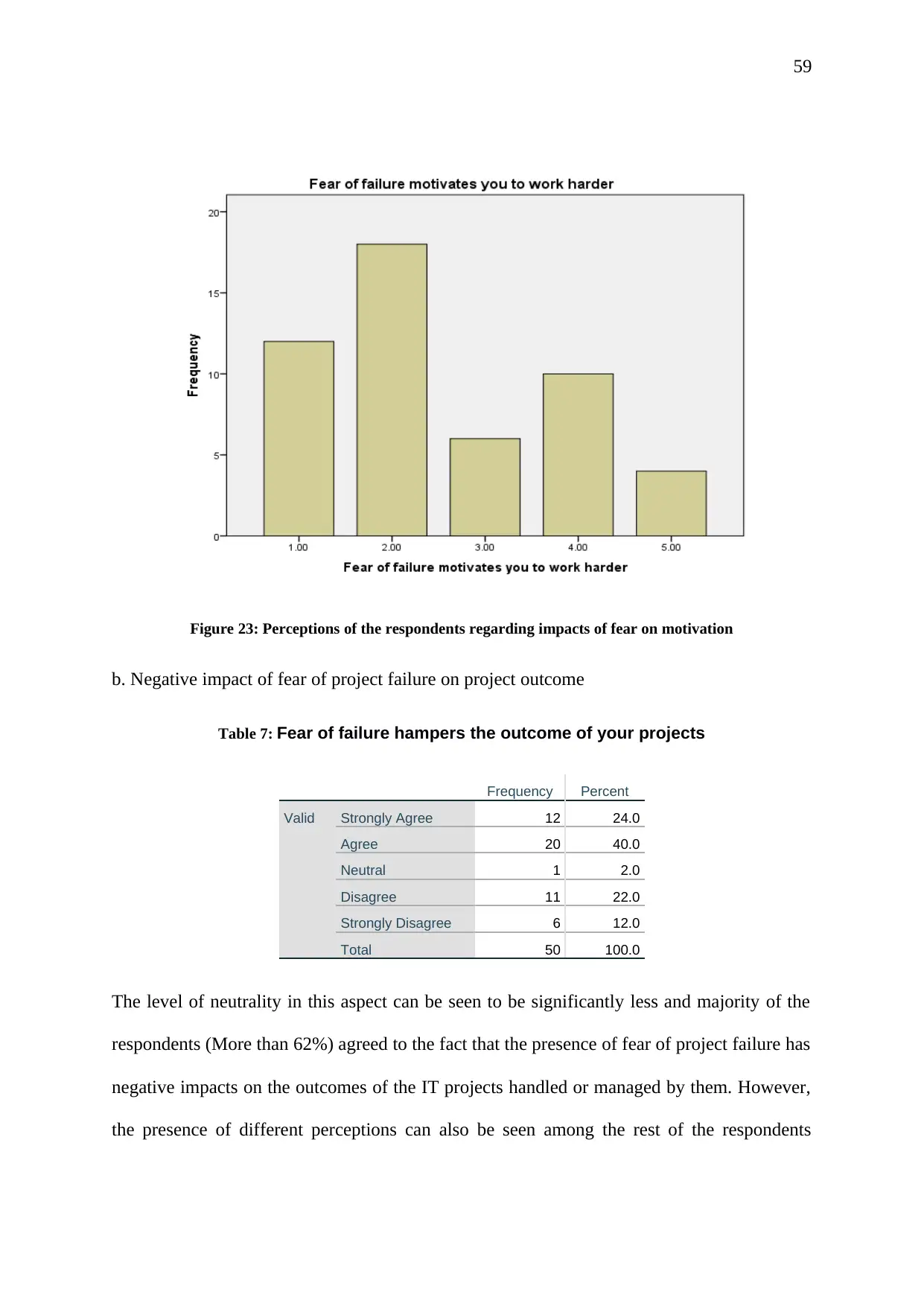
Figure 23: Perceptions of the respondents regarding impacts of fear on motivation
b. Negative impact of fear of project failure on project outcome
Table 7: Fear of failure hampers the outcome of your projects
Frequency Percent
Valid Strongly Agree 12 24.0
Agree 20 40.0
Neutral 1 2.0
Disagree 11 22.0
Strongly Disagree 6 12.0
Total 50 100.0
The level of neutrality in this aspect can be seen to be significantly less and majority of the
respondents (More than 62%) agreed to the fact that the presence of fear of project failure has
negative impacts on the outcomes of the IT projects handled or managed by them. However,
the presence of different perceptions can also be seen among the rest of the respondents
You're viewing a preview
Unlock full access by subscribing today!
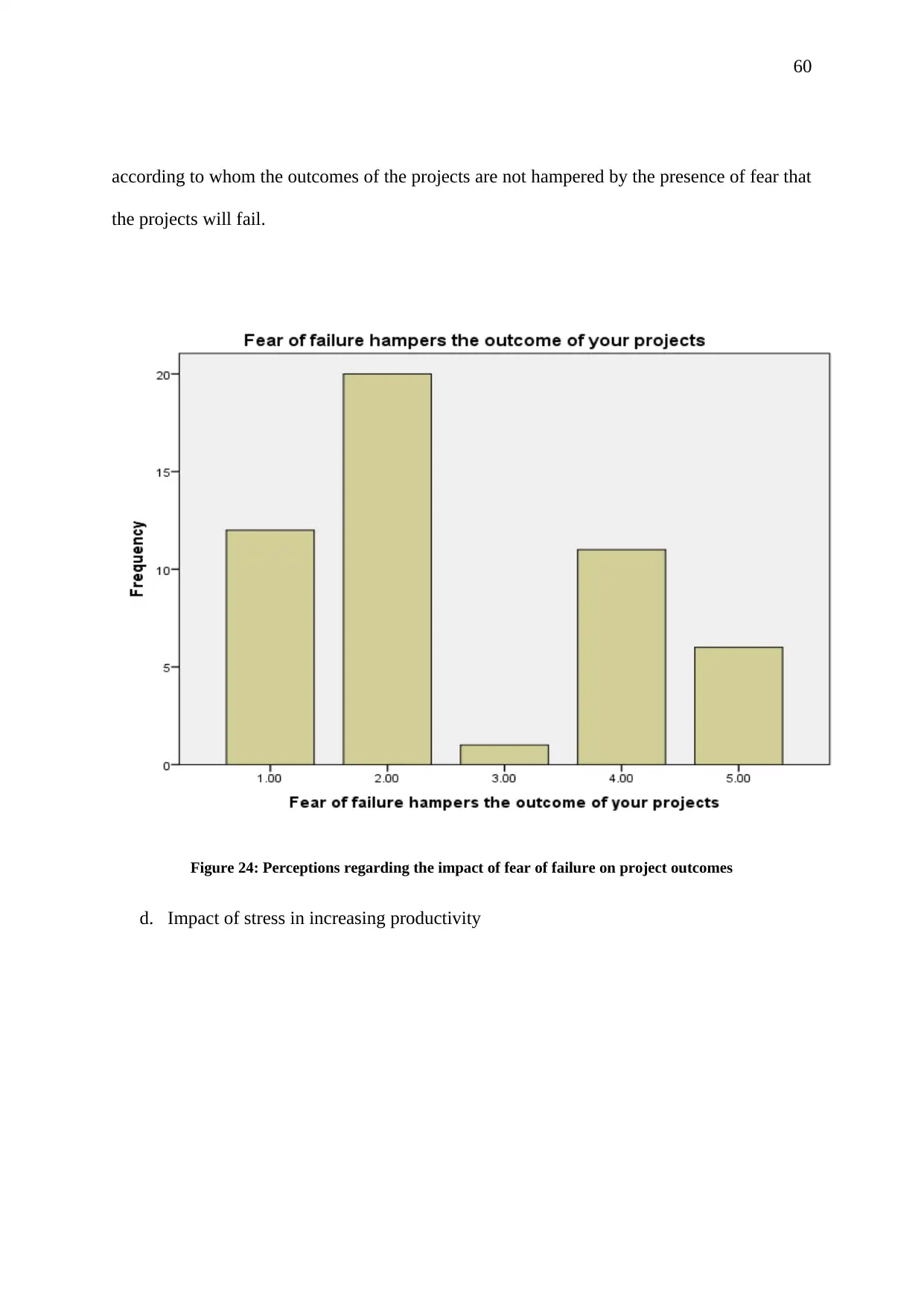
according to whom the outcomes of the projects are not hampered by the presence of fear that
the projects will fail.
Figure 24: Perceptions regarding the impact of fear of failure on project outcomes
d. Impact of stress in increasing productivity
Paraphrase This Document
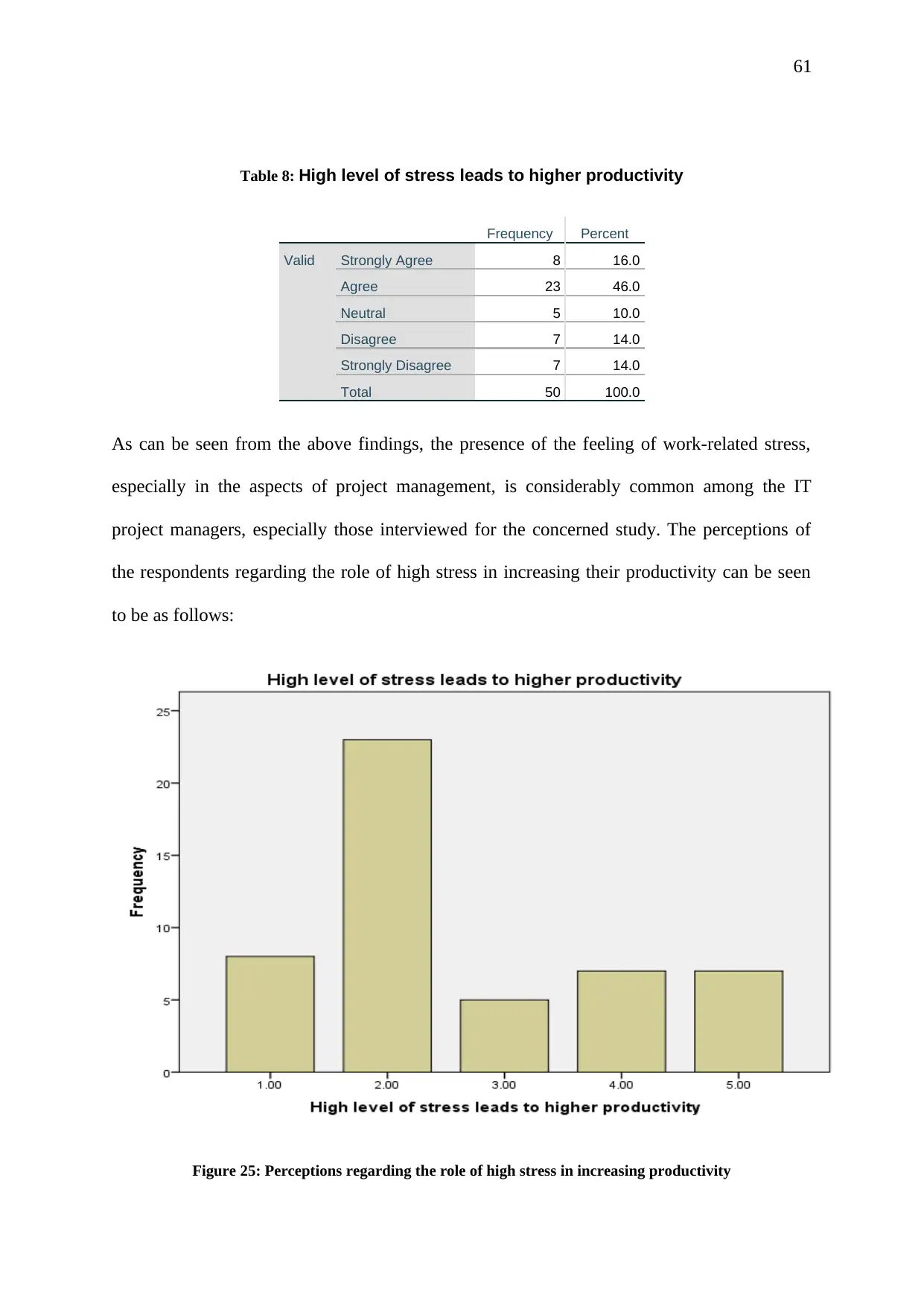
Table 8: High level of stress leads to higher productivity
Frequency Percent
Valid Strongly Agree 8 16.0
Agree 23 46.0
Neutral 5 10.0
Disagree 7 14.0
Strongly Disagree 7 14.0
Total 50 100.0
As can be seen from the above findings, the presence of the feeling of work-related stress,
especially in the aspects of project management, is considerably common among the IT
project managers, especially those interviewed for the concerned study. The perceptions of
the respondents regarding the role of high stress in increasing their productivity can be seen
to be as follows:
Figure 25: Perceptions regarding the role of high stress in increasing productivity

Similar to the previous aspects, in this context also a considerably higher section of the
respondents can be seen to perceive that the presence of high stress levels in the domains of
IT project management and handling, helps in increasing the level of productivity of the
respondents. However, some respondents can be seen to counter this assertion, by disagreeing
to the fact that high stress levels help in increasing their productivity, especially in managing
or handling the projects assigned to them.
d. Negative effects of high stress on project outcomes
Table 9: High stress hampers the outcome of the projects handled by you
Frequency Percent
Valid Strongly Agree 8 16.0
Agree 23 46.0
Neutral 2 4.0
Disagree 10 20.0
Strongly Disagree 7 14.0
Total 50 100.0
A significant share of the selected participants (more than 55%) can be seen to agreeing to the
fact the high level of stress leads to negative implications on the outcomes of the projects
which are handled or managed by them. This can however be seen to be countered by nearly
30% of the total respondents selected for the interview, who tend to perceive that the
outcomes of the project which they handle, are not influenced negatively by the presence of
high level of stress among them.
You're viewing a preview
Unlock full access by subscribing today!
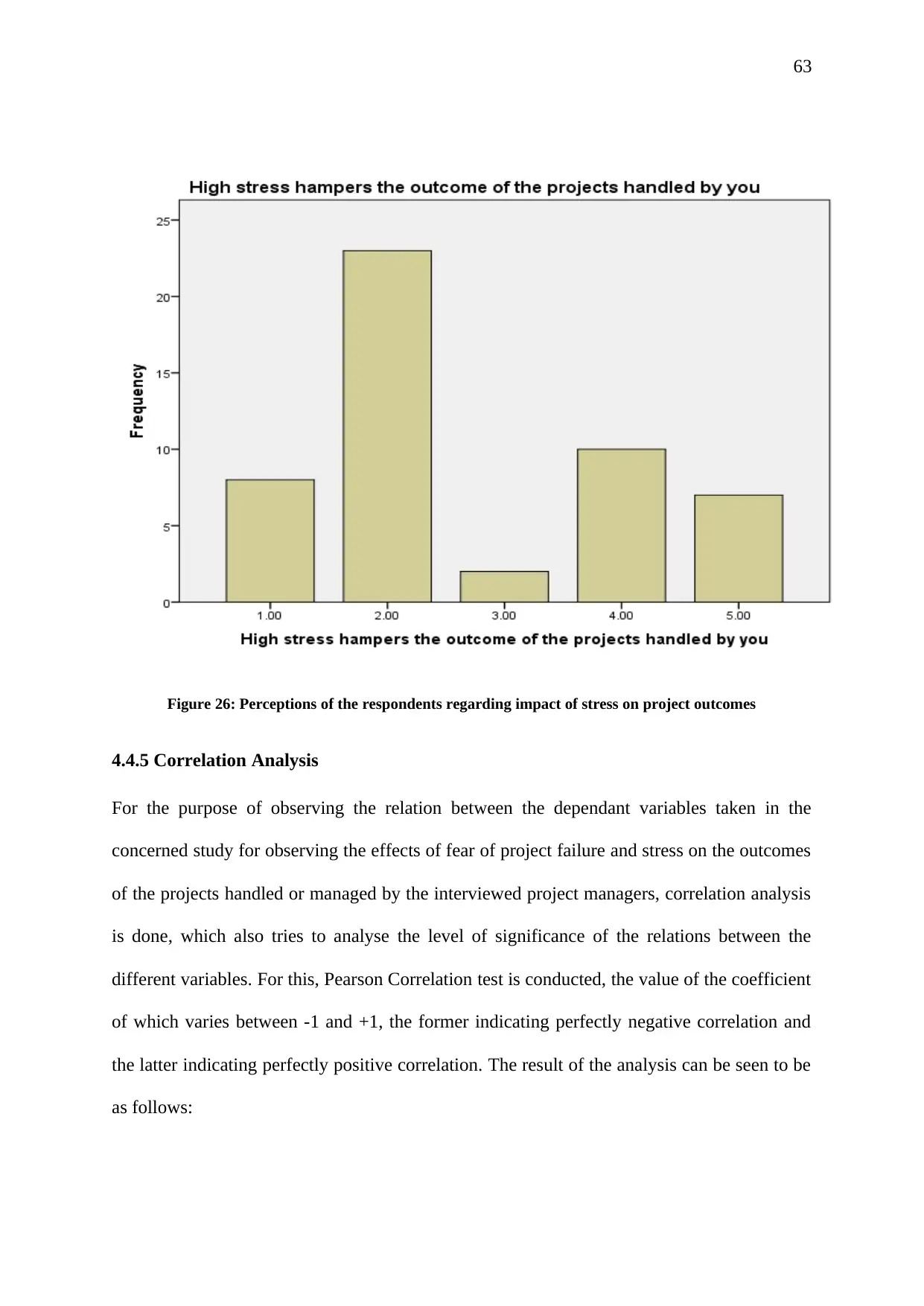
Figure 26: Perceptions of the respondents regarding impact of stress on project outcomes
4.4.5 Correlation Analysis
For the purpose of observing the relation between the dependant variables taken in the
concerned study for observing the effects of fear of project failure and stress on the outcomes
of the projects handled or managed by the interviewed project managers, correlation analysis
is done, which also tries to analyse the level of significance of the relations between the
different variables. For this, Pearson Correlation test is conducted, the value of the coefficient
of which varies between -1 and +1, the former indicating perfectly negative correlation and
the latter indicating perfectly positive correlation. The result of the analysis can be seen to be
as follows:
Paraphrase This Document
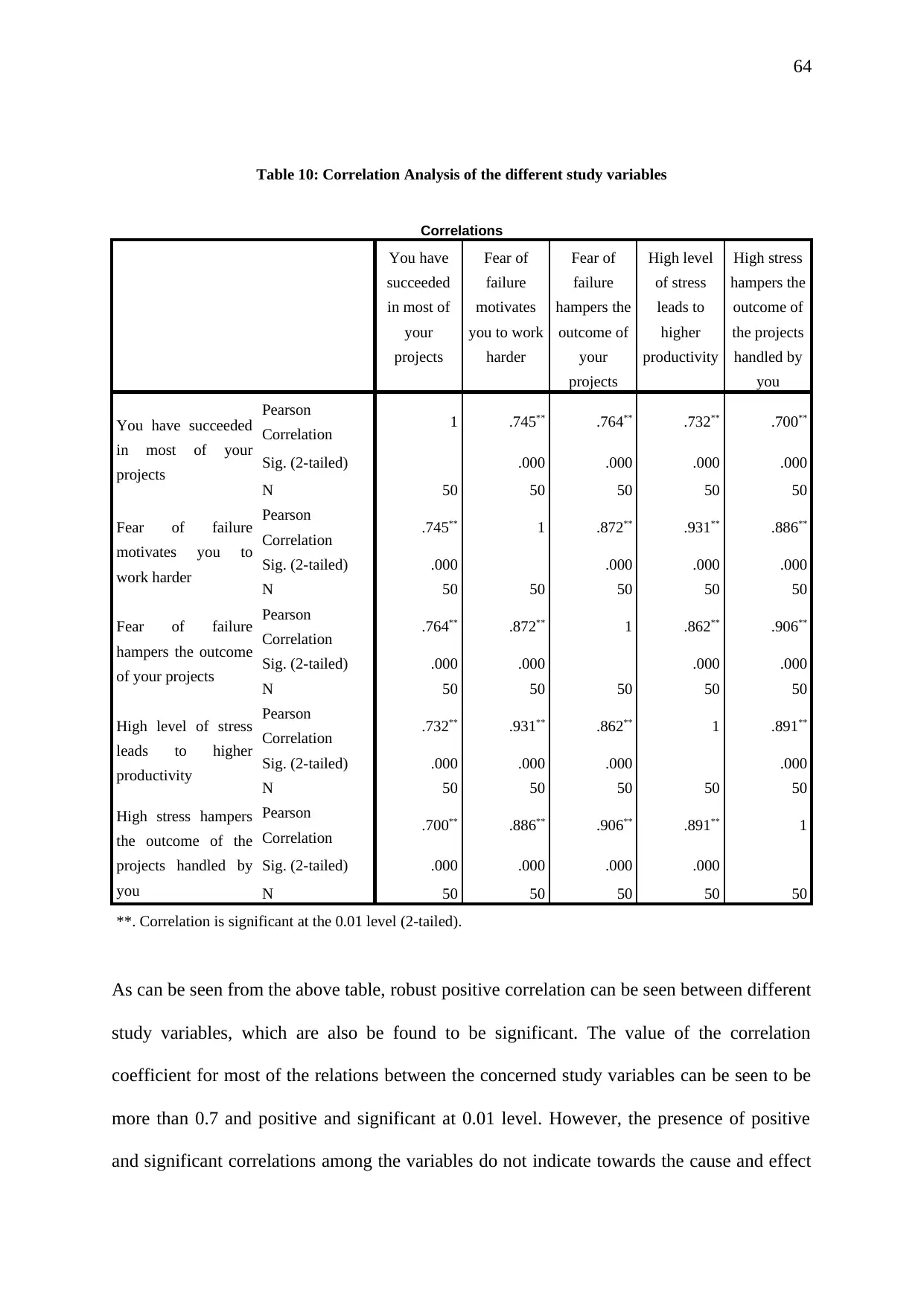
Table 10: Correlation Analysis of the different study variables
Correlations
You have
succeeded
in most of
your
projects
Fear of
failure
motivates
you to work
harder
Fear of
failure
hampers the
outcome of
your
projects
High level
of stress
leads to
higher
productivity
High stress
hampers the
outcome of
the projects
handled by
you
You have succeeded
in most of your
projects
Pearson
Correlation 1 .745** .764** .732** .700**
Sig. (2-tailed) .000 .000 .000 .000
N 50 50 50 50 50
Fear of failure
motivates you to
work harder
Pearson
Correlation .745** 1 .872** .931** .886**
Sig. (2-tailed) .000 .000 .000 .000
N 50 50 50 50 50
Fear of failure
hampers the outcome
of your projects
Pearson
Correlation .764** .872** 1 .862** .906**
Sig. (2-tailed) .000 .000 .000 .000
N 50 50 50 50 50
High level of stress
leads to higher
productivity
Pearson
Correlation .732** .931** .862** 1 .891**
Sig. (2-tailed) .000 .000 .000 .000
N 50 50 50 50 50
High stress hampers
the outcome of the
projects handled by
you
Pearson
Correlation .700** .886** .906** .891** 1
Sig. (2-tailed) .000 .000 .000 .000
N 50 50 50 50 50
**. Correlation is significant at the 0.01 level (2-tailed).
As can be seen from the above table, robust positive correlation can be seen between different
study variables, which are also be found to be significant. The value of the correlation
coefficient for most of the relations between the concerned study variables can be seen to be
more than 0.7 and positive and significant at 0.01 level. However, the presence of positive
and significant correlations among the variables do not indicate towards the cause and effect
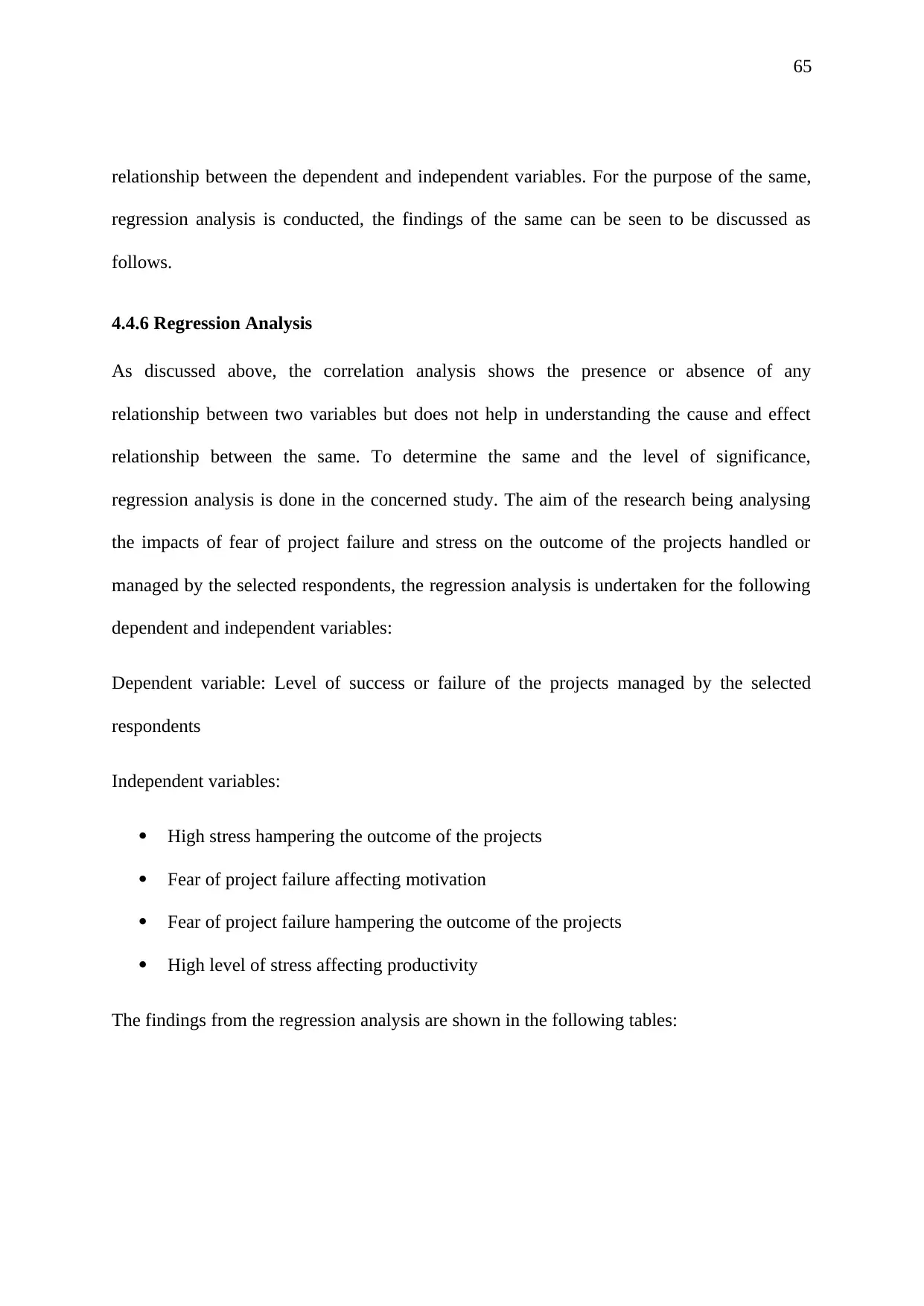
relationship between the dependent and independent variables. For the purpose of the same,
regression analysis is conducted, the findings of the same can be seen to be discussed as
follows.
4.4.6 Regression Analysis
As discussed above, the correlation analysis shows the presence or absence of any
relationship between two variables but does not help in understanding the cause and effect
relationship between the same. To determine the same and the level of significance,
regression analysis is done in the concerned study. The aim of the research being analysing
the impacts of fear of project failure and stress on the outcome of the projects handled or
managed by the selected respondents, the regression analysis is undertaken for the following
dependent and independent variables:
Dependent variable: Level of success or failure of the projects managed by the selected
respondents
Independent variables:
High stress hampering the outcome of the projects
Fear of project failure affecting motivation
Fear of project failure hampering the outcome of the projects
High level of stress affecting productivity
The findings from the regression analysis are shown in the following tables:
You're viewing a preview
Unlock full access by subscribing today!

Table 11: Regression Analysis
Model R R Square
Adjusted R
Square
Std. Error of the
Estimate
1 .786a .618 .584 .87998
a. Predictors: (Constant), High stress hampers the outcome of the
projects handled by you , Fear of failure motivates you to work harder ,
Fear of failure hampers the outcome of your projects , High level of
stress leads to higher productivity
Table 12: ANOVA Table
Model Sum of Squares df Mean Square F Sig.
1 Regression 56.374 4 14.093 18.200 .000b
Residual 34.846 45 .774
Total 91.220 49
a. Dependent Variable: You have succeeded in most of your projects
b. Predictors: (Constant), High stress hampers the outcome of the projects handled by you , Fear
of failure motivates you to work harder , Fear of failure hampers the outcome of your projects ,
High level of stress leads to higher productivity
Table 13: Coefficients
Model
Unstandardized Coefficients
Standardized
Coefficients
t Sig.B Std. Error Beta
1 (Constant) .581 .289 2.009 .051
Fear of failure motivates you
to work harder
.296 .294 .278 1.006 .320
Fear of failure hampers the
outcome of your projects
.554 .229 .563 2.417 .020
High level of stress leads to
higher productivity
.192 .288 .184 .667 .508
High stress hampers the
outcome of the projects
handled by you
-.224 .261 -.220 -.858 .395
a. Dependent Variable: You have succeeded in most of your projects
Paraphrase This Document
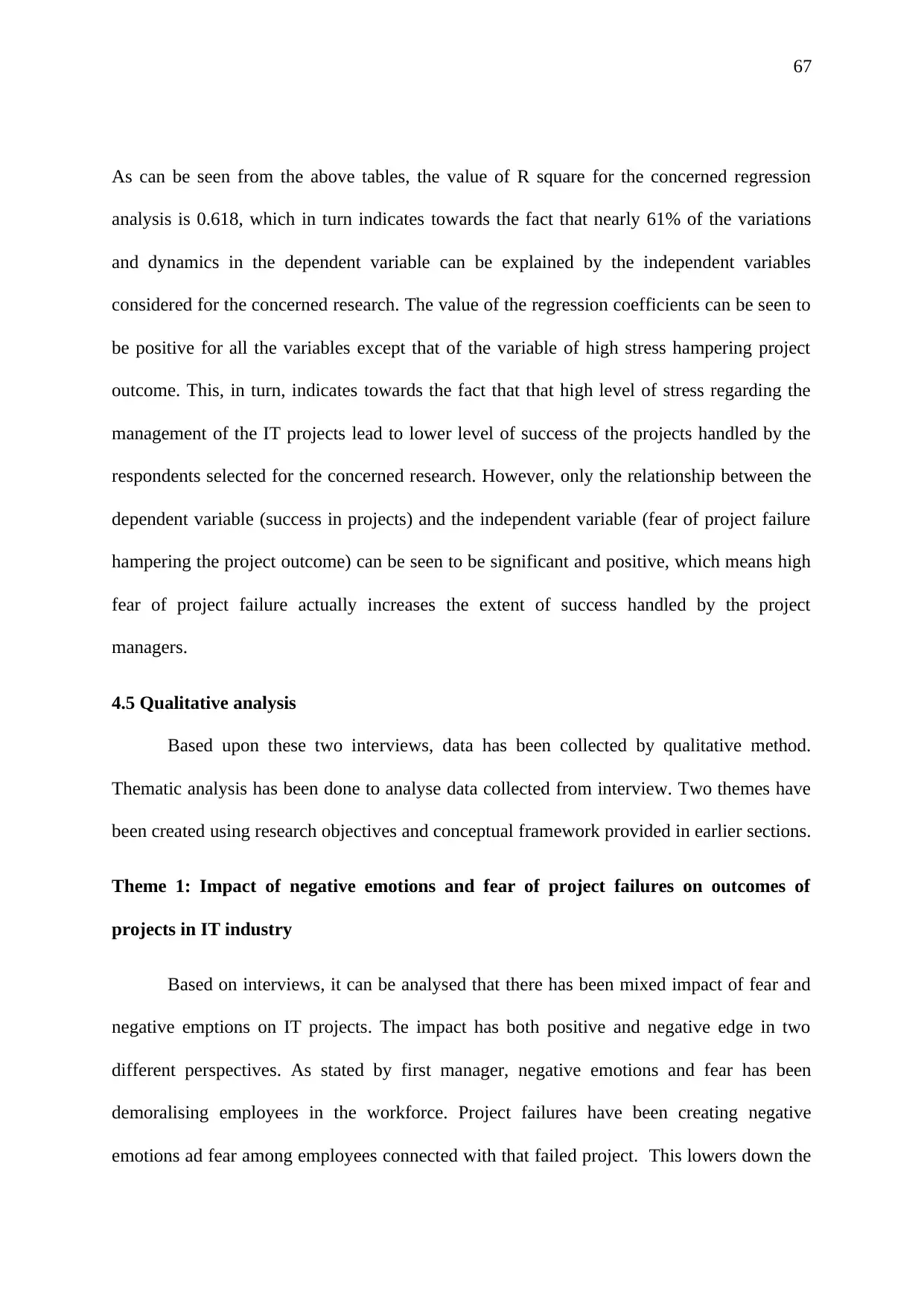
As can be seen from the above tables, the value of R square for the concerned regression
analysis is 0.618, which in turn indicates towards the fact that nearly 61% of the variations
and dynamics in the dependent variable can be explained by the independent variables
considered for the concerned research. The value of the regression coefficients can be seen to
be positive for all the variables except that of the variable of high stress hampering project
outcome. This, in turn, indicates towards the fact that that high level of stress regarding the
management of the IT projects lead to lower level of success of the projects handled by the
respondents selected for the concerned research. However, only the relationship between the
dependent variable (success in projects) and the independent variable (fear of project failure
hampering the project outcome) can be seen to be significant and positive, which means high
fear of project failure actually increases the extent of success handled by the project
managers.
4.5 Qualitative analysis
Based upon these two interviews, data has been collected by qualitative method.
Thematic analysis has been done to analyse data collected from interview. Two themes have
been created using research objectives and conceptual framework provided in earlier sections.
Theme 1: Impact of negative emotions and fear of project failures on outcomes of
projects in IT industry
Based on interviews, it can be analysed that there has been mixed impact of fear and
negative emptions on IT projects. The impact has both positive and negative edge in two
different perspectives. As stated by first manager, negative emotions and fear has been
demoralising employees in the workforce. Project failures have been creating negative
emotions ad fear among employees connected with that failed project. This lowers down the
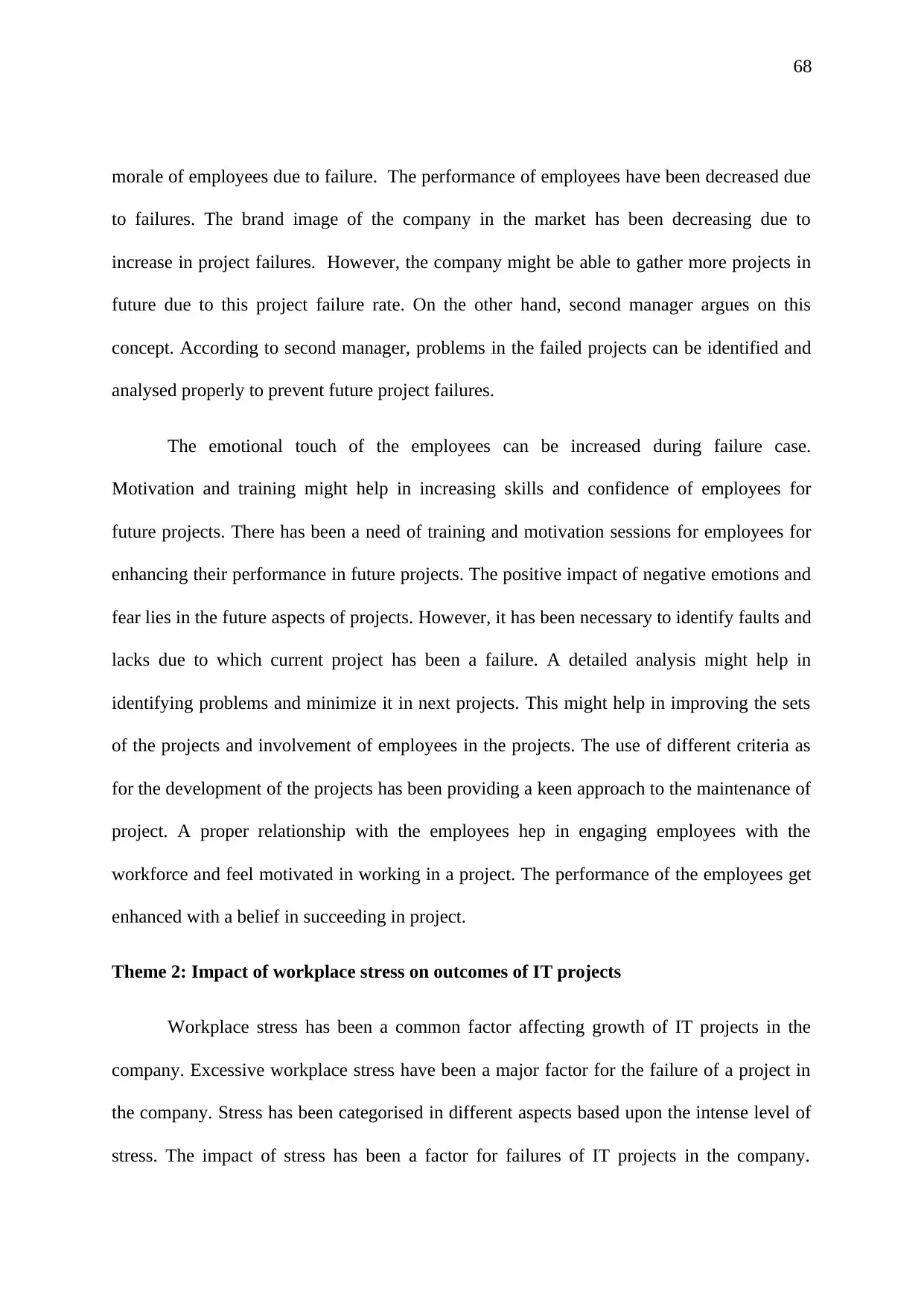
morale of employees due to failure. The performance of employees have been decreased due
to failures. The brand image of the company in the market has been decreasing due to
increase in project failures. However, the company might be able to gather more projects in
future due to this project failure rate. On the other hand, second manager argues on this
concept. According to second manager, problems in the failed projects can be identified and
analysed properly to prevent future project failures.
The emotional touch of the employees can be increased during failure case.
Motivation and training might help in increasing skills and confidence of employees for
future projects. There has been a need of training and motivation sessions for employees for
enhancing their performance in future projects. The positive impact of negative emotions and
fear lies in the future aspects of projects. However, it has been necessary to identify faults and
lacks due to which current project has been a failure. A detailed analysis might help in
identifying problems and minimize it in next projects. This might help in improving the sets
of the projects and involvement of employees in the projects. The use of different criteria as
for the development of the projects has been providing a keen approach to the maintenance of
project. A proper relationship with the employees hep in engaging employees with the
workforce and feel motivated in working in a project. The performance of the employees get
enhanced with a belief in succeeding in project.
Theme 2: Impact of workplace stress on outcomes of IT projects
Workplace stress has been a common factor affecting growth of IT projects in the
company. Excessive workplace stress have been a major factor for the failure of a project in
the company. Stress has been categorised in different aspects based upon the intense level of
stress. The impact of stress has been a factor for failures of IT projects in the company.
You're viewing a preview
Unlock full access by subscribing today!
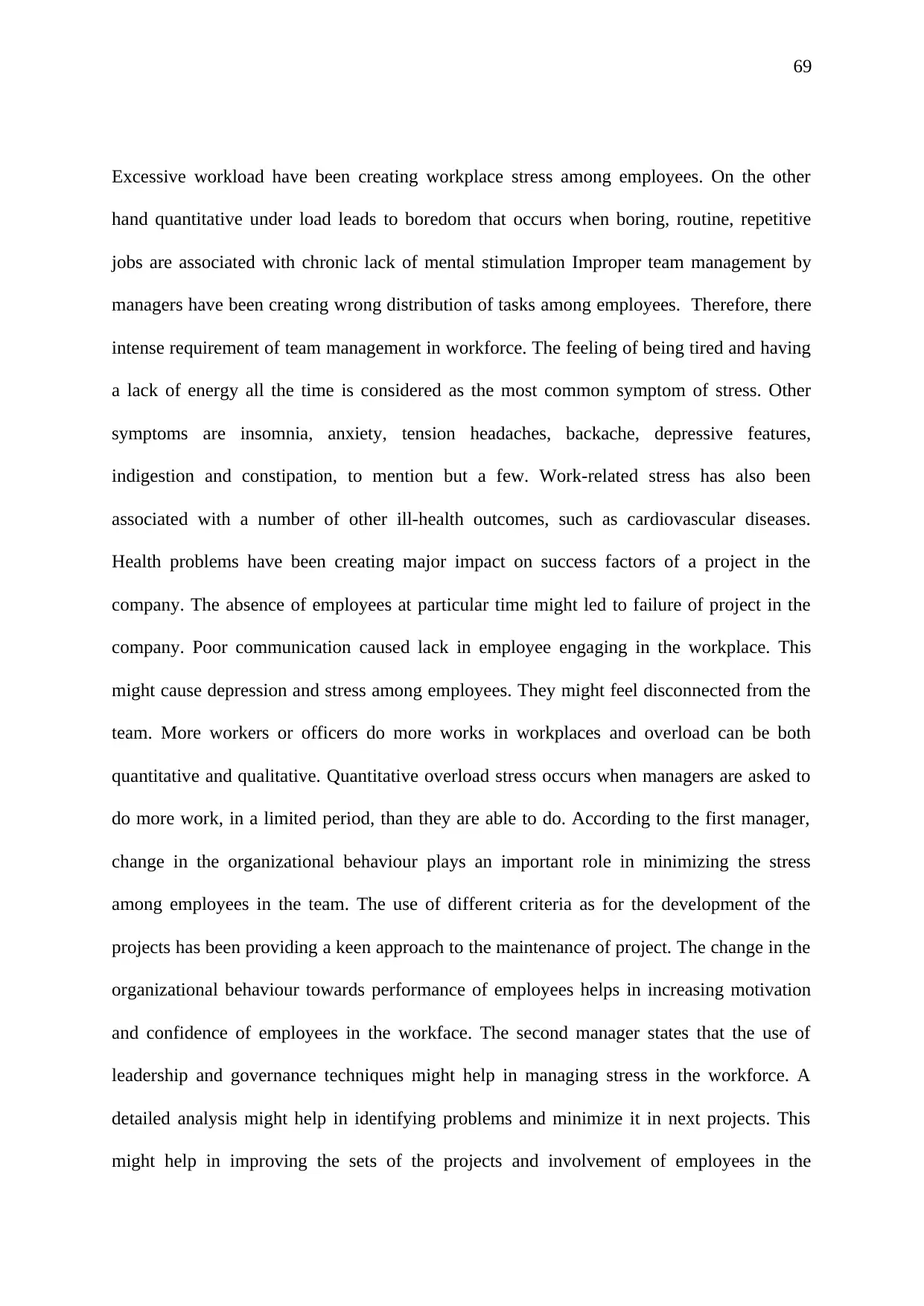
Excessive workload have been creating workplace stress among employees. On the other
hand quantitative under load leads to boredom that occurs when boring, routine, repetitive
jobs are associated with chronic lack of mental stimulation Improper team management by
managers have been creating wrong distribution of tasks among employees. Therefore, there
intense requirement of team management in workforce. The feeling of being tired and having
a lack of energy all the time is considered as the most common symptom of stress. Other
symptoms are insomnia, anxiety, tension headaches, backache, depressive features,
indigestion and constipation, to mention but a few. Work-related stress has also been
associated with a number of other ill-health outcomes, such as cardiovascular diseases.
Health problems have been creating major impact on success factors of a project in the
company. The absence of employees at particular time might led to failure of project in the
company. Poor communication caused lack in employee engaging in the workplace. This
might cause depression and stress among employees. They might feel disconnected from the
team. More workers or officers do more works in workplaces and overload can be both
quantitative and qualitative. Quantitative overload stress occurs when managers are asked to
do more work, in a limited period, than they are able to do. According to the first manager,
change in the organizational behaviour plays an important role in minimizing the stress
among employees in the team. The use of different criteria as for the development of the
projects has been providing a keen approach to the maintenance of project. The change in the
organizational behaviour towards performance of employees helps in increasing motivation
and confidence of employees in the workface. The second manager states that the use of
leadership and governance techniques might help in managing stress in the workforce. A
detailed analysis might help in identifying problems and minimize it in next projects. This
might help in improving the sets of the projects and involvement of employees in the
Paraphrase This Document

projects. A proper management and leadership from high authority level in the company hep
in motivating employees to provide their quality performances in the team. This might help
in increasing the performance of the employees. The success rate of the employees might get
increased in the workforce.
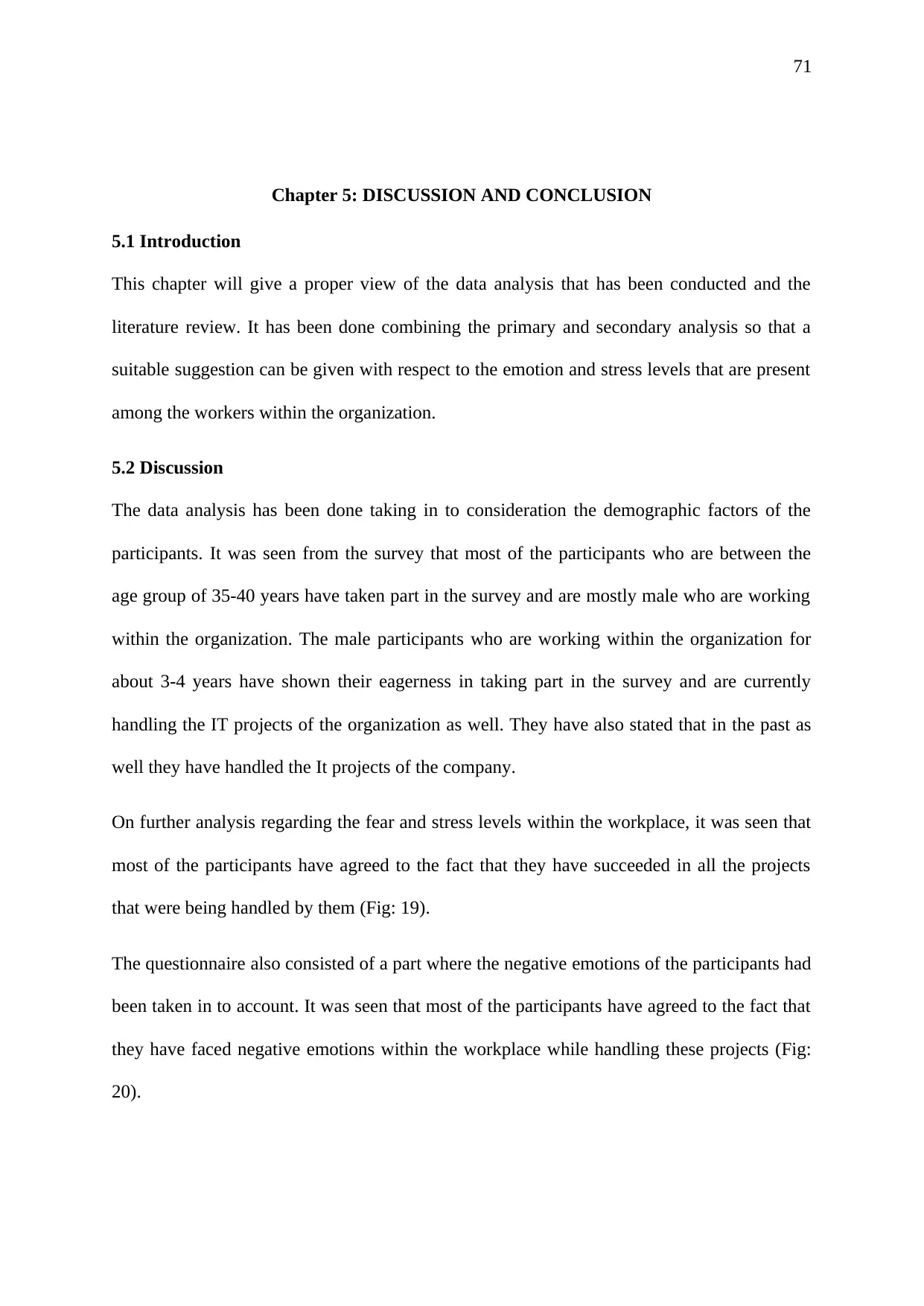
Chapter 5: DISCUSSION AND CONCLUSION
5.1 Introduction
This chapter will give a proper view of the data analysis that has been conducted and the
literature review. It has been done combining the primary and secondary analysis so that a
suitable suggestion can be given with respect to the emotion and stress levels that are present
among the workers within the organization.
5.2 Discussion
The data analysis has been done taking in to consideration the demographic factors of the
participants. It was seen from the survey that most of the participants who are between the
age group of 35-40 years have taken part in the survey and are mostly male who are working
within the organization. The male participants who are working within the organization for
about 3-4 years have shown their eagerness in taking part in the survey and are currently
handling the IT projects of the organization as well. They have also stated that in the past as
well they have handled the It projects of the company.
On further analysis regarding the fear and stress levels within the workplace, it was seen that
most of the participants have agreed to the fact that they have succeeded in all the projects
that were being handled by them (Fig: 19).
The questionnaire also consisted of a part where the negative emotions of the participants had
been taken in to account. It was seen that most of the participants have agreed to the fact that
they have faced negative emotions within the workplace while handling these projects (Fig:
20).
You're viewing a preview
Unlock full access by subscribing today!
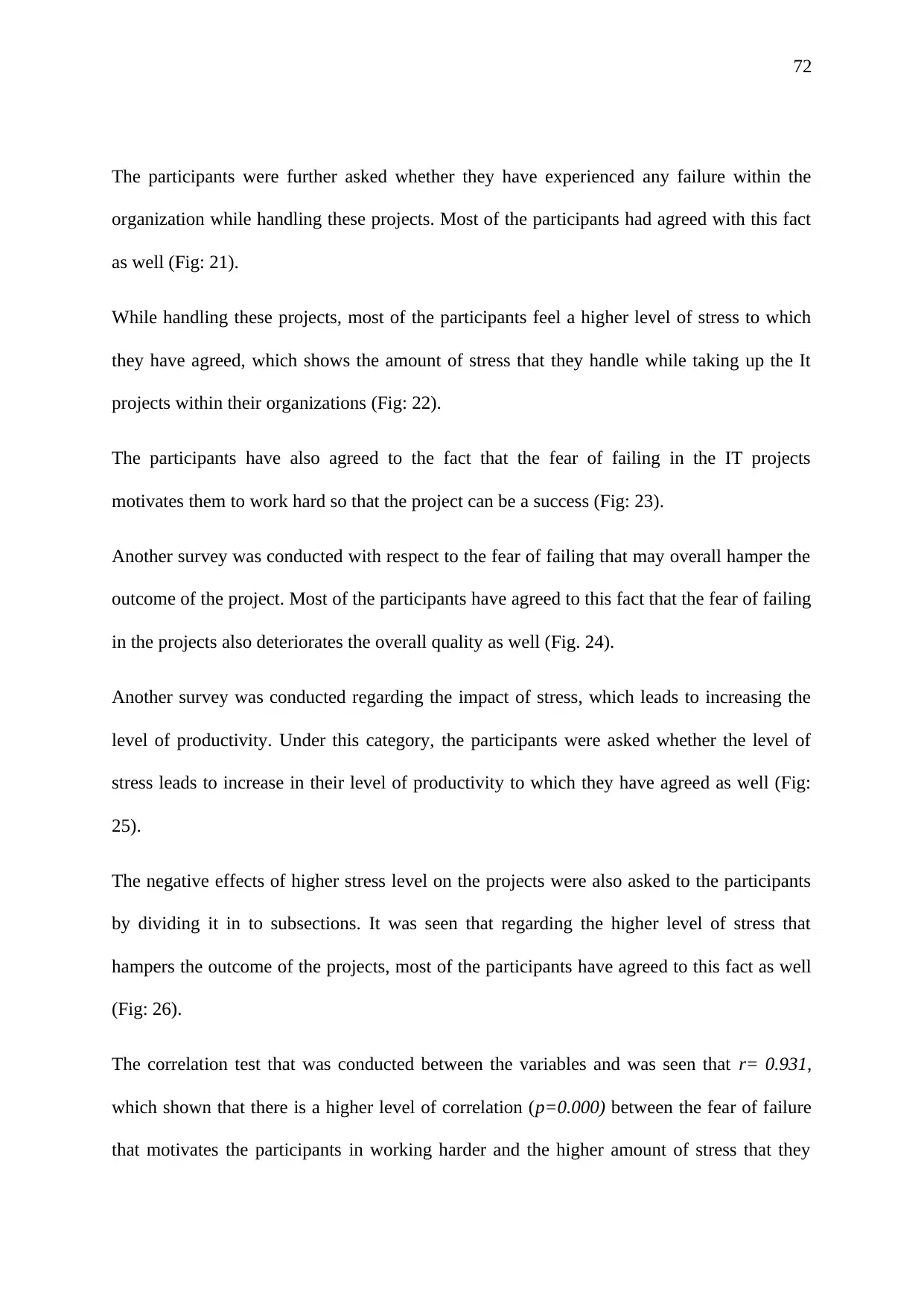
The participants were further asked whether they have experienced any failure within the
organization while handling these projects. Most of the participants had agreed with this fact
as well (Fig: 21).
While handling these projects, most of the participants feel a higher level of stress to which
they have agreed, which shows the amount of stress that they handle while taking up the It
projects within their organizations (Fig: 22).
The participants have also agreed to the fact that the fear of failing in the IT projects
motivates them to work hard so that the project can be a success (Fig: 23).
Another survey was conducted with respect to the fear of failing that may overall hamper the
outcome of the project. Most of the participants have agreed to this fact that the fear of failing
in the projects also deteriorates the overall quality as well (Fig. 24).
Another survey was conducted regarding the impact of stress, which leads to increasing the
level of productivity. Under this category, the participants were asked whether the level of
stress leads to increase in their level of productivity to which they have agreed as well (Fig:
25).
The negative effects of higher stress level on the projects were also asked to the participants
by dividing it in to subsections. It was seen that regarding the higher level of stress that
hampers the outcome of the projects, most of the participants have agreed to this fact as well
(Fig: 26).
The correlation test that was conducted between the variables and was seen that r= 0.931,
which shown that there is a higher level of correlation (p=0.000) between the fear of failure
that motivates the participants in working harder and the higher amount of stress that they
Paraphrase This Document

need to take, which helps in increasing their level of productivity. Based on these factors,
more variables were combined, which will be discussed as well. The next higher value that is
r=0.872, which also indicates a higher level of correlation (p=0.000) between fear of failure
that motivates them to work harder and that failure may also lead to hamper the overall
quality of the projects.
Another combination between the the fear of failing that motivates the participants in
working harder and the higher level of stress hampers the overall outcome of the projects that
are being handled by them has come to r= 0.886, which shows that there is significantly a
higher level of correlation (p=0.000). A significantly lower correlation than the other
variables was seen between the higher level of stress that can hamper the project outcome and
the number of successful projects that were completed by the participants. It was seen that
r=0.700 and p=0.000, which shows that there is also a higher correlation but significantly
lesser than the other variables.
The regression analysis has been done based on the four factors that are ‘fear of failure
motivates you to work harder’, ‘fear of failure hampers the outcome of your projects’, ‘high
level of stress leads to higher productivity’, ‘high stress hampers the outcome the projects
handled by you.’ It was seen that the beta value of the second variable has come to 0.554 and
p=0.020, which is most significant on the dependent variable that is the success of the
project. It can therefore be stated that the fear of failure in the overall outcome of the project
leads the project to be successful in nature. However, it was also seen that the last variable
has a negative figure, which shows that it is statistically insignificant. Therefore it can be
stated that the high level of stress hampers the outcome of the project and that the success
rate of the IT projects decreases to a great extent.
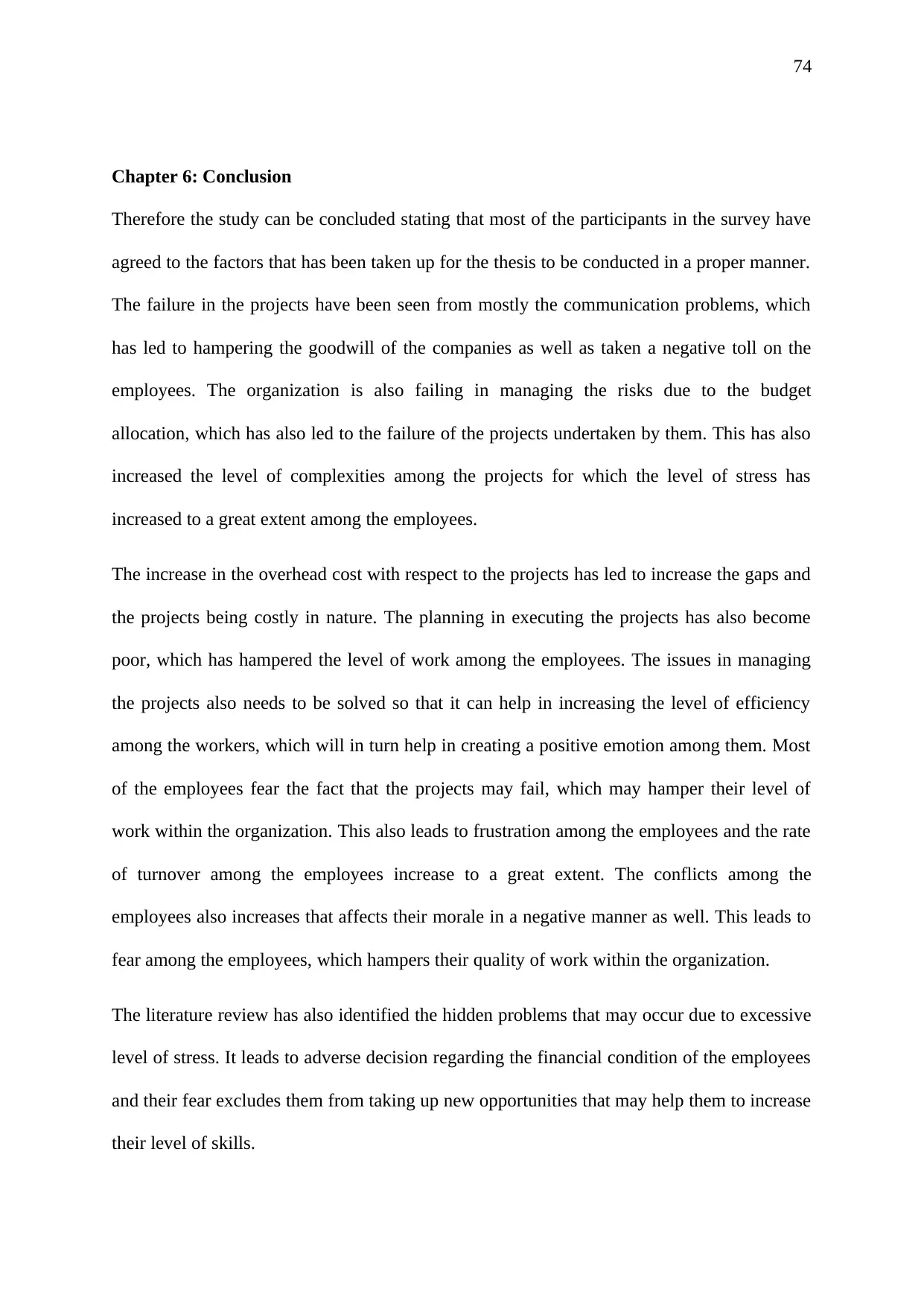
Chapter 6: Conclusion
Therefore the study can be concluded stating that most of the participants in the survey have
agreed to the factors that has been taken up for the thesis to be conducted in a proper manner.
The failure in the projects have been seen from mostly the communication problems, which
has led to hampering the goodwill of the companies as well as taken a negative toll on the
employees. The organization is also failing in managing the risks due to the budget
allocation, which has also led to the failure of the projects undertaken by them. This has also
increased the level of complexities among the projects for which the level of stress has
increased to a great extent among the employees.
The increase in the overhead cost with respect to the projects has led to increase the gaps and
the projects being costly in nature. The planning in executing the projects has also become
poor, which has hampered the level of work among the employees. The issues in managing
the projects also needs to be solved so that it can help in increasing the level of efficiency
among the workers, which will in turn help in creating a positive emotion among them. Most
of the employees fear the fact that the projects may fail, which may hamper their level of
work within the organization. This also leads to frustration among the employees and the rate
of turnover among the employees increase to a great extent. The conflicts among the
employees also increases that affects their morale in a negative manner as well. This leads to
fear among the employees, which hampers their quality of work within the organization.
The literature review has also identified the hidden problems that may occur due to excessive
level of stress. It leads to adverse decision regarding the financial condition of the employees
and their fear excludes them from taking up new opportunities that may help them to increase
their level of skills.
You're viewing a preview
Unlock full access by subscribing today!
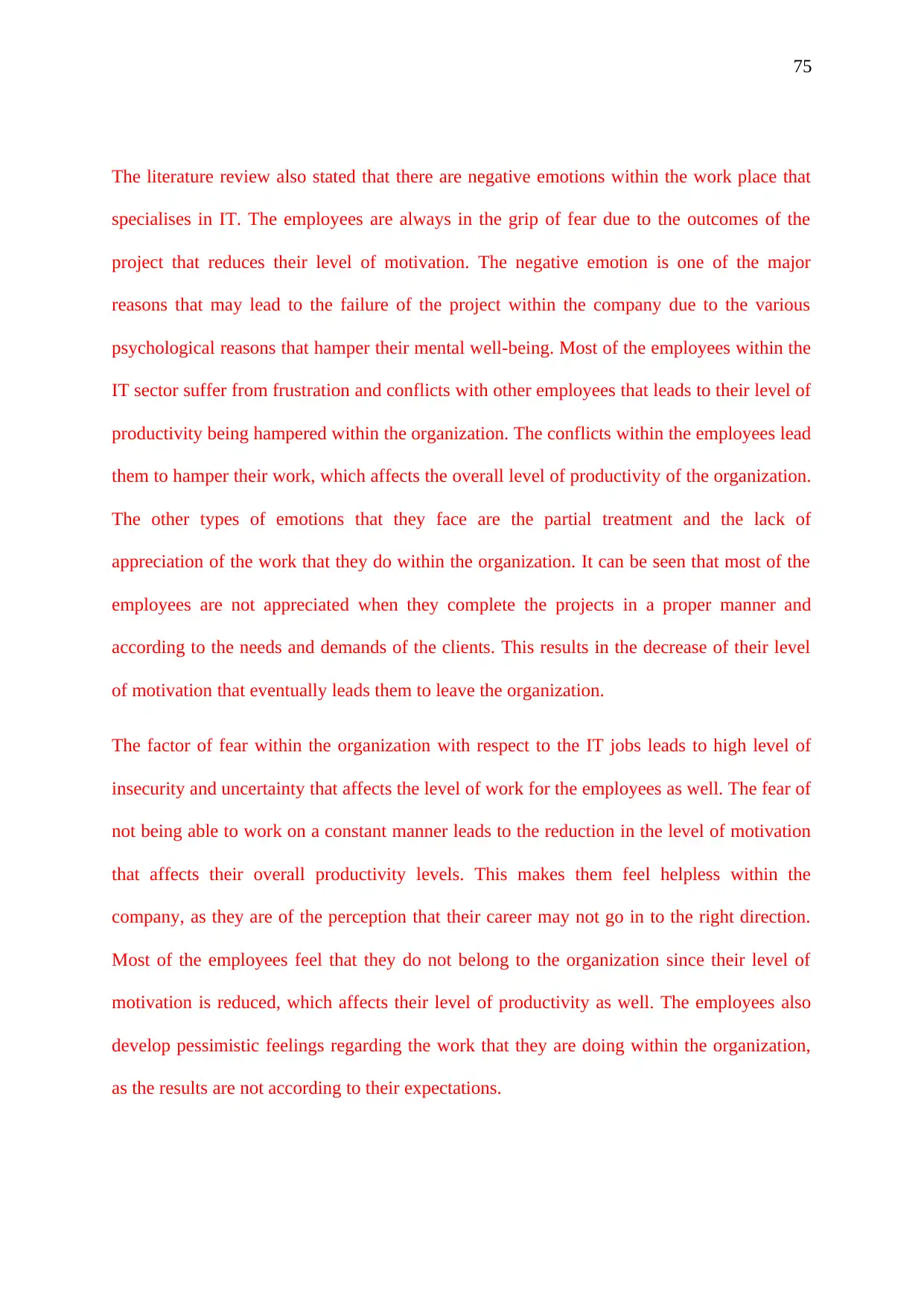
The literature review also stated that there are negative emotions within the work place that
specialises in IT. The employees are always in the grip of fear due to the outcomes of the
project that reduces their level of motivation. The negative emotion is one of the major
reasons that may lead to the failure of the project within the company due to the various
psychological reasons that hamper their mental well-being. Most of the employees within the
IT sector suffer from frustration and conflicts with other employees that leads to their level of
productivity being hampered within the organization. The conflicts within the employees lead
them to hamper their work, which affects the overall level of productivity of the organization.
The other types of emotions that they face are the partial treatment and the lack of
appreciation of the work that they do within the organization. It can be seen that most of the
employees are not appreciated when they complete the projects in a proper manner and
according to the needs and demands of the clients. This results in the decrease of their level
of motivation that eventually leads them to leave the organization.
The factor of fear within the organization with respect to the IT jobs leads to high level of
insecurity and uncertainty that affects the level of work for the employees as well. The fear of
not being able to work on a constant manner leads to the reduction in the level of motivation
that affects their overall productivity levels. This makes them feel helpless within the
company, as they are of the perception that their career may not go in to the right direction.
Most of the employees feel that they do not belong to the organization since their level of
motivation is reduced, which affects their level of productivity as well. The employees also
develop pessimistic feelings regarding the work that they are doing within the organization,
as the results are not according to their expectations.
Paraphrase This Document
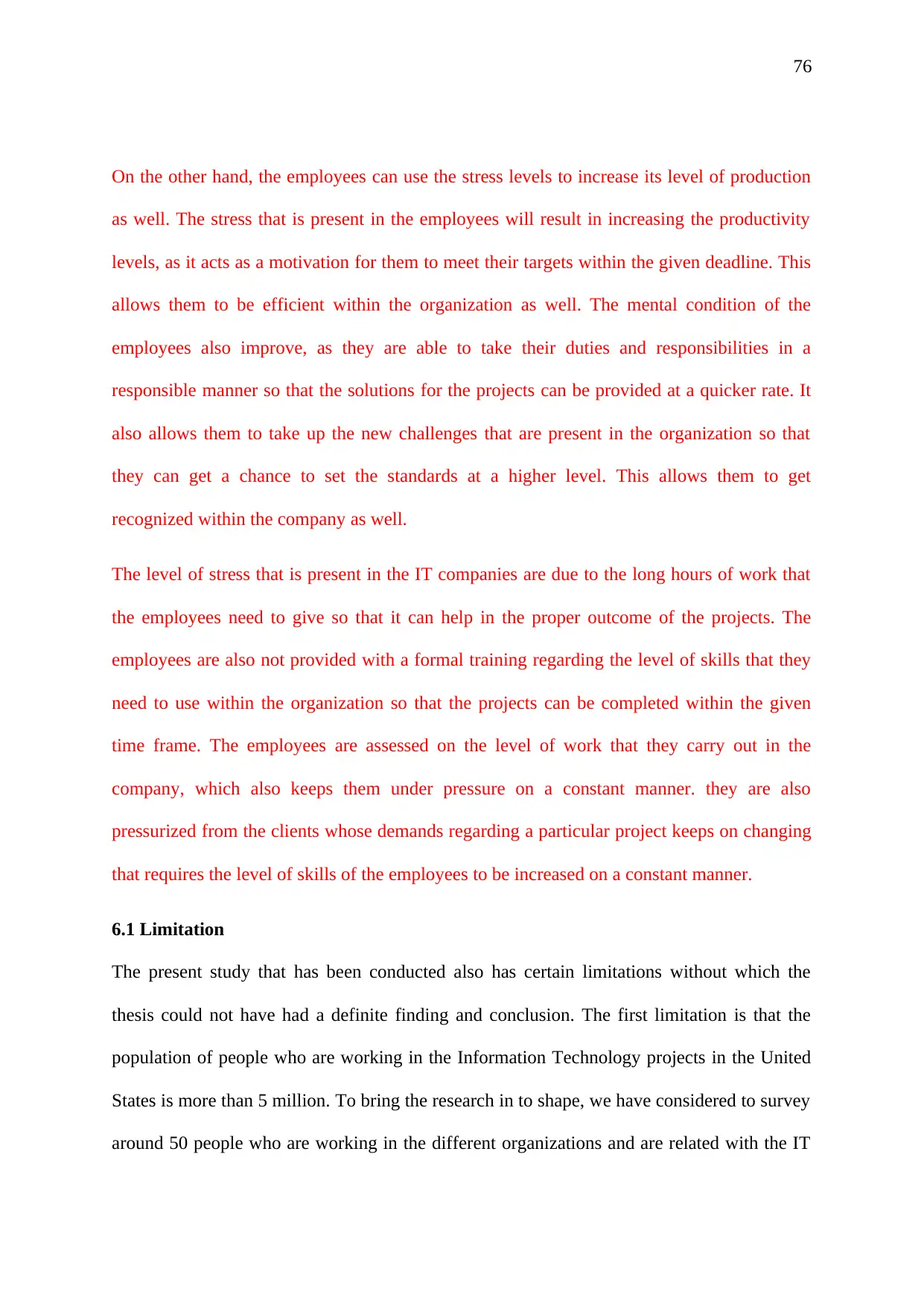
On the other hand, the employees can use the stress levels to increase its level of production
as well. The stress that is present in the employees will result in increasing the productivity
levels, as it acts as a motivation for them to meet their targets within the given deadline. This
allows them to be efficient within the organization as well. The mental condition of the
employees also improve, as they are able to take their duties and responsibilities in a
responsible manner so that the solutions for the projects can be provided at a quicker rate. It
also allows them to take up the new challenges that are present in the organization so that
they can get a chance to set the standards at a higher level. This allows them to get
recognized within the company as well.
The level of stress that is present in the IT companies are due to the long hours of work that
the employees need to give so that it can help in the proper outcome of the projects. The
employees are also not provided with a formal training regarding the level of skills that they
need to use within the organization so that the projects can be completed within the given
time frame. The employees are assessed on the level of work that they carry out in the
company, which also keeps them under pressure on a constant manner. they are also
pressurized from the clients whose demands regarding a particular project keeps on changing
that requires the level of skills of the employees to be increased on a constant manner.
6.1 Limitation
The present study that has been conducted also has certain limitations without which the
thesis could not have had a definite finding and conclusion. The first limitation is that the
population of people who are working in the Information Technology projects in the United
States is more than 5 million. To bring the research in to shape, we have considered to survey
around 50 people who are working in the different organizations and are related with the IT

projects directly. The questions that were framed for the process of survey was close-ended
so that the other views of the participants are not being taken in to consideration apart from
the options that are present in the survey sheet. This had restricted the participants from
answering the questions in an elaborated manner. Hence, their point of views were not taken
in to consideration so that the research can be conducted in a proper manner.
Additionally, the results that were analysed form the survey was only pertained one place that
is the United States, which may change when the research is being conducted in some
different country. There are many It organizations that are working in the country and for the
research to be completed within then given time-frame, only 10 organizations were
considered so that it can help in completing the thesis. The participants who are working in
the top IT organizations were only considered so that it can help the research to be completed
properly. This was done due to the fact that the participants belonging to the top
organizations can help in providing the survey results in a proper manner. This had led to
ignore the small and medium IT organizations in the country.
6.2 Suggestion
It has been seen that over the past few years, the failure in the infrastructural and the
technological aspect has been huge, which has affect the growth of the It industry in a
significant manner. This has been due to the change in the lifestyles of the people across the
globe along with the level of communication that is taking place. One of the major causes for
the failure of the projects in the It industry is due to the miscommunication that takes place
between the parties, which leads to great amount of stress and emotions within the work
place.
You're viewing a preview
Unlock full access by subscribing today!
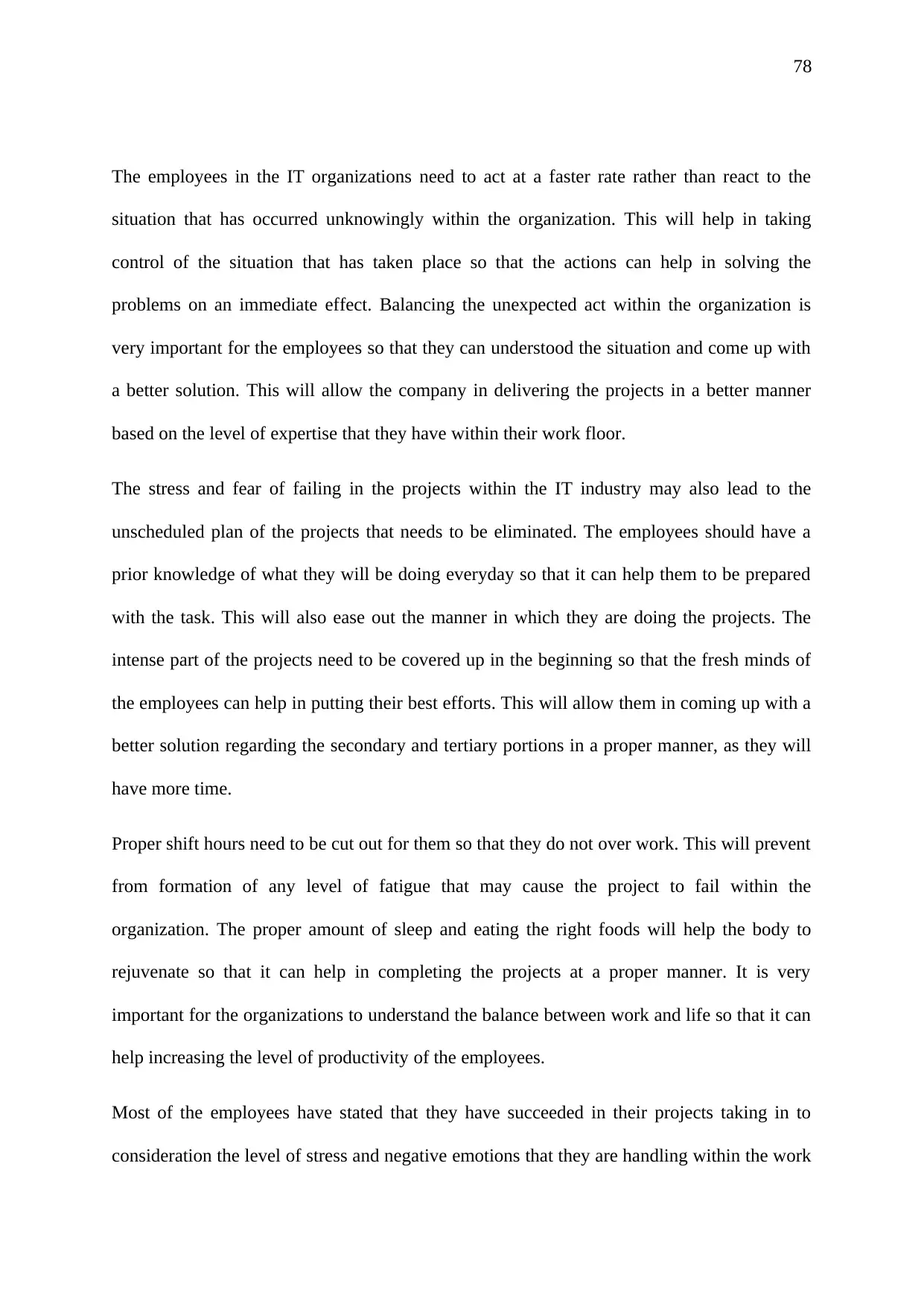
The employees in the IT organizations need to act at a faster rate rather than react to the
situation that has occurred unknowingly within the organization. This will help in taking
control of the situation that has taken place so that the actions can help in solving the
problems on an immediate effect. Balancing the unexpected act within the organization is
very important for the employees so that they can understood the situation and come up with
a better solution. This will allow the company in delivering the projects in a better manner
based on the level of expertise that they have within their work floor.
The stress and fear of failing in the projects within the IT industry may also lead to the
unscheduled plan of the projects that needs to be eliminated. The employees should have a
prior knowledge of what they will be doing everyday so that it can help them to be prepared
with the task. This will also ease out the manner in which they are doing the projects. The
intense part of the projects need to be covered up in the beginning so that the fresh minds of
the employees can help in putting their best efforts. This will allow them in coming up with a
better solution regarding the secondary and tertiary portions in a proper manner, as they will
have more time.
Proper shift hours need to be cut out for them so that they do not over work. This will prevent
from formation of any level of fatigue that may cause the project to fail within the
organization. The proper amount of sleep and eating the right foods will help the body to
rejuvenate so that it can help in completing the projects at a proper manner. It is very
important for the organizations to understand the balance between work and life so that it can
help increasing the level of productivity of the employees.
Most of the employees have stated that they have succeeded in their projects taking in to
consideration the level of stress and negative emotions that they are handling within the work
Paraphrase This Document
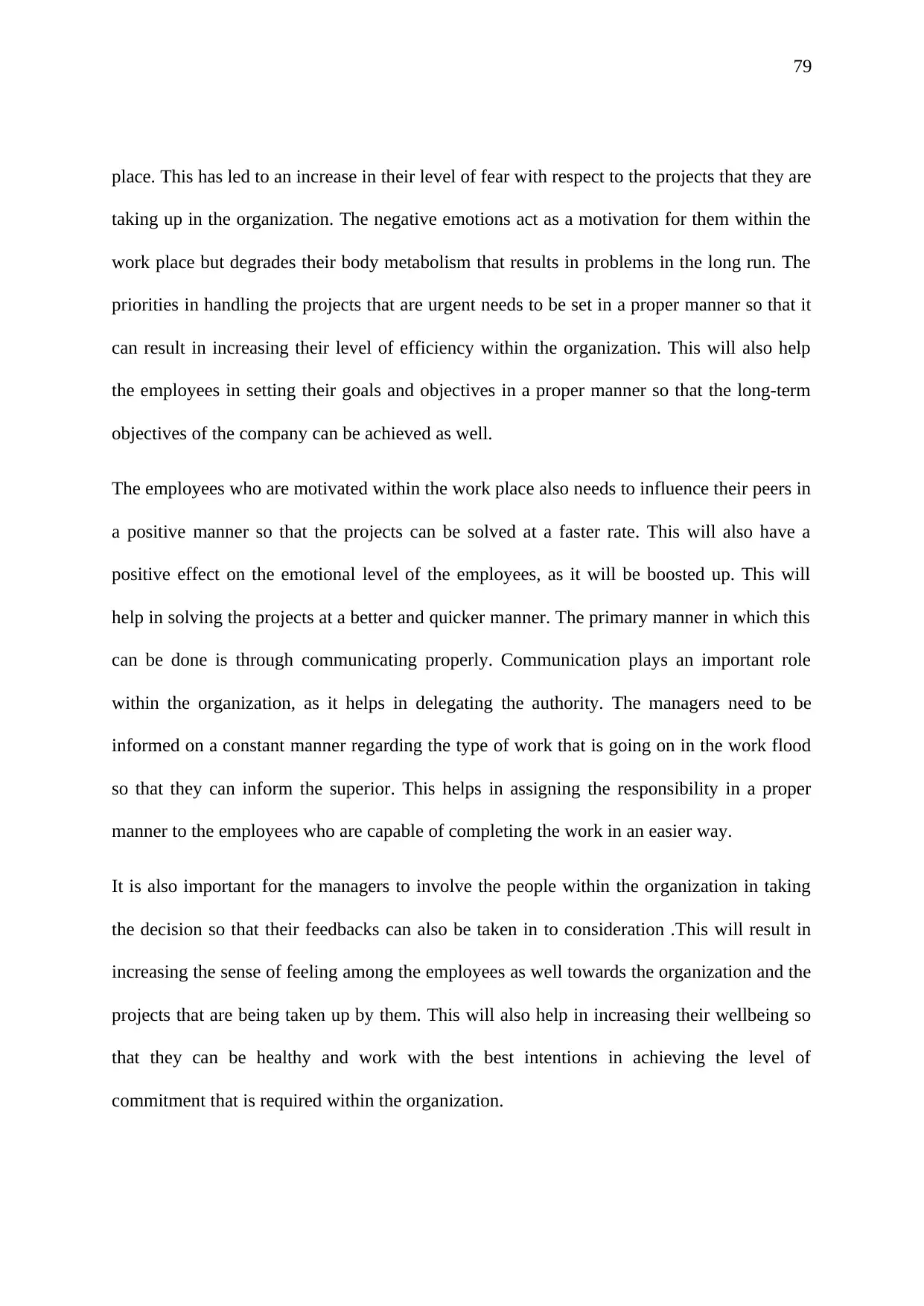
place. This has led to an increase in their level of fear with respect to the projects that they are
taking up in the organization. The negative emotions act as a motivation for them within the
work place but degrades their body metabolism that results in problems in the long run. The
priorities in handling the projects that are urgent needs to be set in a proper manner so that it
can result in increasing their level of efficiency within the organization. This will also help
the employees in setting their goals and objectives in a proper manner so that the long-term
objectives of the company can be achieved as well.
The employees who are motivated within the work place also needs to influence their peers in
a positive manner so that the projects can be solved at a faster rate. This will also have a
positive effect on the emotional level of the employees, as it will be boosted up. This will
help in solving the projects at a better and quicker manner. The primary manner in which this
can be done is through communicating properly. Communication plays an important role
within the organization, as it helps in delegating the authority. The managers need to be
informed on a constant manner regarding the type of work that is going on in the work flood
so that they can inform the superior. This helps in assigning the responsibility in a proper
manner to the employees who are capable of completing the work in an easier way.
It is also important for the managers to involve the people within the organization in taking
the decision so that their feedbacks can also be taken in to consideration .This will result in
increasing the sense of feeling among the employees as well towards the organization and the
projects that are being taken up by them. This will also help in increasing their wellbeing so
that they can be healthy and work with the best intentions in achieving the level of
commitment that is required within the organization.

The factor of stress can be reduced by identifying the main cause that is creating a problem
for the employees within the organization. The identification of the problem will result in
mitigating in a better way so that it can help in increasing the level of motivation. The
identification of the factors will help in assessing the level of skills that is present among
them so that it can be solved at a faster rate. The issues that are present within the
organization needs to be discussed by the employees to their trusted person or manager so
that it can result in solving in a proper manner. The person needs to be an active listener so
that the problem can be heard and proper solution to mitigate it can be given to them. This
will result in fixing the problem so that the employees can remain motivated within the
company.
It is also important for the employees to take a break from the hectic schedule so that it can
result in relieving the level of stress. The breaks that will be taken will help the employees to
rejuvenate themselves so that they can be refreshed and work in a proper manner. It is
important for the employees to maintain a balance between their work and life so that it does
not affect their personal time. This will enable them to work hard so that the level of
productivity can be increased. It is also important for the employees to stick to a proper diet
so that it can keep their bodies health and provide the mental strength of working in a proper
manner. The health of the employees has a positive effect on the level of work that they are
carrying out within the organization.
It is also important for the employees to prioritize the tasks that they need to carry out so that
it can be scheduled in a meticulous manner. The prioritization of the work will result in
completing the work within the given time frame so that the goodwill of the IT organizations
does not get hampered within the market. The priorities done by the employees will result in
You're viewing a preview
Unlock full access by subscribing today!
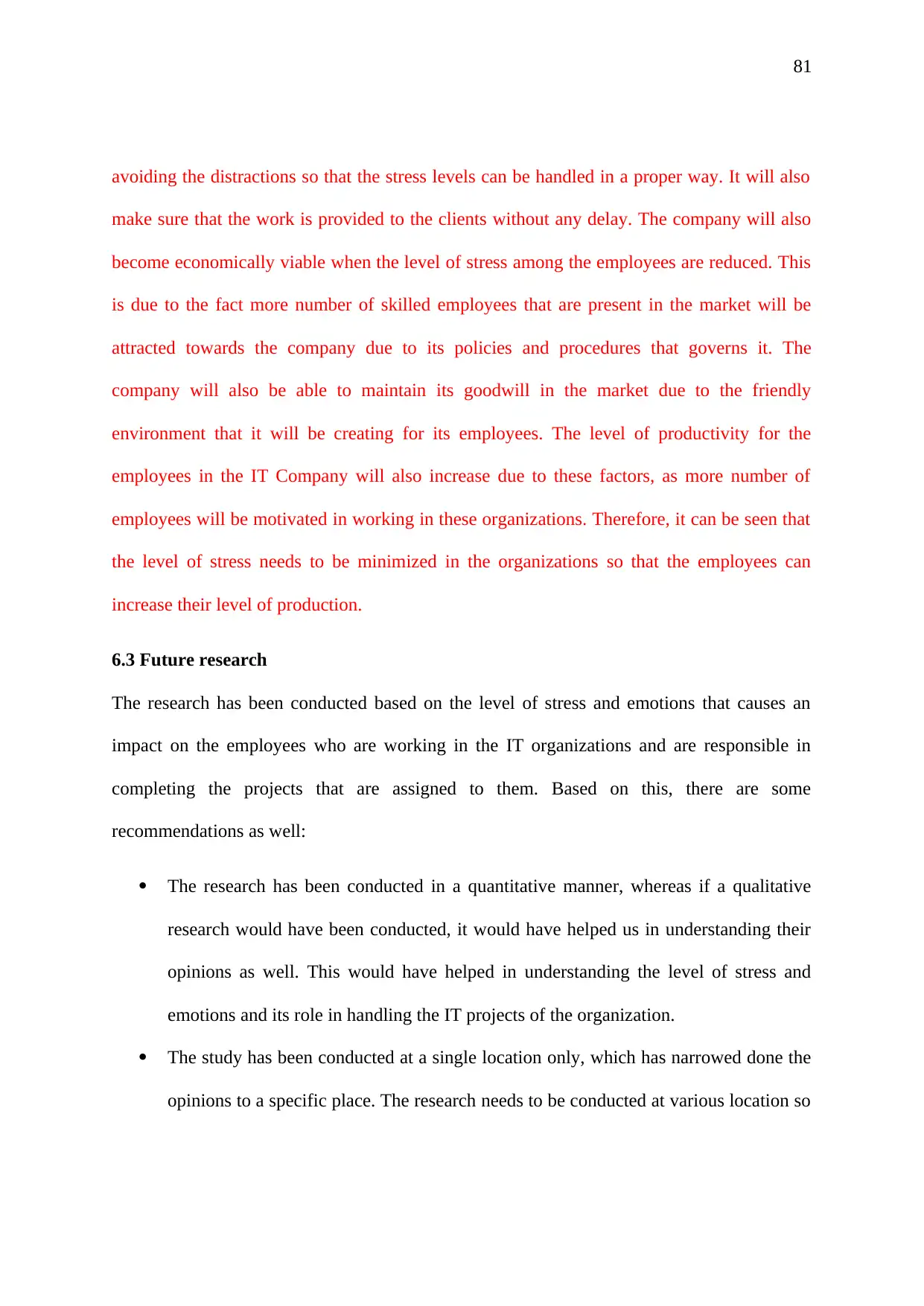
avoiding the distractions so that the stress levels can be handled in a proper way. It will also
make sure that the work is provided to the clients without any delay. The company will also
become economically viable when the level of stress among the employees are reduced. This
is due to the fact more number of skilled employees that are present in the market will be
attracted towards the company due to its policies and procedures that governs it. The
company will also be able to maintain its goodwill in the market due to the friendly
environment that it will be creating for its employees. The level of productivity for the
employees in the IT Company will also increase due to these factors, as more number of
employees will be motivated in working in these organizations. Therefore, it can be seen that
the level of stress needs to be minimized in the organizations so that the employees can
increase their level of production.
6.3 Future research
The research has been conducted based on the level of stress and emotions that causes an
impact on the employees who are working in the IT organizations and are responsible in
completing the projects that are assigned to them. Based on this, there are some
recommendations as well:
The research has been conducted in a quantitative manner, whereas if a qualitative
research would have been conducted, it would have helped us in understanding their
opinions as well. This would have helped in understanding the level of stress and
emotions and its role in handling the IT projects of the organization.
The study has been conducted at a single location only, which has narrowed done the
opinions to a specific place. The research needs to be conducted at various location so
Paraphrase This Document
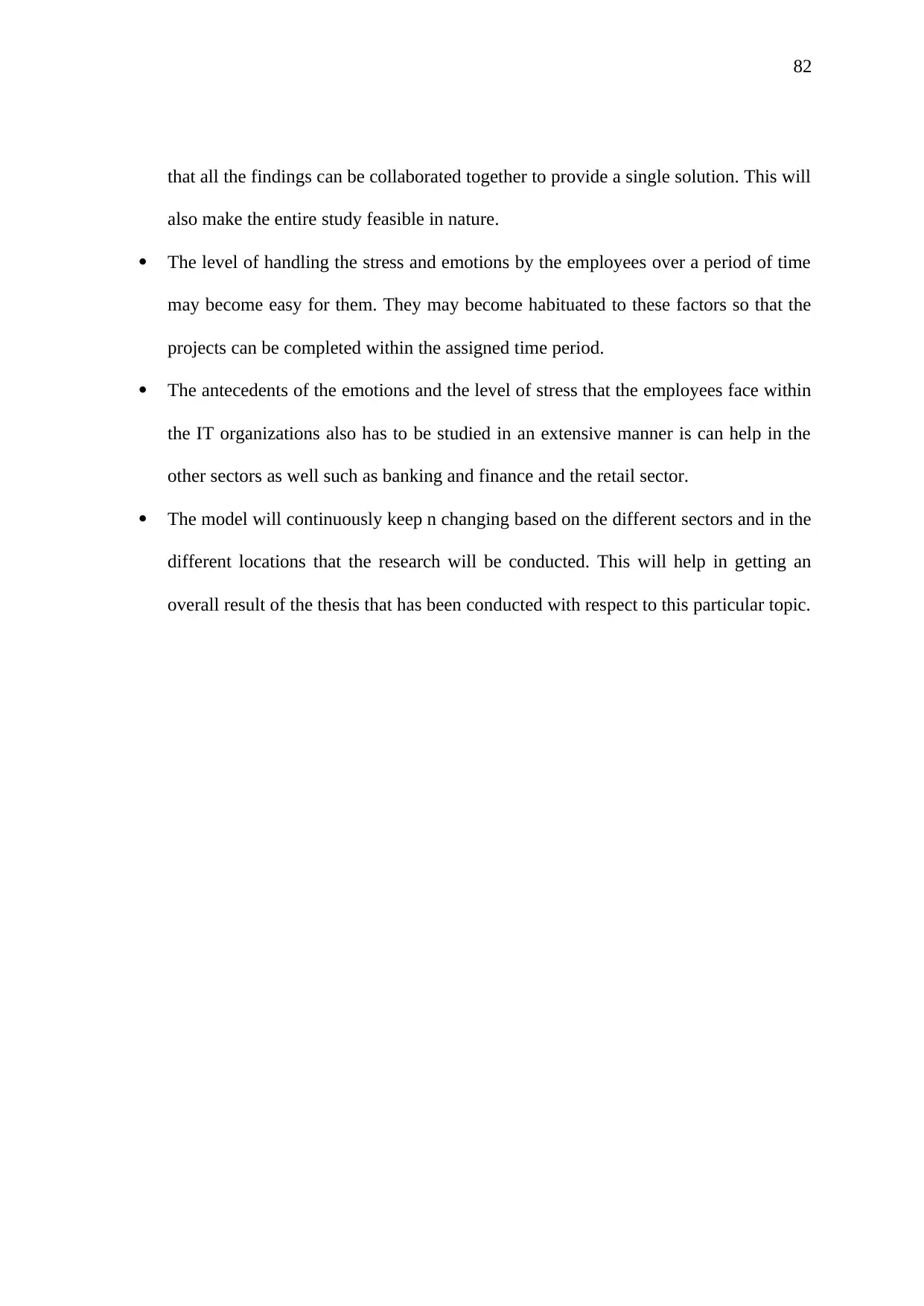
that all the findings can be collaborated together to provide a single solution. This will
also make the entire study feasible in nature.
The level of handling the stress and emotions by the employees over a period of time
may become easy for them. They may become habituated to these factors so that the
projects can be completed within the assigned time period.
The antecedents of the emotions and the level of stress that the employees face within
the IT organizations also has to be studied in an extensive manner is can help in the
other sectors as well such as banking and finance and the retail sector.
The model will continuously keep n changing based on the different sectors and in the
different locations that the research will be conducted. This will help in getting an
overall result of the thesis that has been conducted with respect to this particular topic.
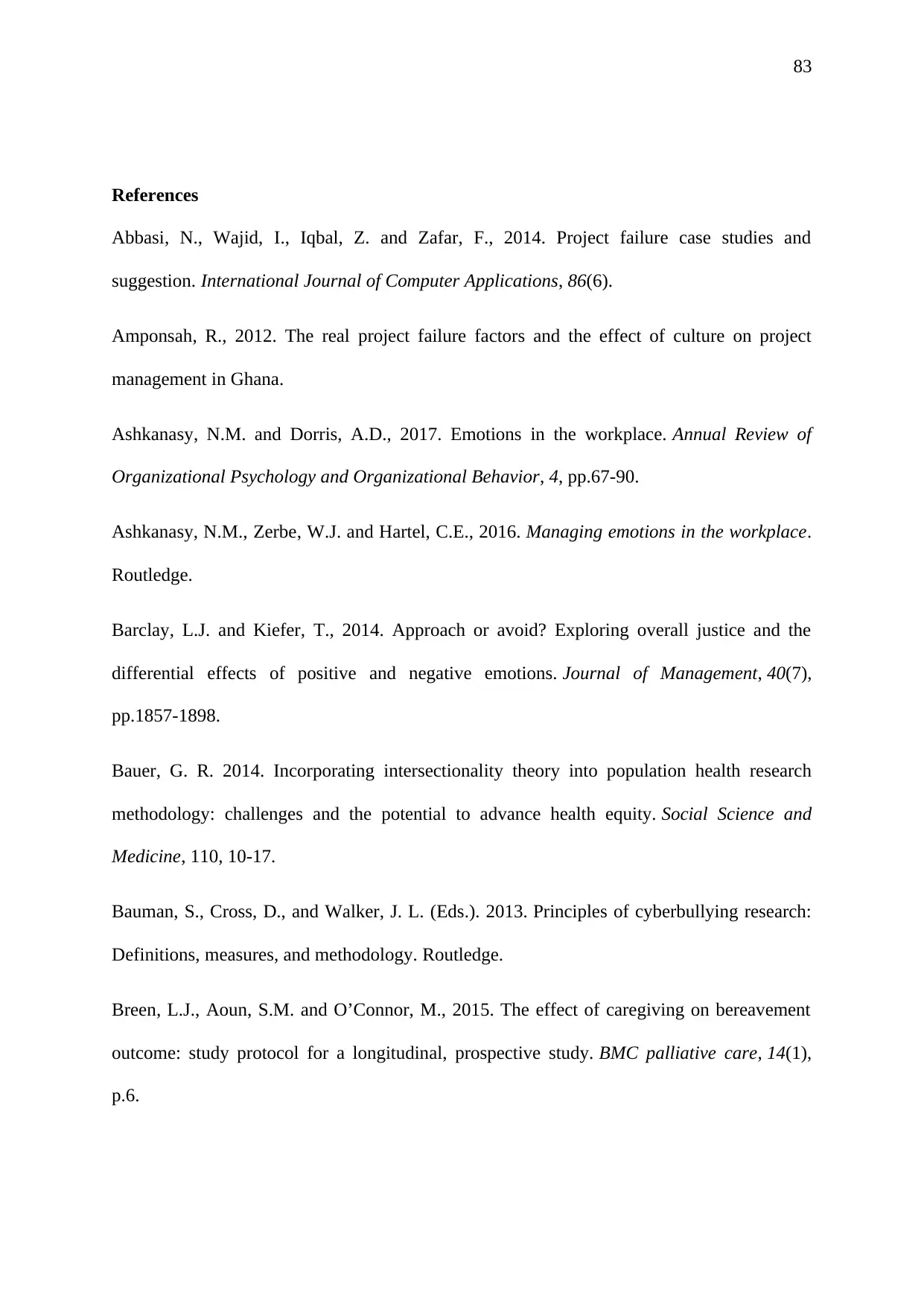
References
Abbasi, N., Wajid, I., Iqbal, Z. and Zafar, F., 2014. Project failure case studies and
suggestion. International Journal of Computer Applications, 86(6).
Amponsah, R., 2012. The real project failure factors and the effect of culture on project
management in Ghana.
Ashkanasy, N.M. and Dorris, A.D., 2017. Emotions in the workplace. Annual Review of
Organizational Psychology and Organizational Behavior, 4, pp.67-90.
Ashkanasy, N.M., Zerbe, W.J. and Hartel, C.E., 2016. Managing emotions in the workplace.
Routledge.
Barclay, L.J. and Kiefer, T., 2014. Approach or avoid? Exploring overall justice and the
differential effects of positive and negative emotions. Journal of Management, 40(7),
pp.1857-1898.
Bauer, G. R. 2014. Incorporating intersectionality theory into population health research
methodology: challenges and the potential to advance health equity. Social Science and
Medicine, 110, 10-17.
Bauman, S., Cross, D., and Walker, J. L. (Eds.). 2013. Principles of cyberbullying research:
Definitions, measures, and methodology. Routledge.
Breen, L.J., Aoun, S.M. and O’Connor, M., 2015. The effect of caregiving on bereavement
outcome: study protocol for a longitudinal, prospective study. BMC palliative care, 14(1),
p.6.
You're viewing a preview
Unlock full access by subscribing today!
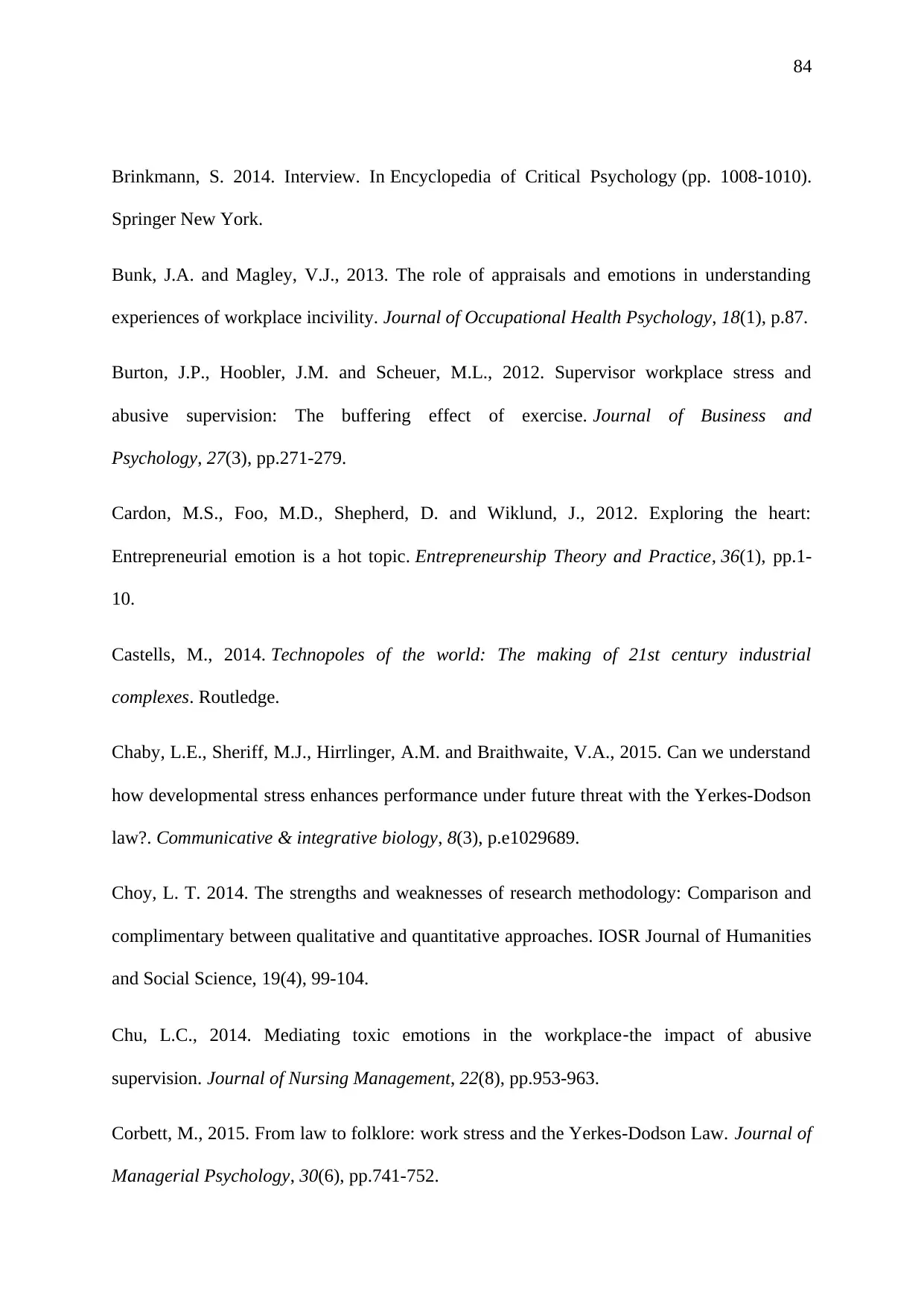
Brinkmann, S. 2014. Interview. In Encyclopedia of Critical Psychology (pp. 1008-1010).
Springer New York.
Bunk, J.A. and Magley, V.J., 2013. The role of appraisals and emotions in understanding
experiences of workplace incivility. Journal of Occupational Health Psychology, 18(1), p.87.
Burton, J.P., Hoobler, J.M. and Scheuer, M.L., 2012. Supervisor workplace stress and
abusive supervision: The buffering effect of exercise. Journal of Business and
Psychology, 27(3), pp.271-279.
Cardon, M.S., Foo, M.D., Shepherd, D. and Wiklund, J., 2012. Exploring the heart:
Entrepreneurial emotion is a hot topic. Entrepreneurship Theory and Practice, 36(1), pp.1-
10.
Castells, M., 2014. Technopoles of the world: The making of 21st century industrial
complexes. Routledge.
Chaby, L.E., Sheriff, M.J., Hirrlinger, A.M. and Braithwaite, V.A., 2015. Can we understand
how developmental stress enhances performance under future threat with the Yerkes-Dodson
law?. Communicative & integrative biology, 8(3), p.e1029689.
Choy, L. T. 2014. The strengths and weaknesses of research methodology: Comparison and
complimentary between qualitative and quantitative approaches. IOSR Journal of Humanities
and Social Science, 19(4), 99-104.
Chu, L.C., 2014. Mediating toxic emotions in the workplace‐the impact of abusive
supervision. Journal of Nursing Management, 22(8), pp.953-963.
Corbett, M., 2015. From law to folklore: work stress and the Yerkes-Dodson Law. Journal of
Managerial Psychology, 30(6), pp.741-752.
Paraphrase This Document
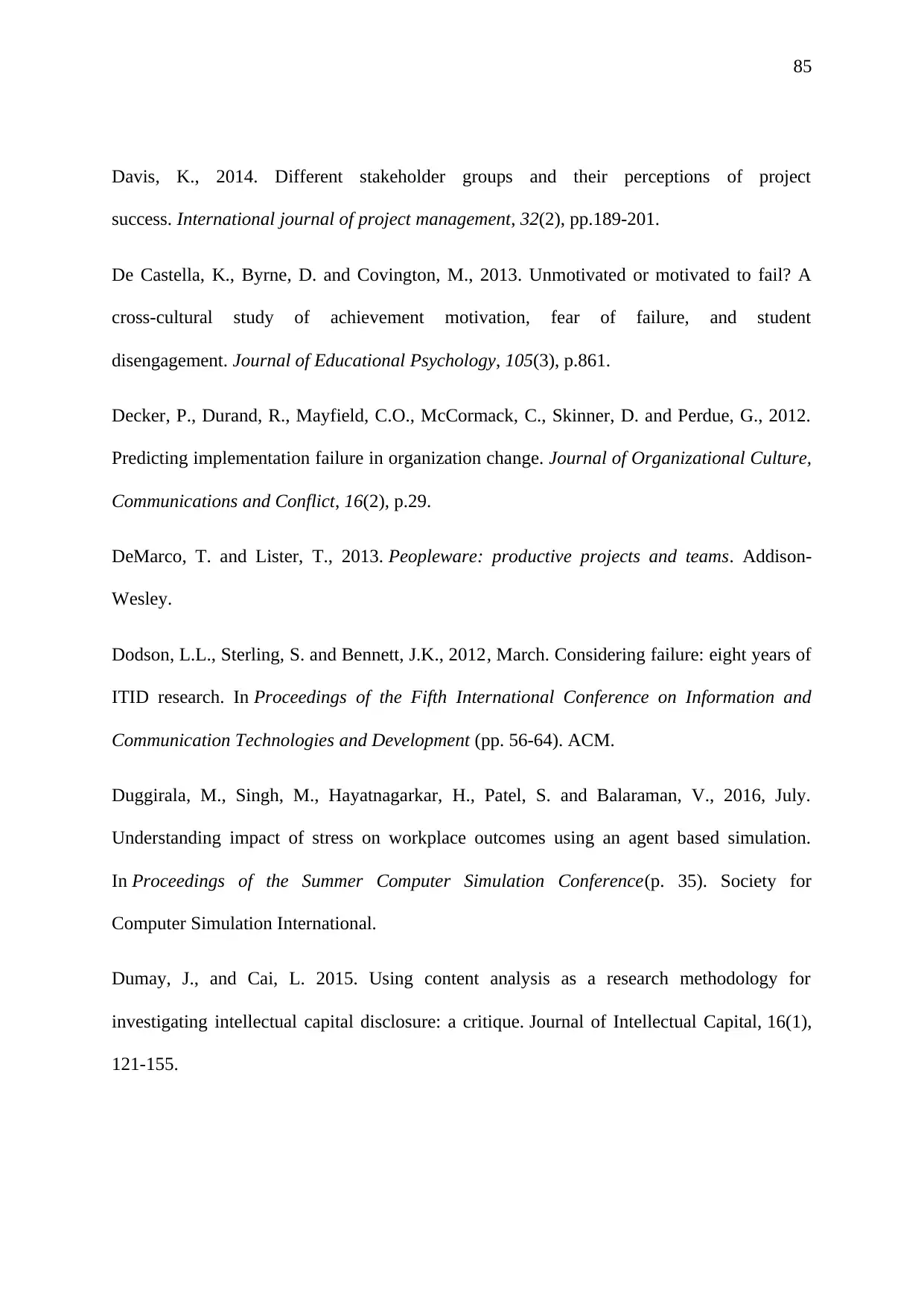
Davis, K., 2014. Different stakeholder groups and their perceptions of project
success. International journal of project management, 32(2), pp.189-201.
De Castella, K., Byrne, D. and Covington, M., 2013. Unmotivated or motivated to fail? A
cross-cultural study of achievement motivation, fear of failure, and student
disengagement. Journal of Educational Psychology, 105(3), p.861.
Decker, P., Durand, R., Mayfield, C.O., McCormack, C., Skinner, D. and Perdue, G., 2012.
Predicting implementation failure in organization change. Journal of Organizational Culture,
Communications and Conflict, 16(2), p.29.
DeMarco, T. and Lister, T., 2013. Peopleware: productive projects and teams. Addison-
Wesley.
Dodson, L.L., Sterling, S. and Bennett, J.K., 2012, March. Considering failure: eight years of
ITID research. In Proceedings of the Fifth International Conference on Information and
Communication Technologies and Development (pp. 56-64). ACM.
Duggirala, M., Singh, M., Hayatnagarkar, H., Patel, S. and Balaraman, V., 2016, July.
Understanding impact of stress on workplace outcomes using an agent based simulation.
In Proceedings of the Summer Computer Simulation Conference(p. 35). Society for
Computer Simulation International.
Dumay, J., and Cai, L. 2015. Using content analysis as a research methodology for
investigating intellectual capital disclosure: a critique. Journal of Intellectual Capital, 16(1),
121-155.
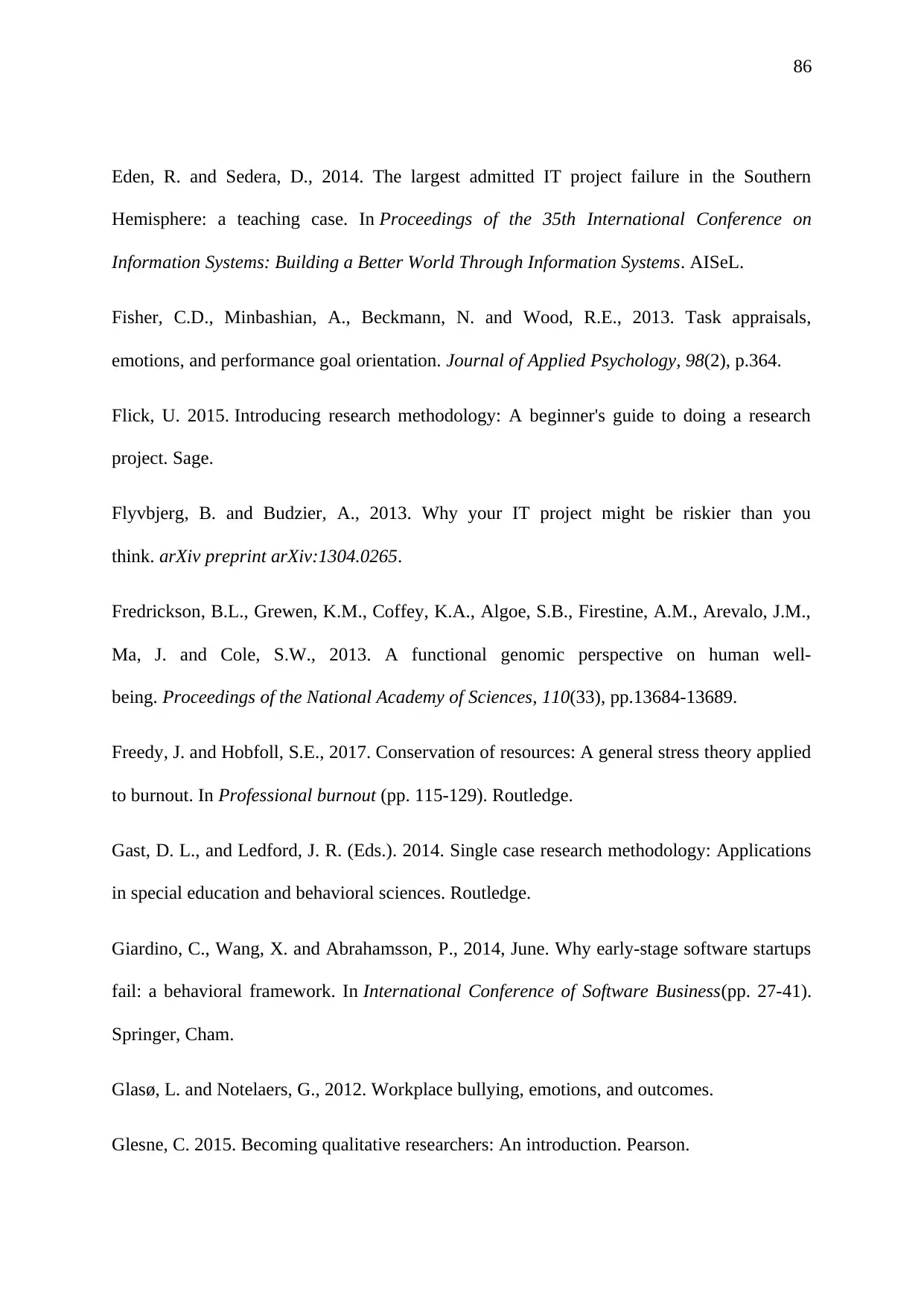
Eden, R. and Sedera, D., 2014. The largest admitted IT project failure in the Southern
Hemisphere: a teaching case. In Proceedings of the 35th International Conference on
Information Systems: Building a Better World Through Information Systems. AISeL.
Fisher, C.D., Minbashian, A., Beckmann, N. and Wood, R.E., 2013. Task appraisals,
emotions, and performance goal orientation. Journal of Applied Psychology, 98(2), p.364.
Flick, U. 2015. Introducing research methodology: A beginner's guide to doing a research
project. Sage.
Flyvbjerg, B. and Budzier, A., 2013. Why your IT project might be riskier than you
think. arXiv preprint arXiv:1304.0265.
Fredrickson, B.L., Grewen, K.M., Coffey, K.A., Algoe, S.B., Firestine, A.M., Arevalo, J.M.,
Ma, J. and Cole, S.W., 2013. A functional genomic perspective on human well-
being. Proceedings of the National Academy of Sciences, 110(33), pp.13684-13689.
Freedy, J. and Hobfoll, S.E., 2017. Conservation of resources: A general stress theory applied
to burnout. In Professional burnout (pp. 115-129). Routledge.
Gast, D. L., and Ledford, J. R. (Eds.). 2014. Single case research methodology: Applications
in special education and behavioral sciences. Routledge.
Giardino, C., Wang, X. and Abrahamsson, P., 2014, June. Why early-stage software startups
fail: a behavioral framework. In International Conference of Software Business(pp. 27-41).
Springer, Cham.
Glasø, L. and Notelaers, G., 2012. Workplace bullying, emotions, and outcomes.
Glesne, C. 2015. Becoming qualitative researchers: An introduction. Pearson.
You're viewing a preview
Unlock full access by subscribing today!

Gold, B. and Vassell, C., 2015, November. Using risk management to balance agile methods:
A study of the Scrum process. In Knowledge-Based Engineering and Innovation (KBEI),
2015 2nd International Conference on (pp. 49-54). IEEE.
Han, S., Kuruzovich, J. and Ravichandran, T., 2013. Service expansion of product firms in
the information technology industry: An empirical study. Journal of Management
Information Systems, 29(4), pp.127-158.
Harrison, F. and Lock, D., 2017. Advanced project management: a structured approach.
Routledge.
Heagney, J., 2016. Fundamentals of project management. Amacom.
Hogan, N.S. and Schmidt, L.A., 2016. Hogan Grief Reactions Checklist (HGRC). Techniques
of grief therapy: Assessment and intervention, pp.39-45.
Hughes, D.L., Dwivedi, Y.K., Simintiras, A.C. and Rana, N.P., 2016. Project failure and its
contributing factors. In Success and failure of IS/IT projects (pp. 3-25). Springer, Cham.
It-cortex.com 2018. Project Failure Statistics. [online] It-cortex.com. Available at:
http://www.it-cortex.com/Stat_Failure_Cause.html [Accessed 13 Oct. 2018].
Johnson, G. and Connelly, S., 2014. Negative emotions in informal feedback: The benefits of
disappointment and drawbacks of anger. Human Relations, 67(10), pp.1265-1290.
Kendrick, T., 2015. Identifying and managing project risk: essential tools for failure-
proofing your project. Amacom.
Kerzner, H., 2014. Project recovery: Case studies and techniques for overcoming project
failure. John Wiley & Sons.
Paraphrase This Document
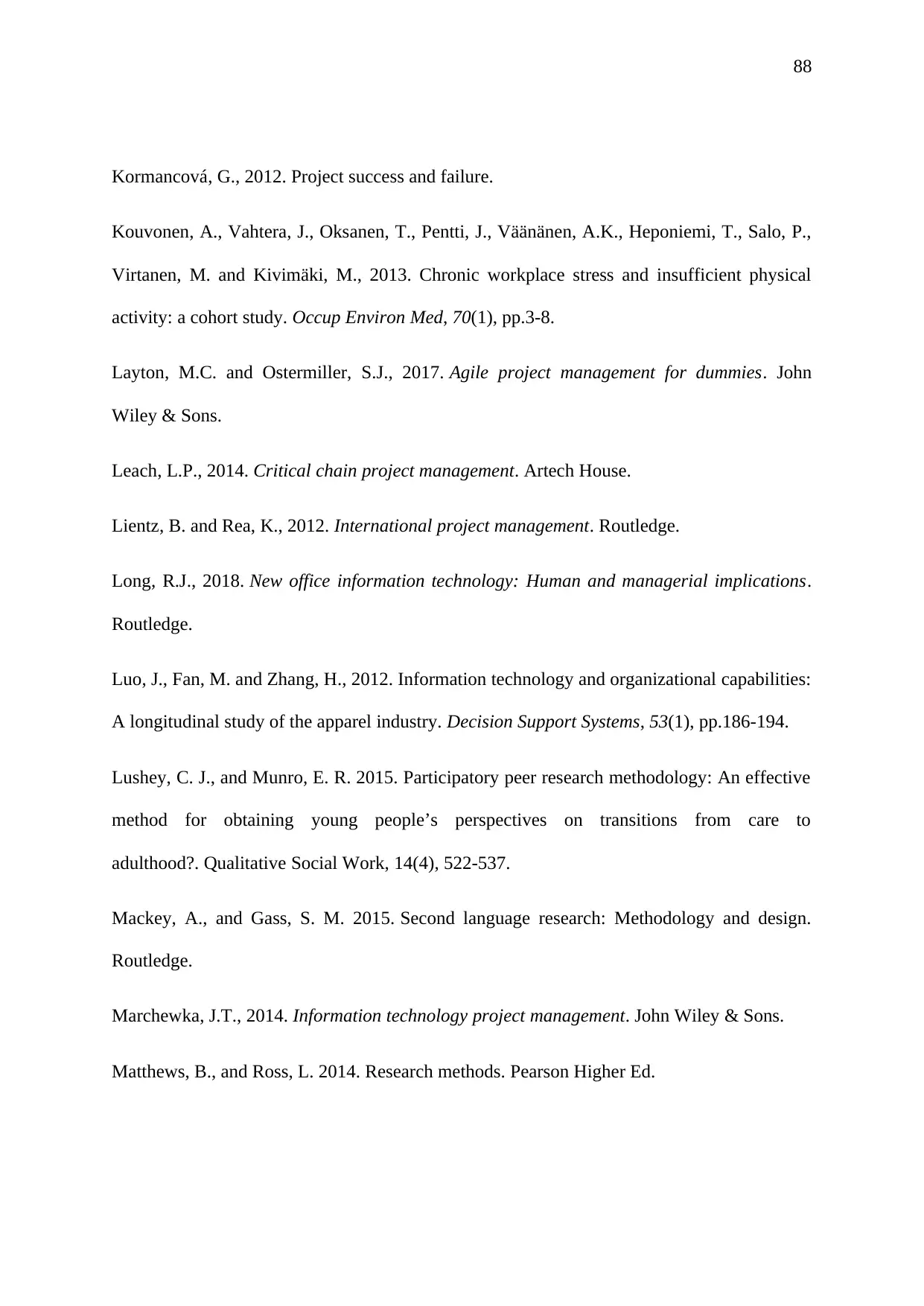
Kormancová, G., 2012. Project success and failure.
Kouvonen, A., Vahtera, J., Oksanen, T., Pentti, J., Väänänen, A.K., Heponiemi, T., Salo, P.,
Virtanen, M. and Kivimäki, M., 2013. Chronic workplace stress and insufficient physical
activity: a cohort study. Occup Environ Med, 70(1), pp.3-8.
Layton, M.C. and Ostermiller, S.J., 2017. Agile project management for dummies. John
Wiley & Sons.
Leach, L.P., 2014. Critical chain project management. Artech House.
Lientz, B. and Rea, K., 2012. International project management. Routledge.
Long, R.J., 2018. New office information technology: Human and managerial implications.
Routledge.
Luo, J., Fan, M. and Zhang, H., 2012. Information technology and organizational capabilities:
A longitudinal study of the apparel industry. Decision Support Systems, 53(1), pp.186-194.
Lushey, C. J., and Munro, E. R. 2015. Participatory peer research methodology: An effective
method for obtaining young people’s perspectives on transitions from care to
adulthood?. Qualitative Social Work, 14(4), 522-537.
Mackey, A., and Gass, S. M. 2015. Second language research: Methodology and design.
Routledge.
Marchewka, J.T., 2014. Information technology project management. John Wiley & Sons.
Matthews, B., and Ross, L. 2014. Research methods. Pearson Higher Ed.
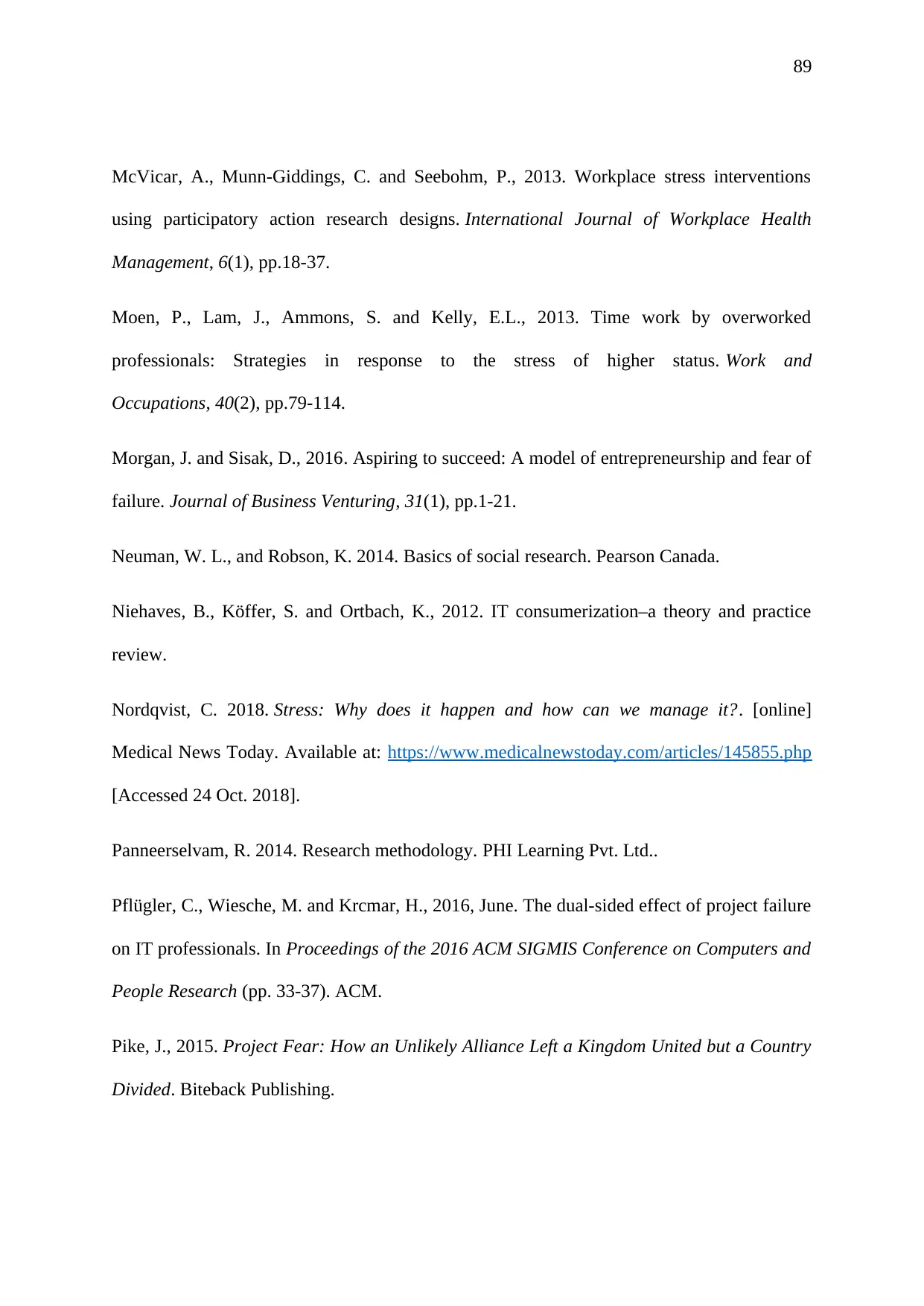
McVicar, A., Munn-Giddings, C. and Seebohm, P., 2013. Workplace stress interventions
using participatory action research designs. International Journal of Workplace Health
Management, 6(1), pp.18-37.
Moen, P., Lam, J., Ammons, S. and Kelly, E.L., 2013. Time work by overworked
professionals: Strategies in response to the stress of higher status. Work and
Occupations, 40(2), pp.79-114.
Morgan, J. and Sisak, D., 2016. Aspiring to succeed: A model of entrepreneurship and fear of
failure. Journal of Business Venturing, 31(1), pp.1-21.
Neuman, W. L., and Robson, K. 2014. Basics of social research. Pearson Canada.
Niehaves, B., Köffer, S. and Ortbach, K., 2012. IT consumerization–a theory and practice
review.
Nordqvist, C. 2018. Stress: Why does it happen and how can we manage it?. [online]
Medical News Today. Available at: https://www.medicalnewstoday.com/articles/145855.php
[Accessed 24 Oct. 2018].
Panneerselvam, R. 2014. Research methodology. PHI Learning Pvt. Ltd..
Pflügler, C., Wiesche, M. and Krcmar, H., 2016, June. The dual-sided effect of project failure
on IT professionals. In Proceedings of the 2016 ACM SIGMIS Conference on Computers and
People Research (pp. 33-37). ACM.
Pike, J., 2015. Project Fear: How an Unlikely Alliance Left a Kingdom United but a Country
Divided. Biteback Publishing.
You're viewing a preview
Unlock full access by subscribing today!

Pines, A.M., 2017. Burnout: An existential perspective. In Professional burnout (pp. 33-51).
Routledge.
Reynolds, D., Creemers, B., Nesselrodt, P. S., Shaffer, E. C., Stringfield, S., and Teddlie, C.
(Eds.). 2014. Advances in school effectiveness research and practice. Elsevier.
Shepherd, D.A., Haynie, J.M. and Patzelt, H., 2013. Project failures arising from corporate
entrepreneurship: Impact of multiple project failures on employees' accumulated emotions,
learning, and motivation. Journal of Product Innovation Management, 30(5), pp.880-895.
Shepherd, D.A., Patzelt, H., Williams, T.A. and Warnecke, D., 2014. How does project
termination impact project team members? Rapid termination,‘creeping death’, and learning
from failure. Journal of Management Studies, 51(4), pp.513-546.
Silverman, D. (Ed.). 2016. Qualitative research. Sage.
Smith, J. A. (Ed.). 2015. Qualitative psychology: A practical guide to research methods.
Sage.
Stanko, M.A. and Olleros, X., 2013. Industry growth and the knowledge spillover regime:
Does outsourcing harm innovativeness but help profit?. Journal of Business
Research, 66(10), pp.2007-2016.
Statista.com 2018. Reasons for software project failure globally 2015 | Statistic. [online]
Statista. Available at: https://www.statista.com/statistics/627648/worldwide-software-
developer-survey-project-failure/ [Accessed 13 Oct. 2018].
Stoica, R. and Brouse, P., 2013. IT project failure: A proposed four-phased adaptive multi-
method approach. Procedia Computer Science, 16, pp.728-736.
Paraphrase This Document
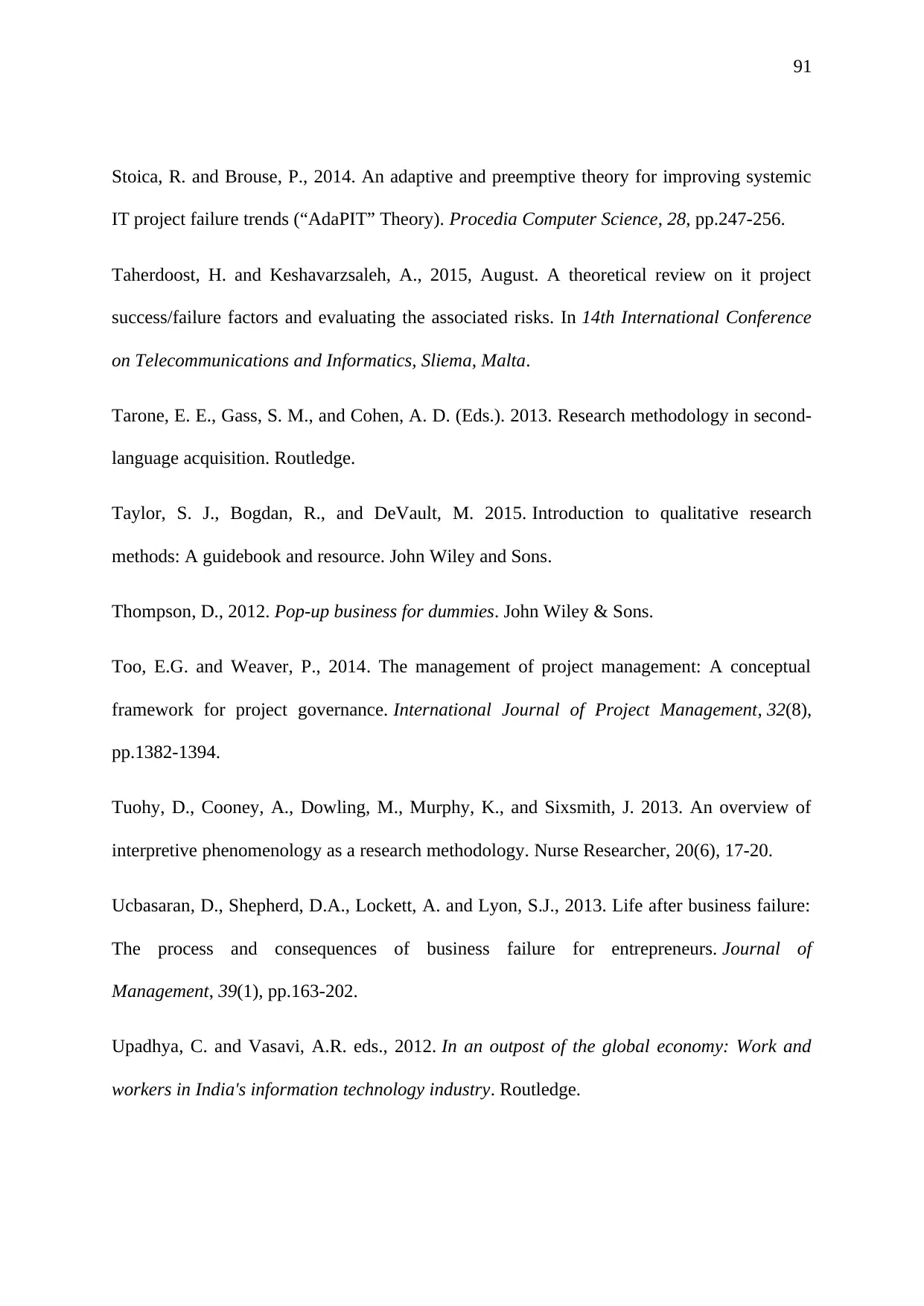
Stoica, R. and Brouse, P., 2014. An adaptive and preemptive theory for improving systemic
IT project failure trends (“AdaPIT” Theory). Procedia Computer Science, 28, pp.247-256.
Taherdoost, H. and Keshavarzsaleh, A., 2015, August. A theoretical review on it project
success/failure factors and evaluating the associated risks. In 14th International Conference
on Telecommunications and Informatics, Sliema, Malta.
Tarone, E. E., Gass, S. M., and Cohen, A. D. (Eds.). 2013. Research methodology in second-
language acquisition. Routledge.
Taylor, S. J., Bogdan, R., and DeVault, M. 2015. Introduction to qualitative research
methods: A guidebook and resource. John Wiley and Sons.
Thompson, D., 2012. Pop-up business for dummies. John Wiley & Sons.
Too, E.G. and Weaver, P., 2014. The management of project management: A conceptual
framework for project governance. International Journal of Project Management, 32(8),
pp.1382-1394.
Tuohy, D., Cooney, A., Dowling, M., Murphy, K., and Sixsmith, J. 2013. An overview of
interpretive phenomenology as a research methodology. Nurse Researcher, 20(6), 17-20.
Ucbasaran, D., Shepherd, D.A., Lockett, A. and Lyon, S.J., 2013. Life after business failure:
The process and consequences of business failure for entrepreneurs. Journal of
Management, 39(1), pp.163-202.
Upadhya, C. and Vasavi, A.R. eds., 2012. In an outpost of the global economy: Work and
workers in India's information technology industry. Routledge.
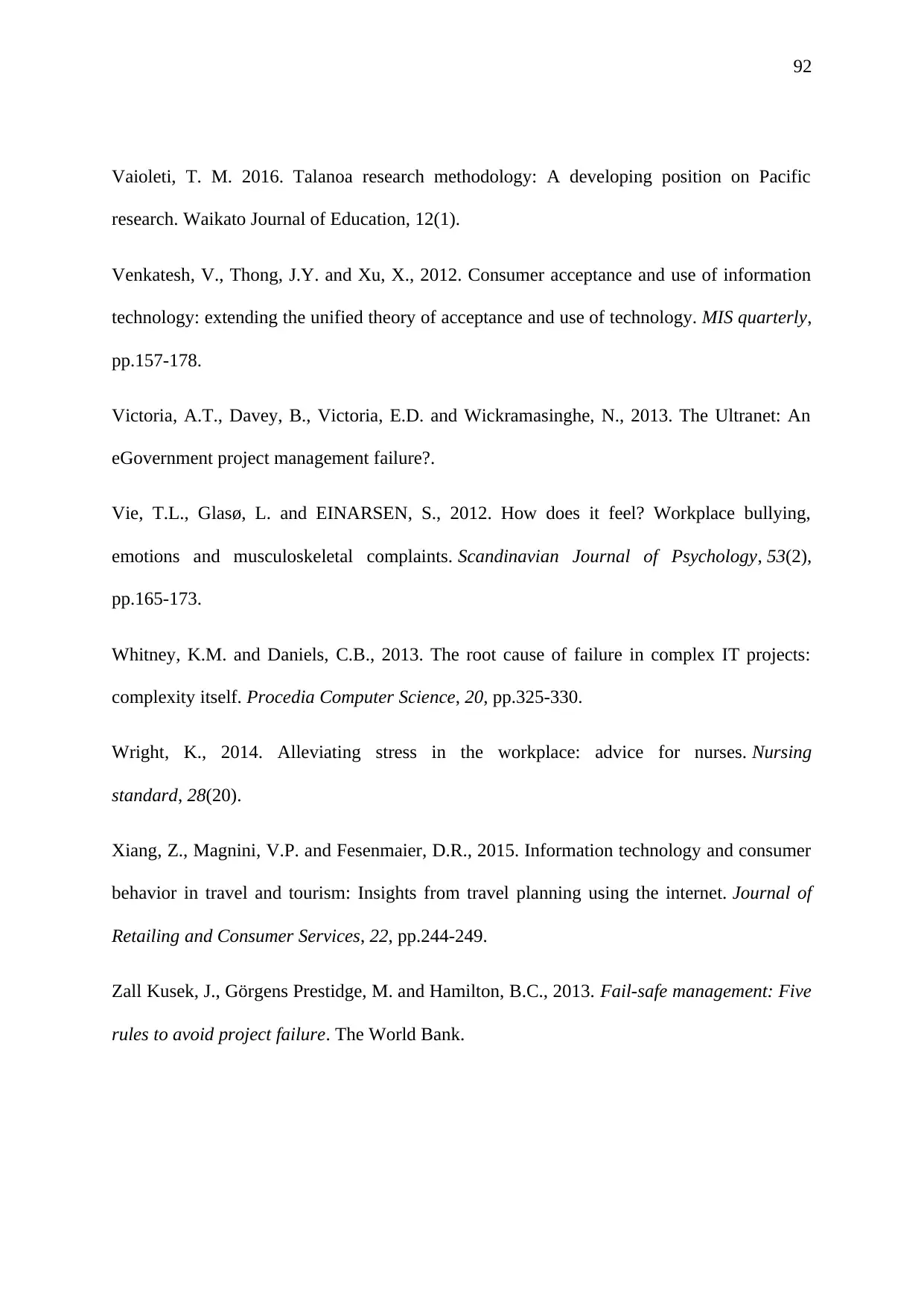
Vaioleti, T. M. 2016. Talanoa research methodology: A developing position on Pacific
research. Waikato Journal of Education, 12(1).
Venkatesh, V., Thong, J.Y. and Xu, X., 2012. Consumer acceptance and use of information
technology: extending the unified theory of acceptance and use of technology. MIS quarterly,
pp.157-178.
Victoria, A.T., Davey, B., Victoria, E.D. and Wickramasinghe, N., 2013. The Ultranet: An
eGovernment project management failure?.
Vie, T.L., Glasø, L. and EINARSEN, S., 2012. How does it feel? Workplace bullying,
emotions and musculoskeletal complaints. Scandinavian Journal of Psychology, 53(2),
pp.165-173.
Whitney, K.M. and Daniels, C.B., 2013. The root cause of failure in complex IT projects:
complexity itself. Procedia Computer Science, 20, pp.325-330.
Wright, K., 2014. Alleviating stress in the workplace: advice for nurses. Nursing
standard, 28(20).
Xiang, Z., Magnini, V.P. and Fesenmaier, D.R., 2015. Information technology and consumer
behavior in travel and tourism: Insights from travel planning using the internet. Journal of
Retailing and Consumer Services, 22, pp.244-249.
Zall Kusek, J., Görgens Prestidge, M. and Hamilton, B.C., 2013. Fail-safe management: Five
rules to avoid project failure. The World Bank.
You're viewing a preview
Unlock full access by subscribing today!

Appendix
Survey Questionnaire
Age
A. 30 – 35 years
B. 35 – 40 years
C. 40 – 45 years
D. 45 – 50 years
E. More than 50 years
Gender
A. Male
B. Female
Work experience in the current workplace
A. 2 – 3 years
B. 3 – 4 years
C. 4 – 5 years
D. More than 5 years
Are you currently handling any project
A. Yes
B. No
Have you previously handled any it project
A. Yes
B. No
You have succeeded in most of your projects
A. Strongly Agree
B. Agree
C. Neutral
D. Disagree
E. Strongly disagree
Negative emotions are common in managing projects
Paraphrase This Document
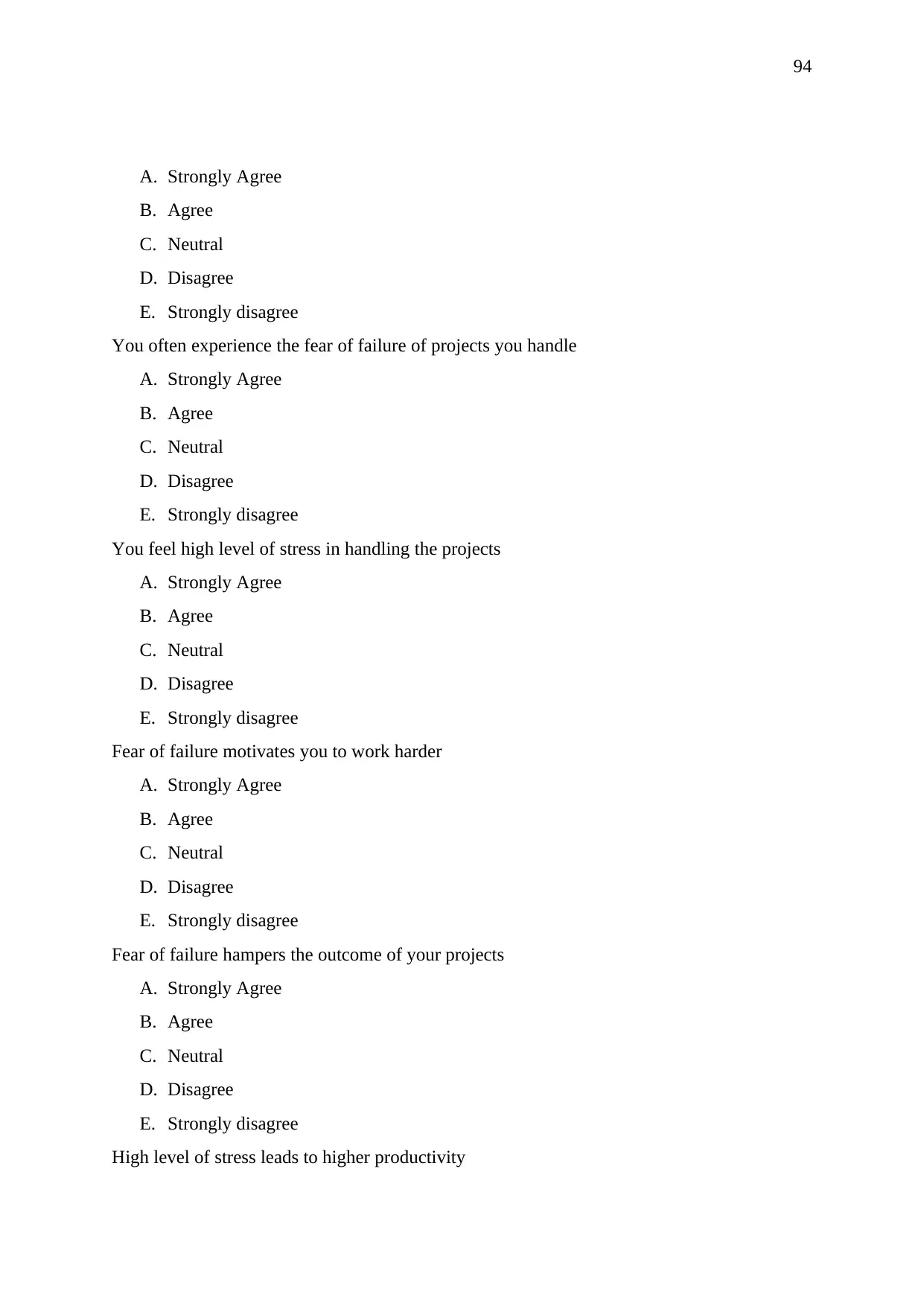
A. Strongly Agree
B. Agree
C. Neutral
D. Disagree
E. Strongly disagree
You often experience the fear of failure of projects you handle
A. Strongly Agree
B. Agree
C. Neutral
D. Disagree
E. Strongly disagree
You feel high level of stress in handling the projects
A. Strongly Agree
B. Agree
C. Neutral
D. Disagree
E. Strongly disagree
Fear of failure motivates you to work harder
A. Strongly Agree
B. Agree
C. Neutral
D. Disagree
E. Strongly disagree
Fear of failure hampers the outcome of your projects
A. Strongly Agree
B. Agree
C. Neutral
D. Disagree
E. Strongly disagree
High level of stress leads to higher productivity
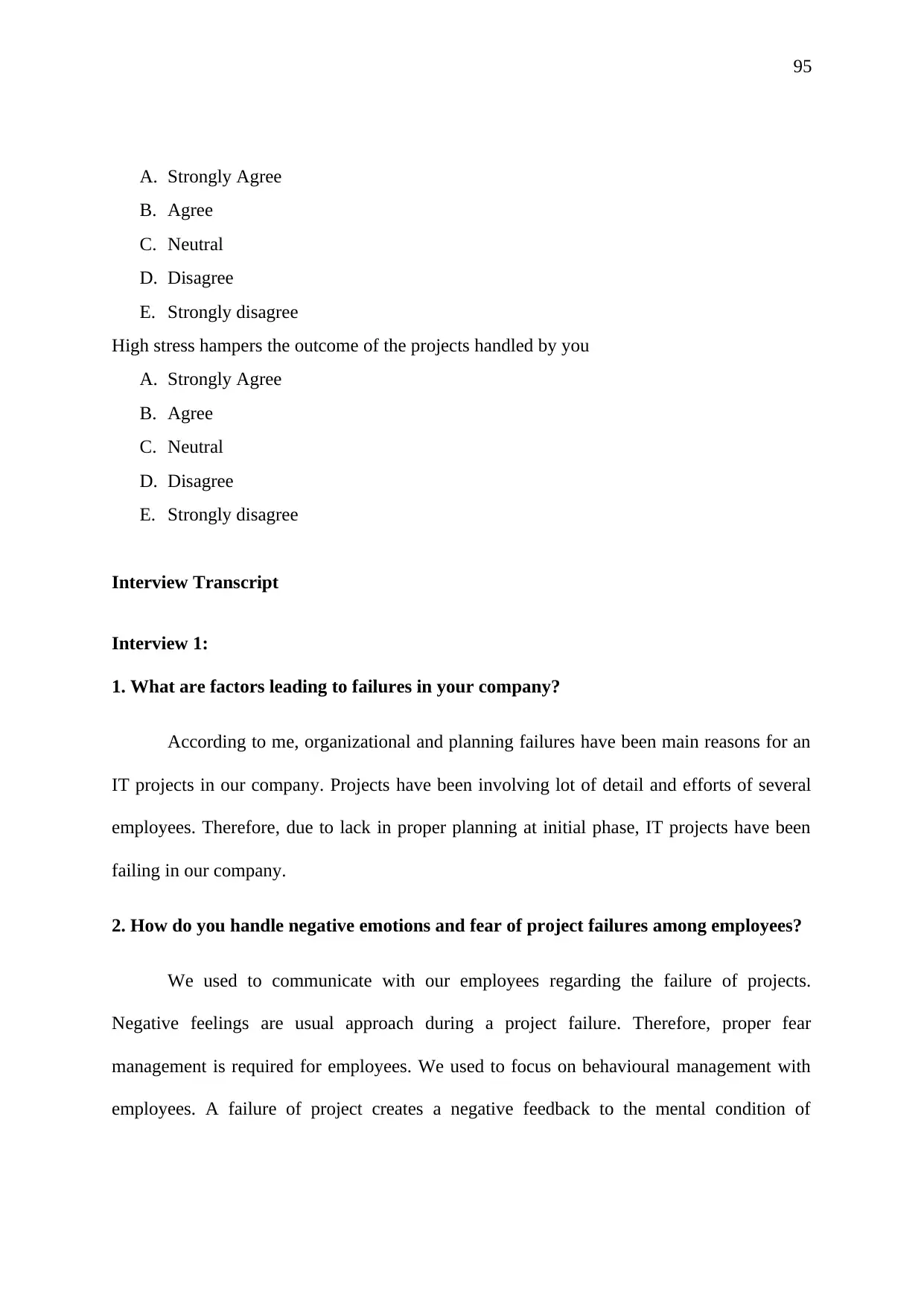
A. Strongly Agree
B. Agree
C. Neutral
D. Disagree
E. Strongly disagree
High stress hampers the outcome of the projects handled by you
A. Strongly Agree
B. Agree
C. Neutral
D. Disagree
E. Strongly disagree
Interview Transcript
Interview 1:
1. What are factors leading to failures in your company?
According to me, organizational and planning failures have been main reasons for an
IT projects in our company. Projects have been involving lot of detail and efforts of several
employees. Therefore, due to lack in proper planning at initial phase, IT projects have been
failing in our company.
2. How do you handle negative emotions and fear of project failures among employees?
We used to communicate with our employees regarding the failure of projects.
Negative feelings are usual approach during a project failure. Therefore, proper fear
management is required for employees. We used to focus on behavioural management with
employees. A failure of project creates a negative feedback to the mental condition of
You're viewing a preview
Unlock full access by subscribing today!
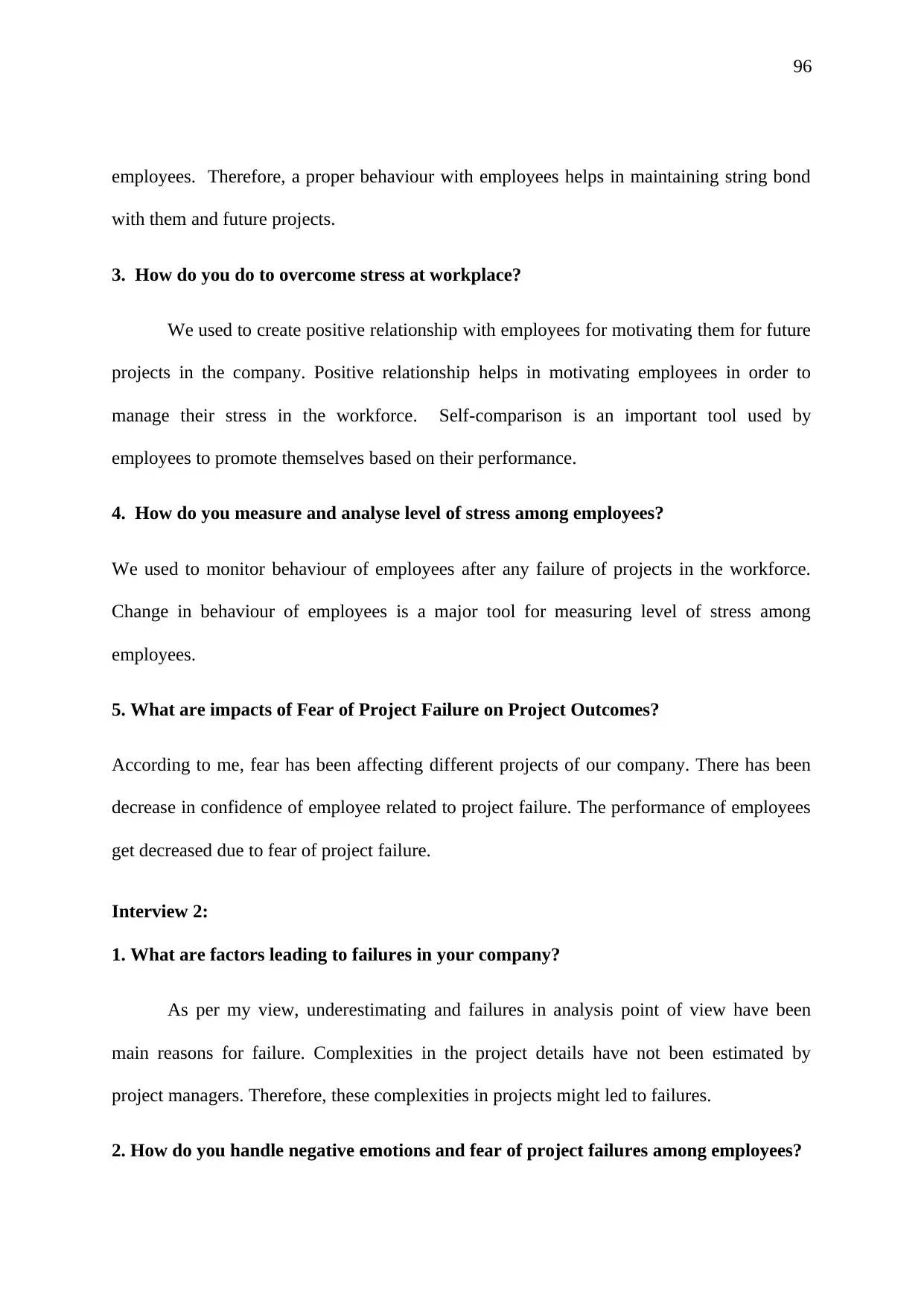
employees. Therefore, a proper behaviour with employees helps in maintaining string bond
with them and future projects.
3. How do you do to overcome stress at workplace?
We used to create positive relationship with employees for motivating them for future
projects in the company. Positive relationship helps in motivating employees in order to
manage their stress in the workforce. Self-comparison is an important tool used by
employees to promote themselves based on their performance.
4. How do you measure and analyse level of stress among employees?
We used to monitor behaviour of employees after any failure of projects in the workforce.
Change in behaviour of employees is a major tool for measuring level of stress among
employees.
5. What are impacts of Fear of Project Failure on Project Outcomes?
According to me, fear has been affecting different projects of our company. There has been
decrease in confidence of employee related to project failure. The performance of employees
get decreased due to fear of project failure.
Interview 2:
1. What are factors leading to failures in your company?
As per my view, underestimating and failures in analysis point of view have been
main reasons for failure. Complexities in the project details have not been estimated by
project managers. Therefore, these complexities in projects might led to failures.
2. How do you handle negative emotions and fear of project failures among employees?
Paraphrase This Document

According to me, leadership and governance failures have been main causes for
project failure in the company. Due to lack in proper guidance and leadership, various
methods in projects have not been handled properly by employees engaged in particular
projects. We used to revise goals of employees so that they are able to meet their goals.
Therefore, meeting small goals of every employees might help in making a successful
project.
3. How do you do to overcome stress at workplace?
We used to prioritize work loads of employees and have a routine framework for
employees. Work breakdown helps in reducing pressure from employees at workplace.
Prioritizing work helps in minimizing stress among employees.
4. How do you measure and analyse level of stress among employees?
We used to create checklists of measuring level of stress among employees in the workforce.
These checklist are prepared in the basis of data collected from survey among employees.
Several steps are taken for minimizing the stress level among employees.
5. What are impacts of Fear of Project Failure on Project Outcomes?
There has been various adverse effect in our workforce due to fear of project failure.
However, this has been also created a positive impact related to increase in motivation for
enhancing their performance in future projects. We used to identify problems in failed
projects and analyse it to improve next projects.
Related Documents
Your All-in-One AI-Powered Toolkit for Academic Success.
+13062052269
info@desklib.com
Available 24*7 on WhatsApp / Email
![[object Object]](/_next/static/media/star-bottom.7253800d.svg)
© 2024 | Zucol Services PVT LTD | All rights reserved.




